Best Technologies for ERP Development | React ERP | Angular ERP
ERP is an integrated software application that standardizes and streamlines business processes to improve productivity and efficiency, improve internal and external communication, and offer easy access to information to make business decisions. It integrates business processes across all business functions, including accounting, finance, human resources, purchasing & procurement, distribution, manufacturing, warehousing, inventory management, sales, and other departments. Enterprise Resource Planning (ERP) systems operate on an integrated software platform using standard data definitions working on a single database.
Manufacturing companies designed and leveraged Enterprise Resource Planning to drive operational efficiencies. All industries, including Wholesales and Distribution Industry, Retailers, B2B and B2C eCommerce, service industries, education, hospitality, health care, financial services, and government have adapted and leveraged ERP concepts to streamline and integrate business processes to stay competitive
The initial steps to integrate business processes with technology started in the 60s with Inventory Control (IC) applications. These early applications were developed in COBOL or Fortran (Two primary computer languages). Suppose you are designing Enterprise resource planning ERP or exploring the Next Generation of ERP. In that case, please explore Angular & React for frontend ERP technologies, API, and Microservices as middleware for easy integration with in-housed build solutions, cloud and Hybrid systems, and Java as backend. Regarding Databases, one has many options from MS SQL, MySQL, IBM DB2, ORACLE SQL, Postgre SQL, etc.
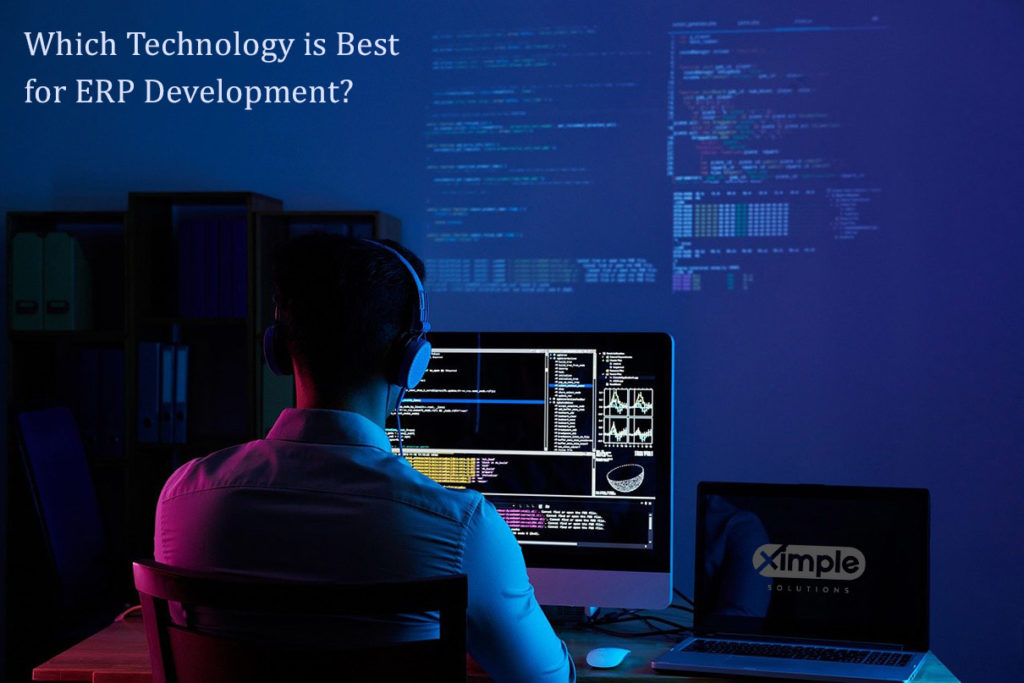
Table of Contents
- What is Angular & React Technologies for ERP?
- Similarities and Differences Angular vs. React in ERP Development
- Benefits of Angular Technology for ERP System
- What’s the API framework? What are Micro-services?
- What are best framework for ERP in Java?
- ERP Framework: J2EE vs. Spring
- Benefits of J2EE Framework
- Foundation for future
- Risk-Free Technology for Next Generation ERP- Angular, APIs, Microservices, and J2EE
- Conclusion
What are Angular & React Technologies for ERP?
Angular or Angular 2.0 is an open-source JavaScript framework that emerged in September 2016. The Angular Team from Google and the Angular developer community run the framework. Angular software architecture is for doing web and mobile development. It is an amendment of Angular 1.0 or AngularJS that launched in 2010. Until now, six editions of the Angular JavaScript framework exist.
React is a JavaScript Library ideal for UI development. It aids the development of user interfaces. The team behind React development and administration is Facebook’s community of developers. React came to be in May 2013 and has been used in various projects, including the React ERP.
We will describe and compare Angular and React to help you understand them well. Additionally, we will reveal different types of Java frameworks. So, welcome, and keep on reading.
Similarities and Differences Angular vs. React in ERP Development
Are angular and React similar? Yes, they are alike in that they are both programming languages. They are more different than they are alike, however. Brief differences between them include:
- While angular is a complete framework with everything, React is only a Javascript library. It came before Angular, so it is a lot older than Angular.
- Ease of learning – It is harder to learn Angular as a novice, and it calls for intense training in Angular school. In contrast, React JS is easier to understand if it is the only thing you want to learn. When it includes Redux, React becomes harder to grasp.
- Installation ease – You can install Angular faster than React. However, you will need more coding time with Angular and less with React. Ultimately, you can work more quickly with React to build ERP from scratch.
- Libraries – React contains other types of programming libraries. In contrast, Angular is a complete solution for the building.
- Open-source community support – Angular has a more dependable community of developers. React does offer community support, but it is not reliable.
- Data Binding – In angular, the data binding method is two-way. When you make any change, the model state updates automatically. On the other hand, React uses the one-way data binding method. Before you change elements, you should update the related model state.
- Debugging/testing – When testing and debugging finished a webERP software or any other in angular, you can use one tool. In contrast, you require multiple tools to debug and test a project in React.
- Versatility – React is more versatile than Angular when choosing tools, libraries, and libraries for developing an app.
- Types of apps – When you develop hybrid apps, native apps, or web apps, you should use React. On the contrary, use the Angular JS framework when developing a mobile app or a Single Page Application.
- Updates and documentation – React undergoes regular updates. The updates are easy since scripts can facilitate migration. Thus, the documentation in React is quite fast. On the contrary, Angular is an ongoing development process that affects the release of updates. They come out every six months, and this slows down documentation. Even though slow, developers tend to have time to make alterations before the migration process.
- Type of model – Angular foundation is MVC or Model View Controller. Quite the reverse, React’s model is Virtual DOM.
- Writing style – Angular uses TypeScript, while React is JavaScript.
- Application in real life – Companies that prefer Angular include Beam, Mesh, Streamline Social, Auto Trader, Wepay, and more. Top users of React are Facebook, Pinterest, Uber Technologies, Instagram, and Netflix.
- Angular uses code that offers pre-made elements for making Java an open-source ERP system, CRM, or a different software tool. But it is not possible to add a JavaScript library to a source code. React lets the developer make the code based on the format they choose. It is easy to add a JavaScript library to a source code.
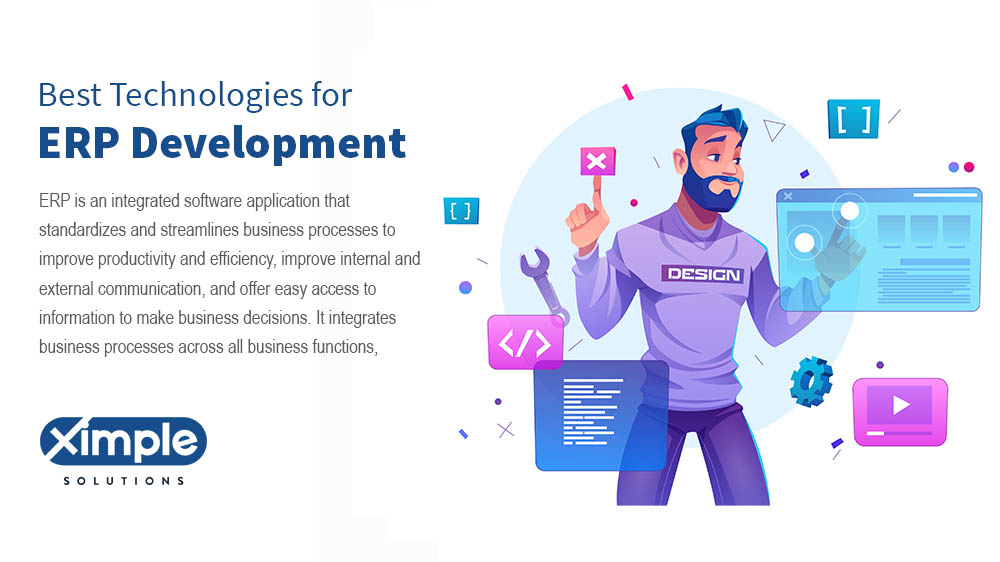
Benefits of Angular Technology for ERP Systems
If looking for high productivity when doing an ERP project in Java, choose Angular. It includes ready-to-use solutions that can let you create applications with many features. It has the following benefits:
- It supports error-free code development
- Angular is a more modern, high-performance programming language
- You can shift from one view to another because Angular allows routing
- Angular CLI facilitates seamless updates.
What’s the API framework? What are Micro-services?
The Application Programmer Interface (API) Framework is a technique that programmers use to interface with software applications. The open-ended Java API framework has many uses. When shopping online with your card, API helps to transmit your card details to complete a transaction. After integration with various company APIs, the API Framework can securely send even the most sensitive data.
Java Microservices framework includes a group of software applications designed in the Java Programming Language. They make use of the massive system of Java frameworks and tools. A single microservice boasts minimal abilities and is responsible for one specific task. That is why microservices deliver consistency, efficiency, and quality in the outputs and workflows.
What is the best framework for ERP in Java?
First of all, a Java Framework is an assortment of pre-made codes for developing web applications. It is the framework that a developer uses to write codes for creating an application. But what is a framework in Java? A framework has pre-defined classes and functions (codes) in which a developer can add their code to solve a problem. There are different kinds of Java Frameworks that can be used in ERP. The most popular ones include:
- Spring – A lightweight, easy-to-test Java framework designed for JEE.
- Hibernate – It is a portable and productive open-source Java application development framework. It allows a developer to launch communication between RDBMS and Java.
- Play – It is a unique Java Framework that follows the Java MVC framework and is ideal when making a very scalable application. It requires no configuration and works with the most common IDEs.
- Google Web Toolkit – The GWT is an open-source framework. It lets a developer write a client-side Java code. GWT is ideal for creating the most complex browse applications. They can use the GOOGLE API to do the task.
- JavaServer Faces is an Oracle Java UI framework perfect for developing user interfaces for Java applications. Like Play, it uses the MVC design method.
ERP Framework: J2EE vs. Spring
Java 2 Platform, Enterprise Edition (J2EE) belongs to Oracle. It entails Java micro-services patterns, web services, and distributed computing. It is a reliable application platform whose core components are Java Server Pages, Java Database Connectivity, and Enterprise Java Beans.
Java Spring Framework is an open-source framework for Jave EE. As it has several extensions for building large-scale apps over the Java EE platform, the Spring Framework uses Plain Old Java Object (POJO). One common thing about J2EE and Spring Framework is dependency injection. Here are the differences between J2EE and Spring Framework.
- Architecture – J2EE entails three architectural frameworks: logical tiers, client tiers, and presentation tiers. In contrast, Spring Framework consists of a layered architectural skeleton with several modules.
- Language – Spring lacks any specific programming model, while J2EE uses an advanced object-oriented language with particular syntax and design.
- Interface – Syntax in Spring Framework is the same. It does not depend on a compiler or IDE. On the contrary, J2EE is a Java GUI framework designed from Abstract Window Toolkit APIs.
- Structure – J2EE may be a web-based Java web development framework or a non-web-based one. Spring Framework’s foundation is around twenty modules.
- Swiftness – Spring Framework is slower than J2EE.
Benefits of the J2EE Framework
J2EE ERP Framework has the following advantages:
- Records show that J2EE leads to the development of more secure, reliable, and scalable Java ERP solutions.
- You can use J2EE on several platforms
- It enables cross-platform portability
- Complex, high-level applications are easy to handle over J2EE
- Several successful projects exist to show the effectiveness of J2EE.
Foundation for future
The programming languages mentioned here form a foundation for the future of ERP. They will help ERP developers create mobile-friendly software because many people access their apps on Android and iOS devices. They will also support the development of functional cloud-hosted ERP sites and modular ERP solutions for individual users.
Risk-Free Technology for Next Generation ERP- Angular, APIs, Microservices, and J2EE
What will developers use when making the next generation of Enterprise Resource Planning tools? It will most likely depend on the most advanced, risk-free ERP technologies. This article discussed Angular, APIs, Microservices, Java ee Spring framework. These ERP technologies are what programmers will exploit in the future to generate the most advanced ERP applications for the distribution sector and other industries.
JavaScript’s code compatibility is excellent. It is best for developing applications that can run client-side and server-side. It makes one of the best programming languages for business applications like ERP freeware. Java supports high UI for desktop and mobile experiences. It offers simple coding, flexibility, and compatibility with cloud solutions.
The future of ERP includes a shift to the cloud and mobile platforms, making Java a perfect programming language. ERP PHP solutions are also standard, and other viable languages are Python, SQL, and Ruby.
Conclusion
A typical software user does not know the work that goes into producing sophisticated company management software open source tools. Programmers do difficult work using most of the items discussed in this article. Now you know a thing or two about popular programming languages. When searching for the best programming language for ERP, CRM, DMS, or any other business software, check if its foundation is Angular, React, or another Java Application framework. It is just great to know because each has its pros and cons.
Posted on
What is a Distributor Management System?
This article is about the benefits of using a Distributor Management System (DMS) for distribution companies. It discusses how a DMS automates and optimizes the delivery process, helps in managing inventory and orders, and provides real-time sales analytics. It covers the benefits of using a DMS, such as improved order management, better inventory management, centralized information storage, and reduced errors. The article also compares Open-source and cloud-based DMS and mentions the role of ERP in the distribution business. The article is ideal for anyone looking to learn more about the advantages of using a DMS in a distribution company.
Distributor Management Systems (also known as DMS) has been a boon for distribution companies. This software helps you keep track of inventory, manage orders, and get products out the door in a timely manner. They also allow you to send orders to multiple fulfillment centers, which increases your capacity and improves your ability to respond to customer demand. Today, the biggest retailers use sophisticated DMSes that help them manage thousands of orders a day.
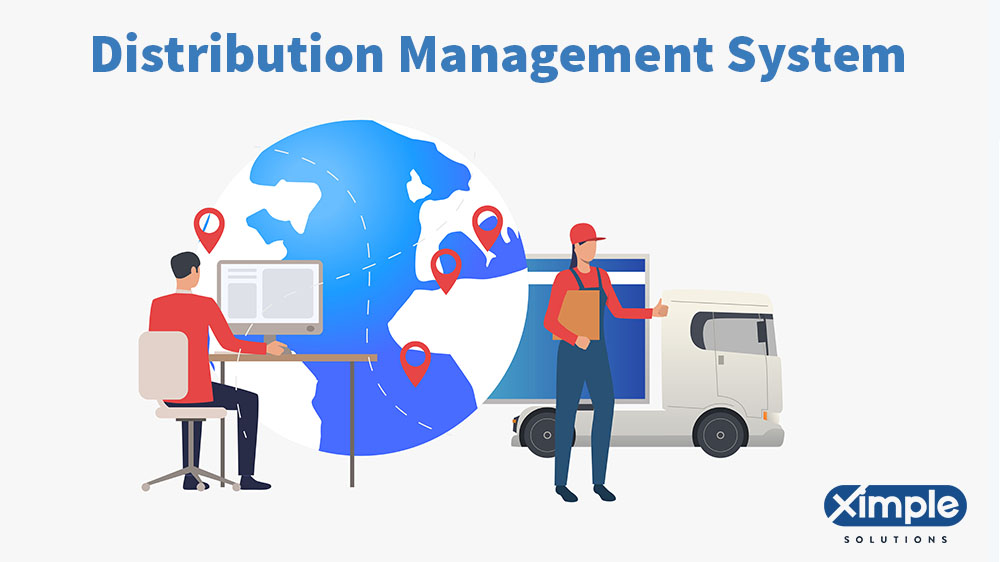
Distributor Management System is used to automate and optimize the delivery process. For example, the system can be programmed to automatically place an order with a supplier when inventory is low. This prevents a shortage and keeps customers satisfied.
The Distributor Management System is a complex network of computer systems, databases, and software applications that serves as the backbone of the supply chain, providing an integrated platform for the management of inventory and logistics operations. The DMS automates many of the manual processes that used to be handled by human hands, allowing for the rapid and efficient movement of products from the point of manufacture to the point of sale. While the DMS can seem like a black box to those on the outside, those who have had the opportunity to operate on the inside have been astounded by the power of this technology.
Table of Contents
- Challenges for Wholesalers
- Sales and Distribution business
- What is distribution management system Software?
- How it solves Distribution business challenges?
- Benefits of Distribution management Software
- Types of Distribution Management system software
- Advanced distribution management software benefits
- Similarities and differences of Open source Distribution Management Software
- Cloud-based Distribution Software: Difference and similarities of Distribution and warehouse management Software
- ERP in Distribution Management Business
- Industry 4.0
- Conclusion
Challenges for Wholesalers
Companies that have wholesale distribution operations face some challenges. Regardless of their diverse end products, all wholesalers have to cope with the following difficulties.
- Manufacturers who run efficient logistics systems do not deal with distributors. They sell directly to the end-user.
- Some retailers want to work with someone who can ensure quick distribution of goods. Hence, distributors who cannot meet delivery deadlines may have to deal with stricter penalties and fines.
- Fuel prices are always a setback when they start rising. Fuel alone makes a large part of the total operating costs of a wholesale company.
- System failures can lead to employee safety concerns concerning the storage, handling, and transportation of goods. Better distribution and warehousing management practices are necessary to prevent worker safety issues, which can be expensive.
- Centralized buying by able consumers may eventually eliminate regional wholesalers who cannot supply high volumes of goods at a lower price.
Sales and Distribution business
Companies that offer sales and distribution services generate revenue by executing sales. Therefore, they use reliable sales distribution models to reach many clients. Although their operations entail picking, packing, and shipping, they are susceptible to failure because of using the wrong sales distribution model. The model should enable you to:
- Capture the attention of your customers
- Establish a high level of trust with your customers
- Assist you in demonstrating exactly how your product can solve your customer’s problems
- Simplify the order placement and processing steps for the customers
- Enable you to ship goods on time and in good condition to ensure total customer satisfaction.
A business can choose an intensive distribution model, an exclusive distribution model, or a selective distribution model. However, the best model should facilitate the distribution process and allow a company to achieve its goals.
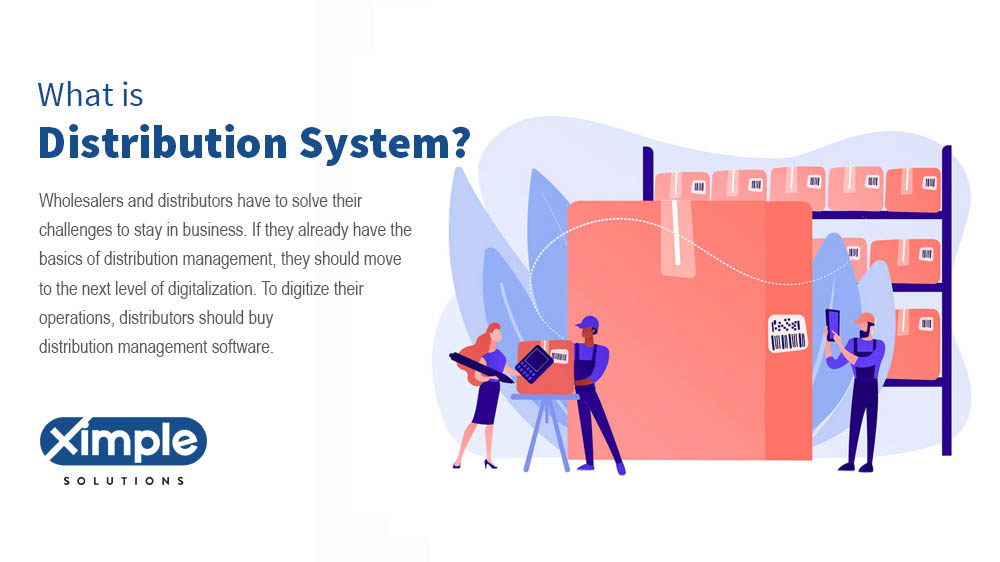
What is Distributor Management System Software?
Wholesalers and distributors have to solve their challenges to stay in business. If they already have the basics of distribution management, they should move to the next level of digitalization. To digitize their operations, distributors should buy distribution management software. Its work is to streamline distribution workflows and activities between manufacturers and distributors. A DMS tool can improve warehouse management by ensuring that the stock is not too much or too little. Whether working with a few manufacturers or many of them, distribution management system software can enhance collaboration between teams.
How does it solve Distribution business challenges?
Usually, many distributors are small-scale disorganized enterprises with inadequate capital and technology. While they know how to get new customers, they face difficulty when managing data from different manufacturers and entities. Even medium-sized and large distributors do not have actionable data on orders, claims and returns, overstocking, stock depletion, and more. Generally, poor information management due to substandard logistics infrastructure is a problem organizations can solve with network distribution software. It can solve various challenges by:
- Providing real-time sales analytics and trends
- Improve inventory management to ensure that there is no one time that you will have more stock or less stock than needed
- Improve the order management process
- Enhance scheme management
- Promote the procurement planning process
- Centralize information storage to ensure faster order processing
- Track sales and instantly present account balances and credit availability
- You can avoid errors like incomplete shipping, overcharging, missing items, and returns.
Benefits of Distributor Management System
Distribution management with software is easier, quicker, and more reliable. When using software, you can expect the following benefits:
- Order management
- Sales management
- Finance and accounting management, including accounts payable and accounts receivables.
- Inventory management including basic inventory management and logistics
- Promotion management, which includes many promotions, displays, and so on.
- Point of Sales Material management
- Performance Management for sales teams and operation teams
- Picking List Management (PLM)
- BI (business intelligence) reporting.
Types of Distribution Management System Software
Any software distribution company will face difficulty when managing inventory. Even small distributors execute several transactions every day, which makes inventory management difficult. Without the ability to track inventory, errors can happen that can lead to losses or the collapse of a business. When choosing an ideal DMS, consider the size of your company. The type of software you need will depend on whether your business is small, medium-sized, or large. The best one for a small company may be open-source software because it is free. Medium-sized and large-scale businesses can get paid software. No matter the size of your company, the best of all is ERP distribution software. ERP (enterprise resource planning) is a perfect DMS for businesses of all sizes.
Advanced distribution management software benefits
With advanced DMS, distributors can lower their costs of operations because they can avoid redundant laborers and hire the necessary quantity of workers. Besides being cost-effective, DMS is time-saving and can simply be inventory monitoring. The best types of advanced retail and distribution management software include NetSuite ERP, QuickBooks Enterprise, Ximple ERP System, and Epicor Eclipse among others.
Similarities and differences of Open source Distribution Management Software
The distributor management software Open source tools are the best for companies that have a small capital. Some open-source options are free of charge and can still improve supply chain management activities. Several open-source DMS tools are many and the similarity between them is that they are open-source applications. Concerning differences, these depend on what you want to choose.
For instance, the primary role of a tool like Apache OFBiz is warehouse management, manufacturing management, and order management. In contrast, OpenBoxes will primarily handle demand forecasting in the health sector. OpenLMIS is similar to OpenBoxes because it is a supply chain management tool for the health sector. If you struggle with inventory and purchase management, the best open-source ERP is Odoo.
As you can see, you should first compare and contrast open-source DMS tools before selecting the best. Consider factors like inventory management, order management, warehouse management, billing systems, and shipping and tracking.
Cloud-based Distribution Software: Differences and similarities of Distribution and warehouse management Software
When searching for DMS, expect to find WMS (Warehouse management software) tools online. It can help distributors cut down on labor and reduce wastage of space. Additionally, it simplifies cycle counts, tracks shipments, and monitors expiration dates, and inventory visibility. Whether you get standalone software or cloud-based WMS, the vital thing is to get helpful modules.
DMS has more modules, including a warehouse management module. It is possible to integrate WMS with ERP is possible if you already own it. However, if you do not have a warehouse management system for distributors, you can choose ERP. To improve remote work, choose cloud-based DMS because it keeps everything online for quick perusal.
ERP in Distribution Management Business
As earlier hinted, the enterprise resource planning tool is the best option for all distributors. It has many modules, including Accounting and finance, marketing, human capital management, customer relationships management, warehouse management, procurement management, and more. It can eliminate data errors and redundancy and lead to increased revenue growth. It can also enhance inventory management, accounting, sales order management, and more. ERP is an advanced distributor management system you can buy if you are a wholesaler.
Industry 4.0
The fourth industrial revolution, industry 4.0, involves a trend towards automation and data exchange in the manufacturing industry. It entails the Internet of Things, Industrial Internet of Things, Smart Manufacturing, Cyber-Physical systems, smart manufacturing, cognitive computing, cloud computing, and Artificial Intelligence.
Conclusion
Distributor Management System (DMS) is software used to automate and optimize the delivery process. It streamlines distribution workflows and activities between manufacturers and distributors and improves inventory management, order management, and procurement planning processes. DMS helps in providing real-time sales analytics and trends, centralizing information storage, and avoiding errors like incomplete shipping, overcharging, missing items, and returns. The DMS can have various benefits like Order management, Sales management, Finance and accounting management, Inventory management, Promotion Management, and Scheme management.
ERP systems, in particular, offer many modules to address various challenges and provide benefits such as efficient order and inventory management, real-time sales analytics, centralized information storage, and error reduction. While ERP implementation can be expensive, its long-term benefits make it a worthwhile investment. There are DMS solutions available for different business sizes, so it’s important to choose one that fits your budget and needs. Open-source options are also available for those with limited resources.
Posted on
ERP and Internet – IoT and ERP
This article is ideal for managers and decision-makers in companies that are considering implementing an Enterprise Resource Planning (ERP) system and those who want to learn more about the integration of ERP with the Internet of Things (IoT). It is also suitable for IT professionals who are involved in the implementation and maintenance of ERP systems and those who want to understand the benefits and challenges of cloud ERP. The article provides an overview of the relationship between ERP and the internet, the benefits of integrating ERP with IoT, the challenges and benefits of cloud ERP, and the selection criteria for choosing an internet-based ERP solution.
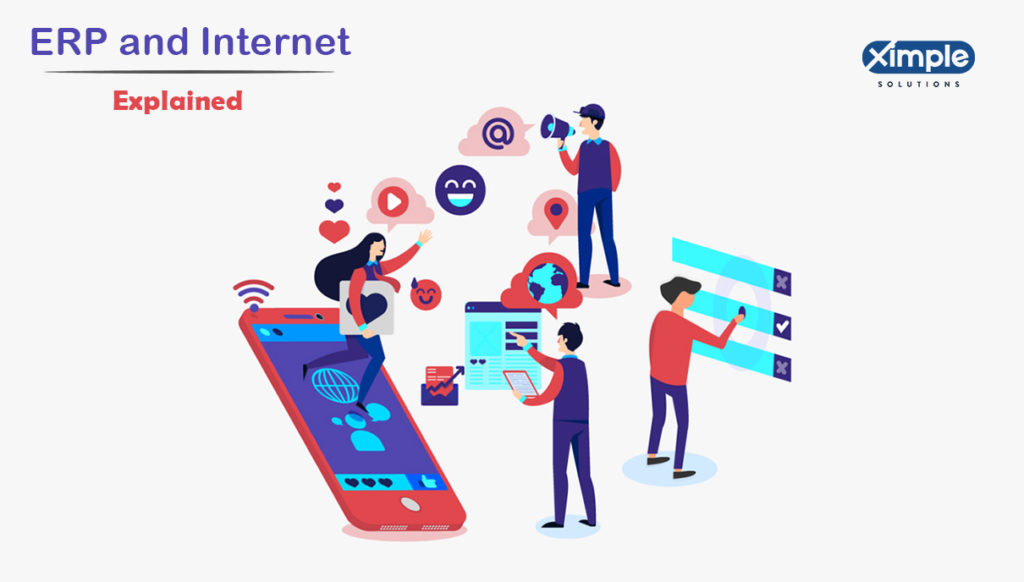
ERP and Internet or Cloud ERP refers to a system that operates on a vendor’s server. Users can access it directly online if they have a stable internet connection and a browser. It is an internet-based ERP. Cloud ERP software is more flexible because of the ease of access. As companies embrace a hybrid system of work, cloud ERP will become inevitable. A hybrid work system includes office and remote work. Hence, remote workers can benefit a lot from ERP and the Internet.
Similar to on-premise ERP solutions, cloud enterprise resource planning systems represent a single source of data. They include several business management modules, allowing managers and other stakeholders to access relevant data in real time. An ERP with internet runs on the cloud and does not attract upfront licensing fees. The vendor provides software as a service (SaaS). Later in this article, you will learn the challenges and benefits of cloud ERP.
Table of Contents
- Internet of Things and ERP
- How Modern ERP integrates using the internet
- What are the benefits of integrating ERP with IoT?
- Benefits of ERP and Internet (Cloud ERP)
- Challenges for ERP and Internet
- Future of Internet ERP with Internet
- Selection criteria for the Internet based ERP
- Types of Internet ERP
Internet of Things and ERP
To understand what the Internet of Things ERP system is all about, it is vital to know the meaning of IoT. So, what is the Internet of Things (IoT) all about? It is a network that contains all kinds of internet-enabled physical devices. Hence, IoT can refer to anything, including tablets, mobile phones, computers, laptops, cars, buildings, household appliances, and more. Internet of Things extends the internet connection possibility beyond computers and smartphones. Now when it comes to how the internet can enhance ERP, there is a vital relationship between the two.
Individual devices within the IoT network will provide unstructured data. The ERP software will then organize, analyze, and display this data in a way that users can understand. Internet of Things continues to grow and the main challenge experts have to deal with is data security. As IoT aims to connect millions of devices to the internet, it creates an opportunity for hackers to enhance their craftiness.
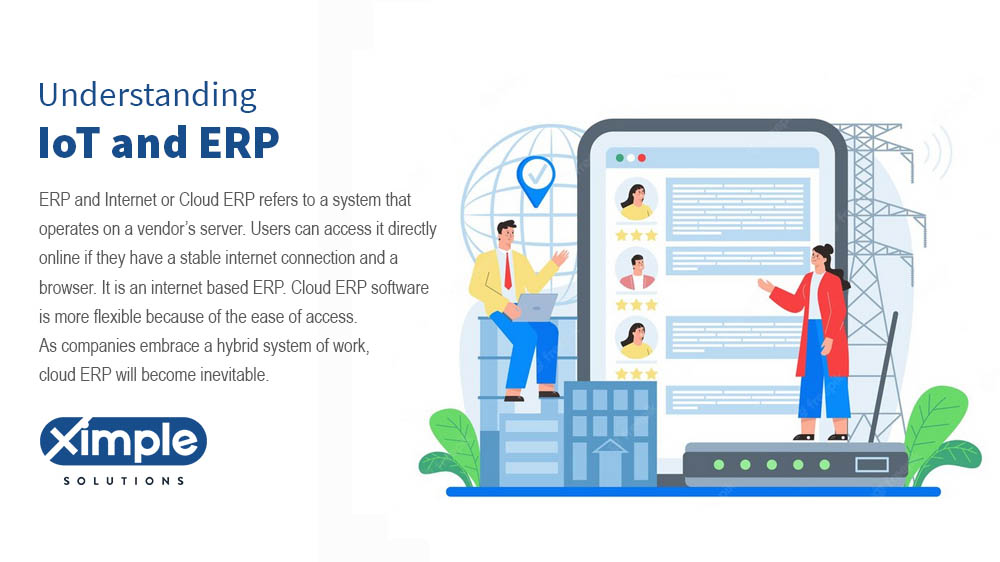
How Modern ERP integrates using the internet
ERP automates workflows, leading to enhanced operations across the industries. The ERP landscape now is complex because of how swiftly the technology is changing. The process of implementing ERP software for large organizations can take about twenty-four months. Between the start and the end of the process, substantial technology changes can occur. It can be challenging to incorporate most of these technologies into the process because that requires money and expertise.
So organizations want to focus on a solution that costs much less and is easy to integrate with the internet. The solution that best suits this description is cloud ERP. The ERP software runs in the vendor’s server at a much lower cost when compared to any on-premise ERP system. Companies using this solution do not require hardware to install the system. They also spend less time implementing a SaaS internet ERP solution.
Again, users of the Internet of Things ERP do not need to worry about power backup or server maintenance because the vendor should take care of that. Concerning the impact of the internet on ERP systems, we can say that IoT may reduce the implementation time. As IoT development improves, it might soon bring down the cost of implementing the ERP. As IoT is a relatively new development, most companies do not trust it.
As earlier hinted, IoT makes data security a major concern. Companies investing in ERP systems do not fully trust data that might come from an IoT network. These organizations have confidential data that could make some hackers millions of money. They aim to avoid any security gaps when implementing their ERP and integrating it with the internet.
Despite the challenge, IoT connectivity can simplify data transmission and allow companies to access data they could previously not find. Cloud ERP software offers scalability so an organization should scale every new IoT device it adds to its network to successfully coordinate internet and ERP software.
Apart from the data security and privacy risks it poses, IoT and ERP integration is beneficial for customer-facing and back-facing processes.
What are the benefits of integrating ERP with IoT?
If companies decide to integrate ERP with IoT, they can benefit in the following ways:
- Improved data availability and quality – The amount of data available to organizations is increasing rapidly now. However, only a few of those willing to collect big data are ready for the challenges of handling it. By integrating ERP and IoT, companies can enhance data availability and quality. They can then use it for better decision-making processes.
- Receive real-time insights – Continuous data streams arising from IoT devices and sensors are valuable insights for a business. Managers can use these actionable insights to improve their decision-making processes. They can also convert their reactive approach into a proactive one.
- Enhanced operational efficiency – Automation of various tasks can lead to better operational efficiency. That can happen after the integration of ERP with the internet and WWW. After this, a company can avoid missed deliveries, shortage of stock, and related issues.
- Better forecasting – IoT and ERP integration simplifies forecasting of consumer purchases and usage of a given product. It provides a direct connection between production and consumption. After analyzing huge quantities of IoT data, companies can make better supply chain decisions.
Benefits of ERP and Internet (Cloud ERP)
How can a company benefit from implementing a cloud ERP system? As we said earlier, this software runs on a third-party platform instead of the company’s data center or firewall. An internet-based ERP system is:
- Cost-effective – A company pays the ERP vendor for the services it uses. After the upfront investment, which is small, they do not incur costs for maintaining and updating software.
- Stability – A cloud ERP is likely to be more stable because the vendor does everything in its power to keep it running. From constant updates to the removal of technical hitches to ensure uptime, a cloud ERP server is unlikely to disappoint users.
- Mobile accessibility – Companies who hire remote workers or field workers can benefit a lot from using an internet-based ERP program. Workers can access the software from anywhere using internet-enabled devices.
Challenges for ERP and Internet
Implementers are likely to face some challenges when trying to implement ERP software. These include the following:
- Change management – When introducing a major change to an organization, managers expect to deal with resistance. Ensuring that company culture is receptive to new ERP solutions is not easy. It is even harder when introducing an Internet of Things ERP system.
- Multiple devices can be hard to manage – Naturally, IT departments have complex work to do. When a company decides to integrate IoT and ERP, that’s an additional complexity to deal with. Even if the ERP provider runs the software in their server, they do not operate and manage the in-house IT environment. Data integration between the two systems must be impeccable and it is up to the IT workers to achieve this.
- Teams need time to learn – When it comes to learning a new system such as internet integration technology in ERP, teams need adequate time. They also have to receive sufficient coaching and have tolerance for failure. Without enough financial resources, teams can take longer to learn how the Internet of Things can boost ERP.
Future of Internet ERP with Internet
What does the future hold for Internet ERP? Soon, companies will face compatibility failures due to the continued growth of IoT. They will struggle to meet and maintain IoT device standards, certifications, and system environments. Hence, companies may form partnerships to create ideal ecosystems for endless IoT data streams. The growth of the Internet of Things will trigger the accumulation of big data that will be harder to handle. Hence, it is likely that the future will bring new data processing software to help analyze the bulk data. IoT is hard to trust because of the possibility of causing data security and privacy issues. For that reason, companies will develop robust security solutions to increase data safety and confidentiality.
Selection criteria for the Internet-based ERP
When selecting the best cloud ERP, what factors should a company consider? As there are many software solutions at their disposal, companies need specific selection criteria for Internet ERP. First of all, they must get an industry-specific internet-based ERP package. To get it, a company should consider its role in its niche industry. Retailers, manufacturers, and distributors have specific solutions that match their roles. It is also vital to reflect on the security model that a vendor uses to protect the client’s cloud system. Lastly, make sure you know the benefits that your company could get from using a particular internet-based solution.
Types of Internet ERP
There are different kinds of cloud ERP systems. It is upon your company to study the impact of the internet on ERP and choose the best solution. First, there are cloud models that use on-premise ERP infrastructure. These are known as private cloud ERP solutions that have on-premise and private cloud properties. A private cloud is an expensive cloud option to implement and run, unfortunately.
The service as a Service (SaaS) cloud option is the best form of cloud ERP for small businesses. It is easy to implement initially because the vendor does it all on your behalf. However, you have to meet regular subscription payments. The proprietary cloud refers to similar to a private cloud only that the software vendor hosts data patches in their servers. It is cheaper and easier to deploy than on-premise private cloud solutions. Small enterprises can scale their proprietary cloud and they expand and grow.
Conclusion
The integration of ERP with the internet and IoT has the potential to bring significant benefits to companies, such as improved data availability and quality, real-time insights, enhanced operational efficiency, and better forecasting. However, implementing an internet-based ERP system also comes with challenges, such as change management, managing multiple devices, and the need for teams to have time to learn. Companies need to carefully consider their specific needs and choose an internet-based ERP solution that fits their industry, security requirements, and budget. The future of internet ERP is likely to bring new data processing software and security solutions to handle the growing demand for IoT data.
Posted on
Ximple ERP for Small Business – SME
Small businesses can scale up their operations by obtaining an ERP for small businesses. ERP (Enterprise Resource Planning) software covers all areas of business management. It has different modules, and you can choose the ones that meet the needs of your business. Some modules include marketing, accounting and finance, human capital management, customer relationships management, project management, warehouse management, sales order management, supply chain management, and inventory management.
It is possible to configure ERP software in such a way that it covers all areas of your business. Many small businesses have limited financial resources. So they have to plan their expenditures based on the available finances. When choosing the best ERP system for small business entities, consider finances and more. But which software is the best choice for your SME, and how can you find it? We will attempt to answer these questions throughout this article.
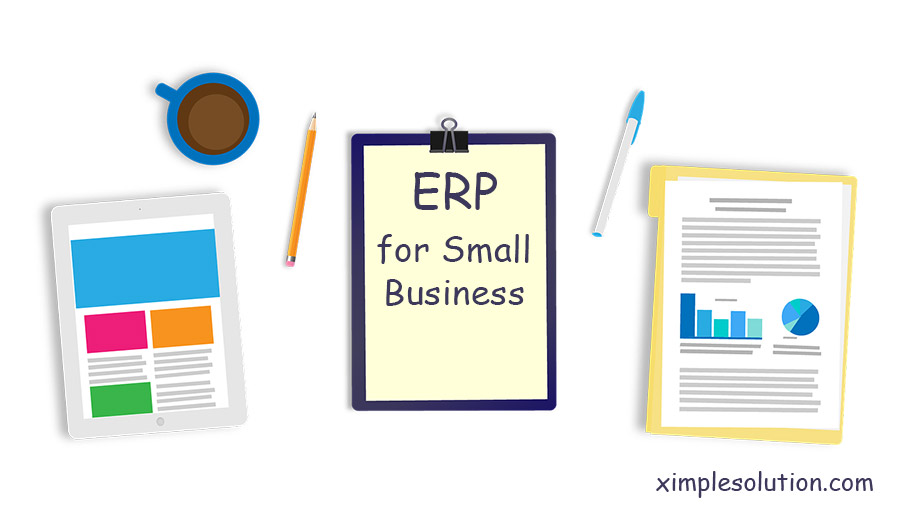
Table of Contents
Best ERP for small businesses
The best ERP business solution should meet all the needs of your business. Before choosing software, study all aspects of your enterprise and identify the gaps you can fill with ERP software. The top considerations when selecting the best ERP software for small business facilities include:
- Your industry – Currently, there is a suitable ERP solution for virtually every industry. An industry-specific tool is easy to customize to match your needs. It is also the most appropriate choice because the manufacturer made it with your specific needs in mind.
- Cloud Configuration – In these modern times, all businesses want to own a website and search for new leads online. Again, the majority of companies decided to try remote working when the coronavirus came. There are more than enough reasons to put your business operations online if you have not done that. You can start by buying small business cloud ERP software. Cloud ERP is easy to install, making it the most practical option for a small business.
- Open source – An affordable resource planning tool is the admiration of every small business owner. Although it has limited ERP modules and functions, it can still meet the needs of your small enterprise.
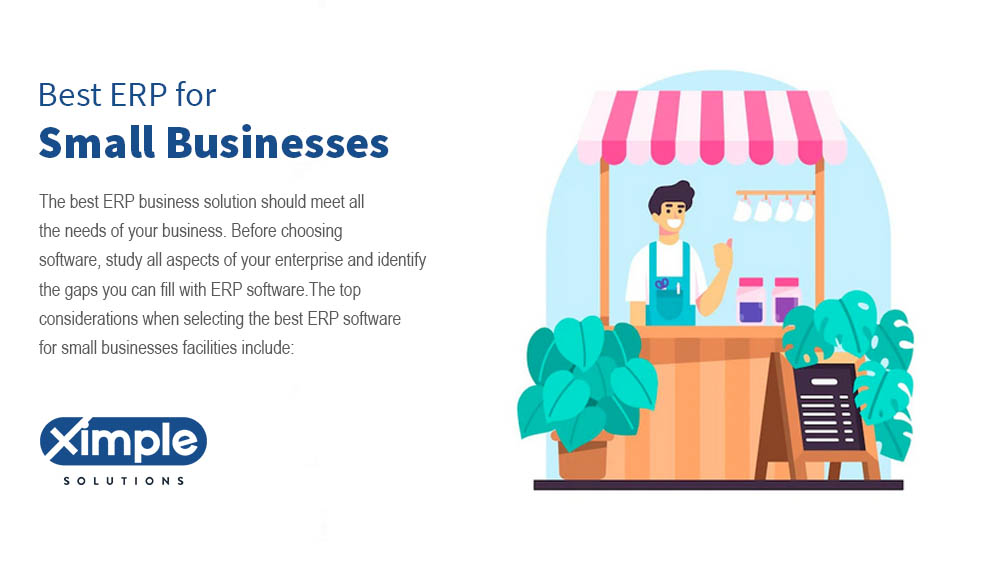
ERP applications for small business
There are many ERP tools to choose from. However, you need to know the actual use of ERP in business when selecting the best. Are there specific roles you struggle to do without the software? Can ERP tackle these challenges effectively? You need to understand the ERP’s impact on business operations. Here is how you can apply Enterprise Resource Planning.
- Accounting and finance – A business of any size needs to capture every transaction it encounters daily. Through proper bookkeeping, you can account for every cent, manage the allocation of resources, and release accurate financial reports.
- Business Intelligence – This module can help your small enterprise analyze and report relevant data to streamline decision-making.
- Customer Relationships Management – Your small business relations with customers, are crucial. You must strive to maintain a good relationship with your customers all the time. Luckily, you do not have to buy a separate CRM software tool when a similar module is in ERP software.
- Human Capital Management – Human resources are some of the most crucial assets of a business of any size. To manage the affairs of your human resources well, you can pick one of the best ERP business systems. The software has an HCM module that can let you administer payroll issues.
- Inventory management – To keep the operations of your business running, you must ensure proper inventory management. With ERP, you can see the movement of your stock to know when to replenish the units.
- Marketing – A marketing module can help you with attribution. You can see how your marketing campaigns are going to decide where to allocate a bigger budget. An ERP for a small business can simplify your marketing role.
You can have many business modules in ERP. However, it would be best to consider that the more modules you have, the more expensive the software may become. So it would help if you chose a few applications that matter to your business.
Cloud ERP systems for small business
A modern cloud ERP solution is better than any legacy system because it has more advanced features. Besides the typical applications, you can access features like collaboration, advanced analytics, mobile device support, etc. Additionally, cloud solutions offer scalability. When your small business begins to grow, more back-office functions might crop up.
You cannot resist buying a scalable ERP tool with more customers to serve, extra currencies to process, and additional suppliers to trade with. This is a software product that you do not need to replace soon. If you want to be smart when running a business, choose cloud ERP because it is more cost-effective. Featuring an affordable one-time subscription, cloud ERP keeps your initial ERP cost low. Remember that ERP cost for small business entities matters a lot because your resources are limited. If you deploy an on-premise legacy system, it will require considerable capital expense now and in the future because you have to maintain it.
Best ERP software for small and medium enterprises
Note that cloud platforms for small and medium enterprises differ in some ways. When choosing the perfect one for your needs, consider the differences in these models.
- Hosted Single Tenant – Another name for this model is SaaS(Software-as-a-Service). Therefore the ERP software vendor will host the solution in a server found in their data center. It provides privacy because you do not have to share.
- Multi-tenant SaaS – The other name for this model is the public cloud. It means that a single vendor server hosts all customers. However, there are no security loopholes; however, each client’s ERP application data is safe from intruders.
- A private cloud requires you to purchase and become the owner of an ERP software system for small businesses. A private cloud does not stay on a server at a physical site. Its home is intangible as it runs on a cloud infrastructure leased from a third party.
Based on what we have stated above, which model would you like to buy for your small or medium-sized business? The most appropriate cloud-based ERP software for small business operations is the multi-tenant SaaS. It is cost-effective and the simplest to set up and install. Even if it does not offer the same privacy level as the other two options, the multi-tenant SaaS is easy to update and use. It is the vendor who does the most complicated job for small business owners. ERP for small enterprises
As we have hinted above, the most appropriate ERP for small enterprises is the multi-tenant SaaS. It is a cost-effective solution because you do not have to buy or install anything. It is the vendor who runs, safeguards, and maintains their server. It is their job to make sure that you are using the most current software version.
This model is still the best because you can continue to use it when your business grows. If you are not good at IT activities, the multi-tenant SaaS model is ideal for you. Some enterprises still cannot operate a paid ERP tool. In such a situation, the most appropriate solutions are open-source software tools. Open-source ERP comes with a source code.
Another option is the Free Proprietary small businesses ERP. Although these versions do not have all functions, they can meet the needs of some small enterprises. They can be a good alternative when you cannot afford Proprietary ERP tools like cloud ERP for small businesses.
Best small business cloud ERP
When considering the best cloud ERP for your small business, what capabilities are a must-choose? The built-in capabilities of a cloud infrastructure matter a lot. The features of different cloud-based ERP solutions are diverse and unique. So, which ones do you need?
- Unwavering security – When your critical business data is online, it is vulnerable to theft. So, select a tool that provides multi-level security, automated data backup and recovery, and reliable data centers.
- Mobility – Remote workers will depend heavily on your cloud ERP business software. As a result, you need to check the compatibility of your software with mobile devices like smartphones and tablets.
- User-friendly – Some of your ERP users do not have IT knowledge. So it would help if you considered them as you select an appropriate cloud ERP.
- Collaboration – When work teams join forces and share information, they become more productive. Even a simple ERP for SME organizations should allow social collaboration.
- Easier integration – Do not choose cloud ERP solutions that cannot work flawlessly with your applications. Focus on how easy it would be to connect to other data sources from your ERP.
Small Business ERP for Grow Business
Small companies are the majority in most countries. To ensure that your company stands out from the crowd of same-size enterprises, you need the best web-based ERP for small business entities. It will address specific functions that are important to your organization.
Since there are several options out there, you may require help when selecting the best option. If we have to mention a few reliable products, then we would recommend Ximple Solutions ERP ahead of any other. Explore it now to see how comprehensive and practical it is for small companies. Other options worth mentioning include Acumatica, Sage 100 Cloud, Sap Business ByDesign, and Oracle Netsuite ERP.
To conclude, we hope you have learned valuable tips from this article. Now you know why we use ERP in business management. Make sure you buy the one that can satisfy every business need you have. It should be cost-friendly, of course, and run on a cloud infrastructure.
Posted on
WMS – Warehouse Management system
There are different types of software for business management. One of the most popular software for suppliers is the warehouse management system or WMS. It is a tool that can help you manage and control everything that happens in your warehouse. From inventory management to order shipment, the warehouse management system is such a crucial tool. During WMS implementation, you can buy it as a standalone system or have it as a module in your ERP (Enterprise Resource Planning) software.
The original WMSs were simple automated tools with essential functions like order picking, packing, and shipment. In contrast, modern platforms are more advanced and can handle more complex interactions with other devices. With these, human errors are rare. Also, vendors can locate ordered items in their warehouses quickly. Hence, it would be best to adopt WMS warehouse management system software to stop laborious paperwork and embrace automation.
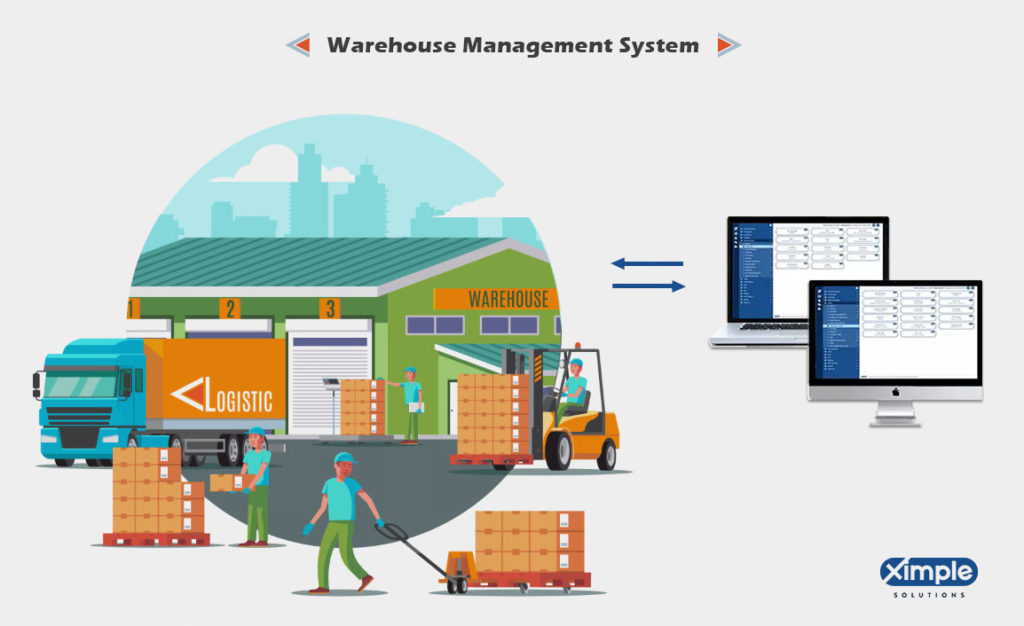
Table of Contents
WMS ERP difference
Now you know the answer to this question: what is a warehouse management system? Now the next thing you want to know is whether there are differences between WMS and ERP systems. The truth is that the two are distinct in some ways. Some enterprise resource planning systems have a warehouse management system module, but the module is not similar to dedicated warehouse management software. Regardless, both ERP and WMS are essential systems for those who do a wholesale and distribution business.
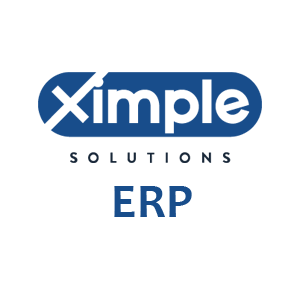
See How We Can Help to Reduce Your Operational Costs for Your Wholesale Distribution Business.
Ximple ERP automation improves workflows & processes across the distribution departments which help to reduce operational cost and productivity.
If you want our wholsale distribution business experts at Ximple Solution to help you digitalize your distribution business or upgrade your legacy ERP, just book a call
So when contrasting WMS vs. ERP, the main similarity between them is that they are both suitable for the distribution business. The first WMS ERP difference is the primary function of each. A WMS system reveals the flow and storage of stock in a warehouse in real time. Through it, a distributor can study the behavior of every stock item and take action to avoid problems. It can track the movement of a product from the shelf to the shopping cart to the specific shipping location.
Then again, ERP provides a live picture of what is transpiring in each business department. It has a module for every vital business function, including Accounting/finance, sales and order processing, inventory management, customer relationships management, human capital management, project management, purchase management, warehouse management, and so on. Depending on the ERP product you own, it may be unnecessary to purchase a separate WMS application.
For instance, if your ERP already consists of inventory and warehouse management modules, it may seem needless to purchase a separate WMS. This is because your system can still show you each inventory item as it gets received, picked, packed, and dispatched. It can also control bin and shelf locations.
All the same, purchase complete WMS only if you need more warehouse management features and a robust tool that can handle the complex needs of the large-scale distribution business. However, running a complete WMS will be more expensive than having a module within your ERP.
Essential features of WMS
Warehouse management system functions are many. They become possible because of various features of the WMS. Briefly, these include the following:
- Warehouse design – The software can dictate bin slots based on inventory items and optimize inventory allocation. It can also account for inconsistencies in seasonal inventory.
- Inventory tracking – The software uses AIDC (automatic identification and data capture) tools like barcode scanners to track the movements of various inventory items.
- Picking and packing tasks – This is one of the best WMS components. It enables batch, zone, and wave picking.
- Receiving and putaway – Via pick-to-voice and pick-to-light technologies, this feature helps workers receive and retrieve items with ease.
- Shipping – This feature facilitates the sending of the bills of landing documents before the shipment arrives. It can also generate packing lights and invoices for a shipment. Moreover, it can send advance shipment alerts to concerned recipients.
- Yard and dock management – This function helps truck drivers locate ideal loading docks before arriving at a warehouse location. It can enable cross-docking too when logistics become too complex.
- Labor management – This feature entails KPIs or metrics that show workers who outdoor others or those who perform so poorly. Reporting – This feature helps managers evaluate warehouse operations to pinpoint weak areas that call for improvement.
Benefits of WMS
No matter how you deploy a WMS warehouse system, it will offer certain advantages. These include the following:
- Saves time
- Accurate inventory control and management
- Better customer care service
- Excellent space utilization at the warehouse
- More productivity from workers
- Lower labor costs because software eliminates human errors.
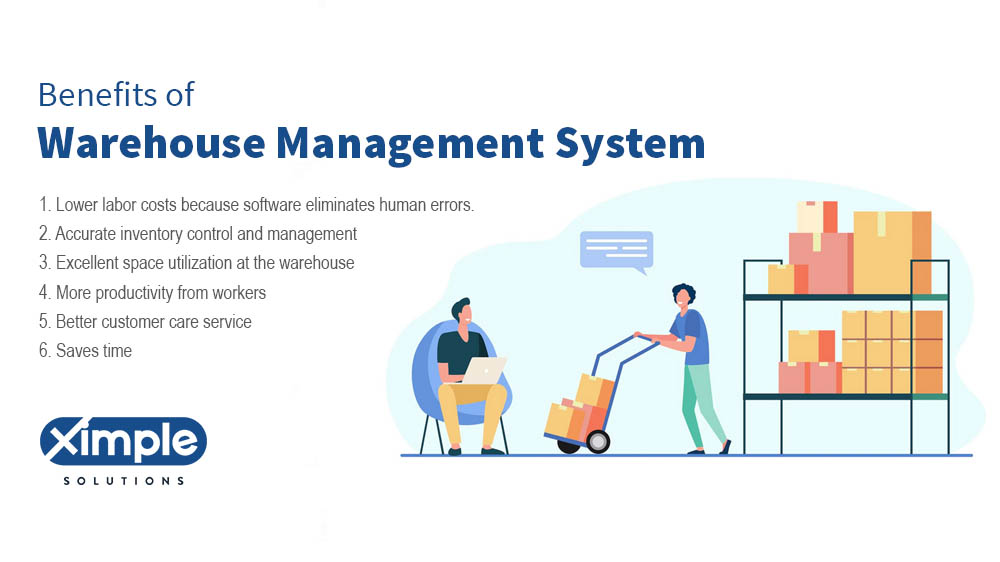

Types of WMS – Cloud WMS and On-PremiseWMS
Without a doubt, the uses of WMS are many and essential. Nonetheless, you need the best type of software to benefit from all these uses. There are two types of warehouse management systems, and they include:
- Standalone or on-premise WMS – Deployment for an on-premise WMS occurs on your office hardware and network. So, a standalone package requires integration with existing business management tools. More commonly, people attach it to ERP.
- Cloud WMS – A cloud-based option is a sound warehouse management system because of using advanced technology. Internet-based software as a service (SaaS) model, cloud WMS is more flexible, scalable, secure, and modern. This cloud computing model ensures free automatic software updates, and workers can use it from anywhere.
Open-source WMS
Usually, open-source software is free to use. Any person can access it without having to pay for any section of it. As a small business with less complicated supply chain management operations, you can opt for open-source WMS. It will be cheaper to run and less complex because it has basic features and functions.
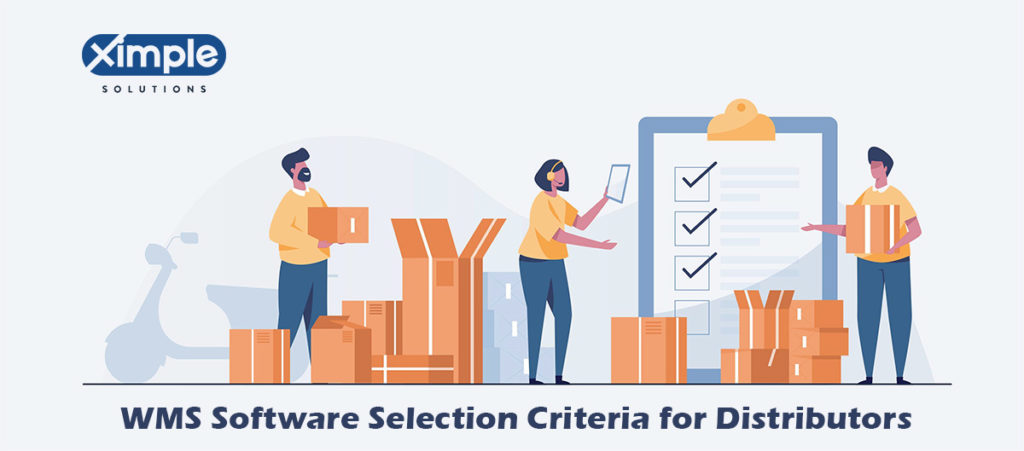

WMS Software Selection Criteria for Distributors
When it comes to selecting the best warehouse storage management system, consider some factors. Here is an outline:
- How well particular software can fit your needs and function flawlessly
- What is the nature of the purchase agreement? Will you get permanent licensing, or will you have to subscribe for licensing every month?
- Cost of implementation and training
- Is the software customizable?
- Will you need to pay for software updates?
- Backup and redundancy just in case the unthinkable technical hitches occur
- The entire cost of ownership and if you can afford it
- Does the software match your internal protocol and philosophy?
Implementation of the WHM system
The implementation phase of an enterprise warehouse management tool can be long and difficult. You, therefore, should prepare to do it well while involving every relevant party. It is necessary to know what company directors, logistics managers, operations managers, and warehouse managers think. Their views and expectations should be clear before the implementation process begins.
Another essential thing to consider is risk reduction. The implementers have to have the wisdom and expertise to assess the risks and take precautions to prevent or mitigate them. To understand these risks and weak points, the executors might have to review the entire warehouse operations.
It is also necessary to create an implementation schedule while considering all the possible risks and unforeseen obstacles. Again, team building is a must between your WMS software installers and the crew from the software seller.
Training is necessary when choosing the right WMS design and customization needs. Training sessions can help intended users to transition easily from what they are using now. Besides, they need to know how to customize the system should it fail to meet some of their operations in the future.
Data transfer from an older system to a new system is tricky but mandatory. This part of the implementation process is critical, and any missing or erroneous data can be costly to repair in the future. There will also be the testing and deployment phases that will require a lot of caution and expertise.
WMS integration with Erp
Sometimes ERP WMS systems are better than dedicated WMS systems. If you want to adopt an ERP system, you can ensure it has a WMS module. Alternatively, if you have an existing ERP, you can connect it to a suitable WMS tool. The integration procedure can be complicated and so requires professional intervention. Similar to the implementation of the logistics warehouse management software, integration of WMS with ERP involves planning. A lot of expertise is vital to avoid duplicate data and other costly mistakes.
Best WMS Systems for Distributors
When choosing the best WMS system for your distribution business, there are many choices. The generalized options include Netsuite, Odoo, Manhattan Associates, Softeon, Fishbowl Inventory, HighJump, Skuvault, and Mobe3 WMS. If you are looking for an ERP specially designed for the Wholesale Distribution business, then Ximple Solution is the ideal ERP Software. It’s next-generation ERP Software designed for Distribution Verticals. It’s a scalable, Cost-effective Cloud WMS helping Distributors to improve Customer Service, and reduce inventory, and employee productivity.
Conclusion:
So far, you know that a typical WMS tool will track picking, packing, and shipment. It will reveal the movement of stock items and help warehouse workers get more productive and thorough. Regarding the right software to choose between a WMS tool and an ERP WMS module, we would ask you to evaluate your business needs and risks. If your operations are more complex, you might need one of the best-dedicated inventory warehouse management systems. Otherwise, the WMS module in most ERPs works just fine. After telling you all there is to say about WMS, it is your turn to choose the best. We believe Ximple WMS is a great foundation for the Wholesale Distribution business. Its comprehensive scalable cloud-based ERP software for Distribution.
Posted on
ERP Comparison- Ximple versus Leading ERP Providers
Enterprise Resource Planning software is an essential tool for businesses of all sizes and kinds. ERP does many redundant tasks, which can help reduce some of the overhead costs. With just one ERP software, a business can manage sales, accounting, finance, inventory management, warehouse management, human capital, projects, procurement, and customer relationships. Several software companies make this software, so you need to know how to select the best among many ERP software. In this review, we will do a comparison between different ERP systems. To be precise, we will perform an ERP System Comparison of Ximple Solutions’ ERP with other ERP Software in the industry. So, Let’s start with a short introduction to Ximple Solutions.
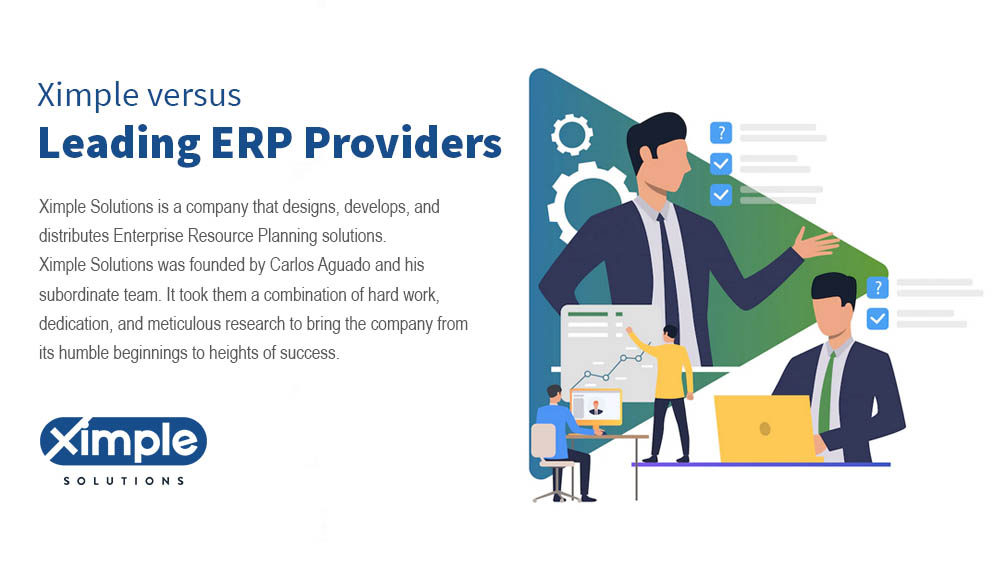

Ximple Solutions – Overview
Ximple Solutions is a company that designs, develops, and distributes Enterprise Resource Planning solutions. Ximple Solutions was founded by Carlos Aguado and his subordinate team. It took them a combination of hard work, dedication, and meticulous research to bring the company from its humble beginnings to heights of success. Although its ERP solution can help businesses of all sizes, the company focuses on medium-sized and large-sized organizations. Additionally, Ximple provides consultancy services on technology matters. As the leading ERP provider, Ximple excels in HVAC, Plumbing, Electrical, Fastener, Hose, and other industries. Its software consists of different modules that harmonize to offer the best customer experience. For ERP System Comparison first, we will pick Epicor Prophet 21.
Table of Contents
- Epicor Prophet 21 vs. Ximple Solutions – ERP Comparison
- Oracle Netsuit vs. Ximple Solutions – ERP Comparison
- Sage X3 vs. Ximple Solutions – ERP System Comparison
- QuickBooks vs. Ximple Solutions – ERP Comparison
- Microsoft Dynamics 365 Business Central vs. Ximple Solutions
- Sage Intacct vs. Ximple Solutions
- Conclusion
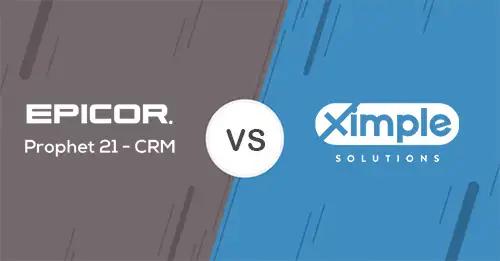

Epicor Prophet 21 vs. Ximple Solutions – ERP Comparison
a) Epicor Prophet 21: Overview
Epicor Prophet 21 is ERP software that runs on the cloud. It focuses on distributors in various industries. Epicor Prophet 21 has different modules and compatibility with Microsoft Azure. Also, the software can run on any browser and comes with the Epicor Virtual Agent app (EVA). As a result, distributors can access it on their mobile devices or computers. Epicor is so big that it is built on hierarchy and bureaucracy. In recent years it has been spun off many times that it is hard to keep track of. Recently it is controlled by a company that owns a distribution channel and thus Epicor can be a direct competitor of its customers. For ERP System Comparison with Ximple Solution, all modules of Ximple are listed below.
b) Modules- Ximple has the following modules:
- Sales
- Purchasing
- Warehousing and Inventory Management
- Delivery Route Setup
- Product Catalog
- Administration
- Employee Management
- Banking
- Billing
- General Ledger
- Accounts Payable
- Accounts Receivable
- Reporting
- Activity-Based Costing
- Bar Coding and Label Printing
- Check Reconciliation
- Contact Manager
- Cylinder/ Container Tracking
- Document Imaging
- eBusiness/eCommerce Platform
- Electronic Catalog
- EDI(Electronic Data Interchange)
- Electronic Mail
- E-commerce (B2B / B2C)
- Digital Payment
Epicor Prophet has the following modules:
- Sales Management
- Inventory and Supply Chain
- Value-added services
- Finance and Accounting
- Warehouse Management
- Business intelligence
- E-commerce
- Customer Experience
Winner Ximple Solutions.
c) Features
Regarding features, both software tools have plenty of them. The Epicor Prophet 21 has up to 21 features that help customers have an amazing experience. On the contrary, Ximple Solutions has seven more features, making the total 28. Ximple Solutions has a better User Interface and User Experience and thus makes it more intuitive. We also love the way Ximple has explained each feature in detail so that distributors can know beforehand what to expect.
Winner Ximple Solutions.
d) Industries
Epicor Prophet 21 focuses mainly on five industries. These are automotive, building supply distributors, manufacturing, and retail. If you click each category, you will notice different areas of coverage. Ximple Solutions serves up to twelve industries, and all of these are distributors which makes it a niche ERP for Distributors. We are in a dilemma when it comes to picking the best in terms of features. Ximple covers more distributors than Epicor. In contrast, Epicor covers more manufacturers and automotive businesses, which Ximple does not.
Winner Draw
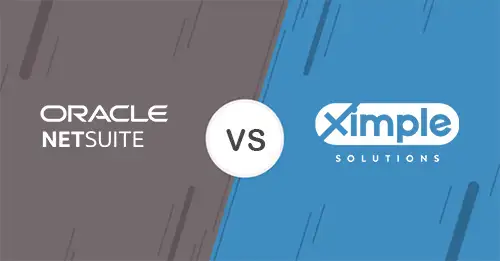

Oracle NetSuite vs. Ximple Solutions – ERP Comparison
a) Oracle Netsuite – Overview
Netsuite from Oracle is a popular ERP software. It is capable of carrying out different business processes in one central system. The estimated users of Netsuite software are over 18,000 in over 200 nations and territories.
b) Modules – Ximple has the following modules:
- Sales
- Purchasing
- Warehousing and Inventory Management
- Delivery Route Setup
- Product Catalog
- Administration
- Employee Management
- Banking
- Billing
- General Ledger
- Accounts Payable
- Accounts Receivable
- Reporting
- Activity-Based Costing
- Bar Coding and Label Printing
- Check Reconciliation
- Contact Manager
- Cylinder/ Container Tracking
- Document Imaging
- eBusiness/eCommerce Platform
- Electronic Catalog
- EDI(Electronic Data Interchange)
- Electronic Mail
- E-commerce (B2B / B2C)
- Digital Payment
Netsuite provides the following modules:
- Finance and Accounting
- Customer Relationship Management
- Professional services automation
- One database, one system
- E-commerce
- Retail
- Manufacturing
Winner Ximple Solutions.
c) Industries
Based on the number of industries served, Ximple Solutions wins. However, Ximple seems to focus more on distributors. In contrast, Netsuite covers unique industries such as Non-profit, Life Science, and professional services in addition to distributors and manufacturers. Overall, both software tools have enough coverage. Nevertheless, Netsuite has unique niches.
Winner Netsuite.
d) Plans
NetSuite is only a cloud-based solution. Hence, anyone looking to buy it has to have their ERP added to the cloud. They can only access it online. On the contrary, Ximple Solutions has two options: Cloud-based ERP and On-Premises ERP. Hence, Ximple gives customers the flexibility to choose the right ERP for their needs.
Winner Ximple Solutions
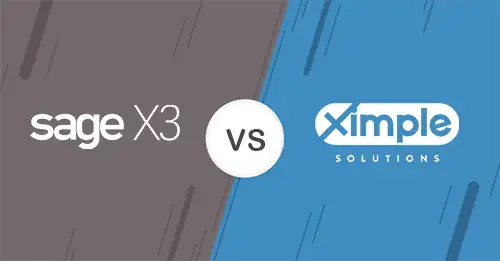

Sage X3 vs. Ximple Solutions – ERP System Comparison
a) Sage: Overview
Sage is known for its accounting software system that people from all over the world use. However, it also has an ultra-modern ERP system aimed at different industries. It is a cloud-based ERP system named Sage X3.
b) Modules – Ximple has the following modules:
- Sales
- Purchasing
- Warehousing and Inventory Management
- Delivery Route Setup
- Product Catalog
- Administration
- Employee Management
- Banking
- Billing
- General Ledger
- Accounts Payable
- Accounts Receivable
- Reporting
- Activity-Based Costing
- Bar Coding and Label Printing
- Check Reconciliation
- Contact Manager
- Cylinder/ Container Tracking
- Document Imaging
- eBusiness/eCommerce Platform
- Electronic Catalog
- EDI(Electronic Data Interchange)
- Electronic Mail
- E-commerce (B2B / B2C)
- Digital Payment
Sage has the following modules:
- Production Management
- Supply Chain Management
- Financial Management
Winner: Ximple Solutions
c) Industries
Ximple ERP covers distribution industry sectors. Hence, it can be helpful to distributors’ business needs. Conversely, Sage X3 has unique coverage for the Food and Beverage and Services business. It also covers different manufacturing businesses and distributors.
Winner: Sage X3 due to the unique sectors it covers.
d) Plans
Sage X3 is a cloud-based ERP that you can also access on a mobile device. On the other hand, Ximple ERP provides cloud and on-premise plans that you can also access on mobile devices.
Winner: Ximple Solutions
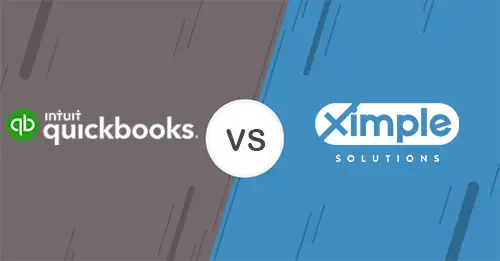

QuickBooks vs. Ximple Solutions – ERP Comparison
a) Quickbooks: overview
Many small to medium businesses handle their accounting work using QuickBooks software. It is a solution from Intuit and has been around for years. As businesses expand their operations beyond their country borders, they cannot just depend on QuickBooks. That’s when they would choose a full ERP. Quick Books have many limitations once the business grows beyond a certain point.
b) Modules – Ximple has the following modules:
- Sales
- Purchasing
- Warehousing and Inventory Management
- Delivery Route Setup
- Product Catalog
- Administration
- Employee Management
- Banking
- Billing
- General Ledger
- Accounts Payable
- Accounts Receivable
- Reporting
- Activity-Based Costing
- Bar Coding and Label Printing
- Check Reconciliation
- Contact Manager
- Cylinder/ Container Tracking
- Document Imaging
- eBusiness/eCommerce Platform
- Electronic Catalog
- EDI(Electronic Data Interchange)
- Electronic Mail
- E-commerce (B2B / B2C)
- Digital Payment
Quick Books has the following modules:
- Sales
- Purchase
- Accounting
Winner: Ximple Solutions
c) Cost-effectiveness
The price of QuickBooks varies based on the package that is suitable for your accounting needs. However, if your business has grown, you cannot rely only on QuickBooks. QuickBooks is not a full ERP. If you keep using it, you will start to notice more errors and downtime. It is cost-friendlier to use Ximple ERP because it grows with your needs. With Ximple, there is no need to buy separate software tools for your accounting or to manage other things. Therefore, Ximple is effective and cheaper to run in the long run.
Winner: Ximple Solutions
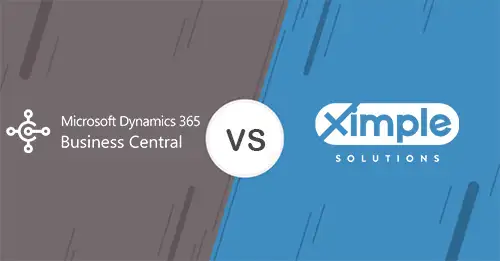

Microsoft Dynamics 365 Business Central vs. Ximple Solutions
a) Microsoft Dynamics 365 Business Central: Overview
This ERP was Navision before, and then it became Dynamics NAV. It integrates with Office 365 and other cloud applications from Microsoft. It is easy to customize and extend to match the specific needs of your industry.
b) Modules – Ximple has the following modules:
- Sales
- Purchasing
- Warehousing and Inventory Management
- Delivery Route Setup
- Product Catalog
- Administration
- Employee Management
- Banking
- Billing
- General Ledger
- Accounts Payable
- Accounts Receivable
- Reporting
- Activity-Based Costing
- Bar Coding and Label Printing
- Check Reconciliation
- Contact Manager
- Cylinder/ Container Tracking
- Document Imaging
- eBusiness/eCommerce Platform
- Electronic Catalog
- EDI(Electronic Data Interchange)
- Electronic Mail
- E-commerce (B2B / B2C)
- Digital Payment
Microsoft Dynamics 365 has the following modules:
- Sales Order Processing
- Warehouse Management
- Reporting and Analysis
- Project Management
- Service Management
- Manufacturing
Winner: Ximple Solutions
c) Plan
Dynamics 356 Business Central is a cloud-based solution that will mostly help accountants. Conversely, Ximple ERP is a comprehensive solution for distributors and is available between cloud ERP and on-premise ERP.
Winner: Ximple Solutions
Sage Intacct vs. Ximple Solutions
a) Sage Intacct: Overview
This is a GAAP-approved and AICPA-certified accounting and financial management solution. Ideal for all kinds of businesses regardless of size, Sage Intacct provides KPIs in real-time. It ensures better financial reporting and decision-making.
b) Modules – Ximple has the following modules:
- Sales
- Purchasing
- Warehousing and Inventory Management
- Delivery Route Setup
- Product Catalog
- Administration
- Employee Management
- Banking
- Billing
- General Ledger
- Accounts Payable
- Accounts Receivable
- Reporting
- Activity-Based Costing
- Bar Coding and Label Printing
- Check Reconciliation
- Contact Manager
- Cylinder/ Container Tracking
- Document Imaging
- eBusiness/eCommerce Platform
- Electronic Catalog
- EDI(Electronic Data Interchange)
- Electronic Mail
- E-commerce (B2B / B2C)
- Digital Payment
Sage Intacct has the following modules:
- Accounts Payable
- Accounts Receivable
- General Ledger
- Order Management
Winner: Ximple Solutions
c) Plan
Sage Intacct is a cloud-based accounting solution. In contrast, Ximple ERP has a cloud ERP and on-premise ERP. If you are looking for software that can do more than accounting, then you would rather go with Ximple.
Winner: Ximple Solutions
Conclusion:
Has your business outgrown its current software needs? Do you need software with more capabilities? Do you want to implement an ERP built on modern technology? If your answer is yes to these questions, you need comprehensive ERP software that meets your business needs. Based on our review after extensive study, Ximple Solutions’ ERP is the best choice. If you run a wholesale and distribution business, Ximple ERP will meet most of your business needs and is built on modern technology with continuous updates. This software suits several different distributors in over ten industries. You can opt for it if you want to achieve quick success without spending extra money and better customer service and support. Above all, Ximple can be cloud-based or On-Premise, which is one thing that puts it ahead of its competitors. Lastly, on the ERP software comparison checklist, Ximple ERP is more user-friendly, and scalable, and can guarantee an excellent user experience. It’s an ideal ERP solution for the wholesale distribution industry.
Posted on
Punchout Software and Punch Out Integration with B2B & ERP
A B2B eCommerce store should meet the needs of the customer. The website itself should accommodate the expectations of different users. It should be efficient, navigable, and easy to access from within the customer’s software. Punchout Catalog Software is usually an e-procurement system, an ERP (Enterprise Resource Planning) platform. Conventional eCommerce websites are independent websites that a customer has to visit before buying. Their order placement procedure is quick but creates a manual data entry task for the buyer. The only system that can allow customers to shop from within their e-procurement software is the Punchout catalog. We will discuss this in this article.
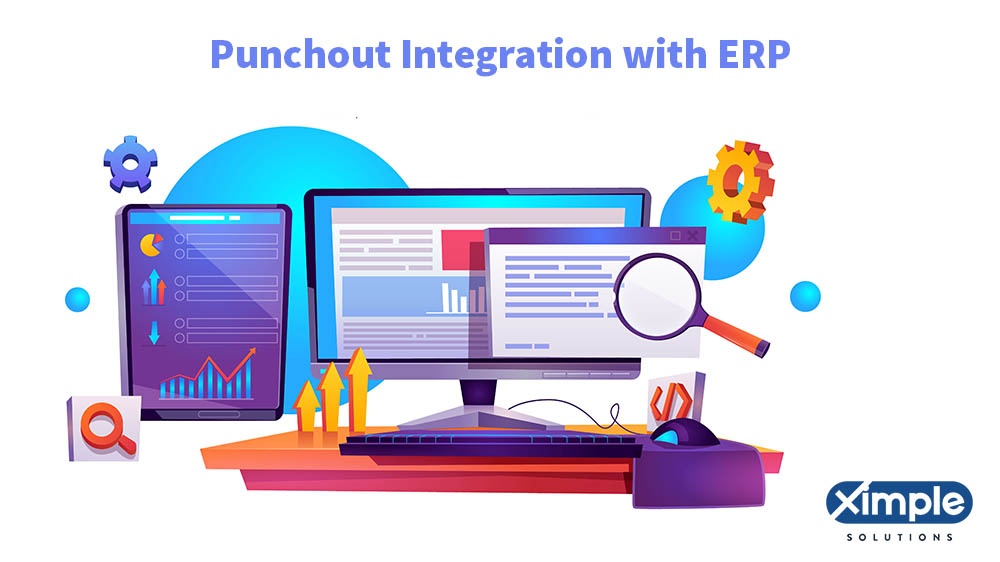

Table of Contents
Punchout and punch out Integration B2B, and punch-out & ERP
So, what is a Punchout? It is a type of technology that every business-to-business eCommerce website requires these days. In short, Punch out software enables buyers to access their suppliers’ web stores without leaving their procurement platforms.
For that reason, the punch-out system can save the buyer’s time and keep them from doing a lot of manual typing work after each purchase. It boosts user experience by connecting vendors and purchasers. In return, this can provoke customer loyalty. Punchout has now become a prerequisite between large suppliers and buyers. There are no B2B relations without Punch-out nowadays. It is now a buyers’ yardstick for choosing the best suppliers.





See How We Can Help to Reduce Your Operational Costs for Your Wholesale Distribution Business.
Ximple ERP automation improves workflows & processes across the distribution departments which help to reduce operational cost and productivity.
If you want our wholsale distribution business experts at Ximple Solution to help you digitalize your distribution business or upgrade your legacy ERP, just book a call
Through ERP integration, suppliers can make information available timely to their buyers or customers. For example, they can show their product catalogs and prices to their buyers in a synchronized manner. Moreover, a supplier can present buyer-specific pricing based on their contract with the buyer. Thanks to Punchout catalog software technology, sellers can produce invoices and sales orders at once.
Here is how this works. The buyer will connect their e-procurement system to their supplier’s website. The website will already be working in tandem with the supplier’s ERP. Hence, when a buyer checks the catalog and orders an item, the transaction will generate reports within the supplier’s ERP.
The ERP will then optimize logistics and other elements related to the production schedule. Job costing and other accounting activities will also be an automatic procedure when the buyer places an order. Initially, only large organizations were bothered with B2B catalog Punch out integration. Today, SMEs are also using this beneficial procurement technology.
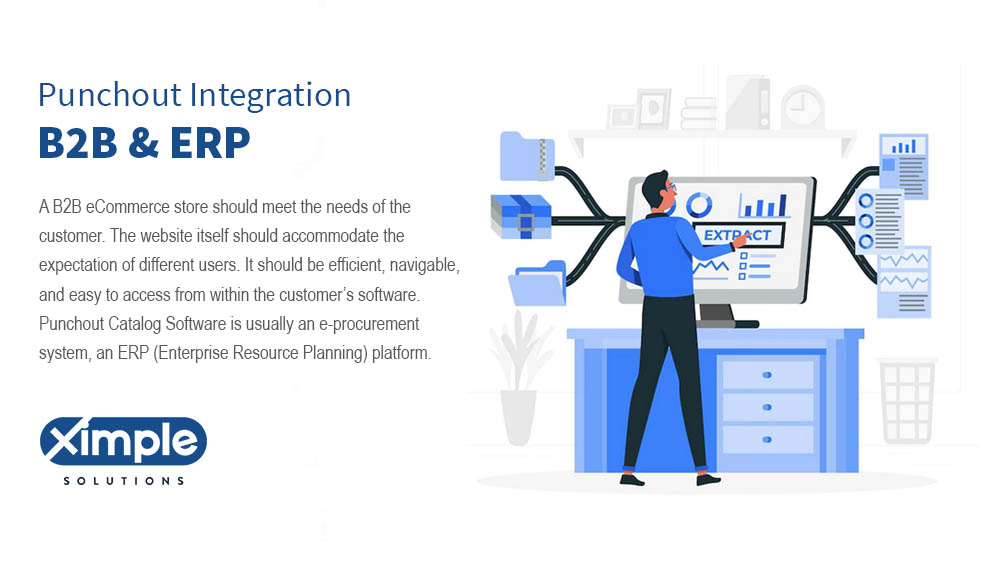

Punchout Catalog
Again, what is a Punchout catalog? It is a cloud-based solution that can allow customers to access a supplier’s online store from within their procurement system. The buyer will have a link in their e-procurement software they can click on to move to the supplier’s Punch-out Catalog. After that, they can explore the product catalog until they find the items they want to buy.
Also, they can add each product they want to the shopping cart and continue the search. Once buyers finish, they can click on a button to add the cart products to their procurement software. Next, the buyer will place an order from within their software and wait for notification about order completion from the supplier. The catalog itself simplifies work as the customer can see the item they want to buy fast.
PUNCHOUT CAPABILITIES
The work that Punchout Technology can do will directly depend on its type. It will also rely on the e-procurement software the buyer has.
- Kinds of procurement software – The first type is the standard e-procurement tool. It is usually a module within an ERP system. This functionality can be the Materials Management module in SAP ERP, for instance, or an Inventory Management module. Another type is an add-on e-procurement application. A buyer has to purchase it and attach it to their existing ERP. This add-on feature is an extension for widening the ERP’s capabilities. A third type is the cloud-based e-procurement software. To work, the Punch out needs to connect to an existing ERP software. An example of this would be the Ariba Punchout Catalog. Of all the three kinds, you should choose the cloud option.
- Types of Punchout – The first type is the CIF (Catalog Interchange Format) files. Although these are not real punchouts, most businesses consider them as such. They are only an upload of product details into a procurement software tool. The entered data is static and requires manual work to adjust. CIF is not a reliable file format to choose for your punch-out catalogs. The next choice is cXML(Commerce eXtensible Markup Language) and OCI (Open Catalog Interface). The two are the means through which communication between eCommerce websites and e-procurement software systems happens. The XML punchout catalog solution is more common than the OCI, however. Lastly, there is the Level 2 punchout method. It allows buyers to view the supplier’s site in one of two ways. First, buyers can locate the product they want directly in their procurement software. After that, they can click to move to the matching product page on the supplier’s website. Alternatively, buyers can choose a supplier as the vendor they want. Then, they can move to that supplier’s site to shop via punch-out software.
WHY DISTRIBUTORS ARE ADOPTING PUNCHOUT
To begin with, distributors are suppliers who deal with buyers at different levels. They deal with various intermediaries to ensure that they fulfill their promise to every buyer. Although having an ERP system is a big step in simplifying their work, distributors need ways to improve their customers’ shopping experiences. As a result, most of them are adopting Punch-out catalogs.
Additionally, distributors want to use the Punchout technology to retain their buyers. Most buyers want to deal only with a distributor who uses Punchout. It eliminates complex data entry work. Buyers can complete a procurement order within their systems, which is convenient and fun. Above all, distributors can increase their sales with existing buyers and raise their odds of attracting new ones. The benefits of a Punch out Catalog to a distributor are many, as you can see.
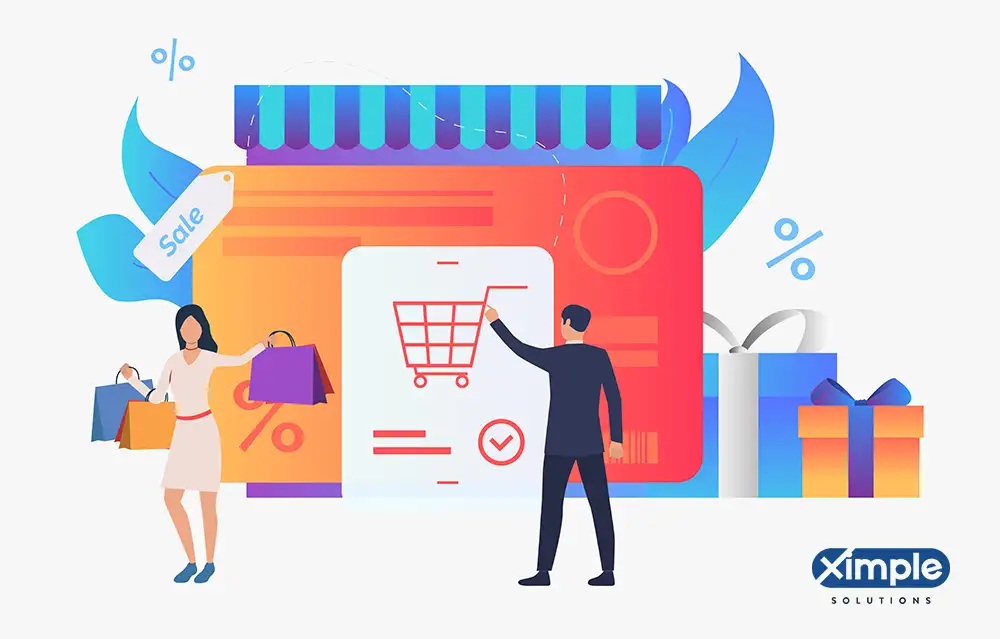

PUNCHOUT & E-COMMERCE
A few years back, the emphasis was on starting an E-Commerce store. Today, having an eCommerce store is insufficient. Buyers can shop from your store, yes, but they have to update their procurement system with the order details manually. Punchout has come to remove this problem. E-commerce stores that have embraced Punchout technology are performing better than their counterparts.
Buyers are abandoning their regular suppliers in favor of those who have Punch out catalogs. Every serious supplier should find out the cost of a Punchout catalog. There is an option to use your existing eCommerce platform or to get a third-party service. The latter is better because it can do Ariba, Dell, OCI, or even Coupa punchout catalog integration. Lastly, orient your sales team to understand the value of a Punchout catalog.
Benefits of a punchout catalog ERP Integration.
The following are the advantages of Integrating ERP and Punchout:
- Suppliers can update prices, item descriptions, shipping details, and other sales information in real-time.
- Punchout can help suppliers build better relationships with buyers and retain them.
- They can provide special offers, promotions, and discounts directly on their eCommerce sites. After that, they can be sure that buyers will read them.
- Accounts Payable (AP), Accounts Receivable (AR), Job Costing, and other accounting activities will be easier and more accurate than before.
- Suppliers can manage cash flows better and boost their financial planning and reporting activities.
Why & how are distributors adopting punch out to grow business?
As we earlier explained, distributors must adopt Punchout technology. Otherwise, they will lose buyers to a competitor who has combined their ERP with Punchout. The best way that distributors can adopt Punchout is via a third party. Regardless of the industry, there is a third party that has the right Punch-out software. Their software tools are bespoke, meaning that distributors can alter them to match their needs. Whether you need a Sap Ariba Punchout Catalog or any other, there is a consultant who has it. The best Punch-out software is available as an independent Punchout catalog solution. It can also be a part of an existing platform. So, how do you want yours?
Conclusion
We have been discussing Punchout Catalog technology. The best Punchout Catalog Example is Amazon.com. You know that Amazon is a massive online store with worldwide buyers. It uses Punch-out technology, which has made it very successful. As a distributor, you should follow suit. Ensure that you adopt Punch-out to benefit your eCommerce store and your esteemed customers. If you are a distributor exploring ERP solutions with Punch-out catalog functionalities, then Ximple Next Generation Cloud ERP is the ideal solution.
Posted on
Best Practices for Successful ERP Data Migration
This blog provides an overview of the Enterprise Resource Planning (ERP) data migration process. It covers the reasons why a business might need to replace its current ERP software, the differences between upgrading and migrating data, and the challenges that may arise during the migration process. It also provides tips on choosing the right cloud-based ERP solution, creating a migration plan, and preparing the organization for the transition. The article concludes by highlighting the benefits of migrating to a cloud-based ERP solution for distributors and manufacturers. This article is suitable for business owners, IT managers, and decision-makers who are considering ERP data migration for their organizations.
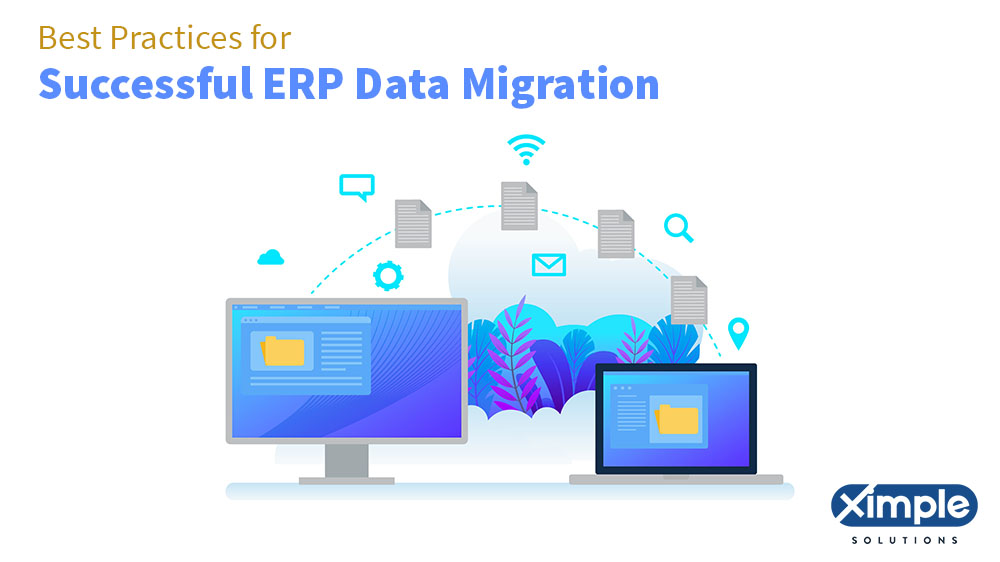

Introduction of ERP Data Migration
First, every business needs suitable Enterprise Resource Planning (ERP) software. ERP is a comprehensive software with different modules. It can handle accounts, finances, sales and revenue, customer relationships, warehousing, human capital, and inventory. Although ERP is essential, it can become outdated. If your business outgrows its software, you should do ERP data migration. This article guide will teach you more about the ERP system migration process. So, read on to find out more.
Table of Contents
Why does a business need to replace the current ERP?
Although an ERP system is vital, it might fail to meet the needs of a business. Failure of the ERP can occur if your business is growing and innovating fast. If an ERP system fails, you should decide on two things: an upgrade or an ERP data migration. We will describe each in a different paragraph. Meanwhile, here are the reasons why your business should replace its current ERP.
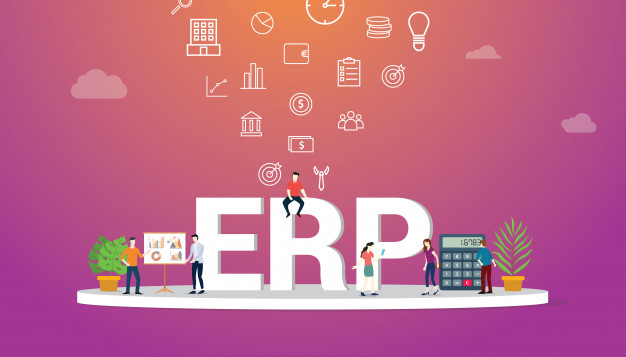

- The current software is no longer working well. It has become difficult to use, slower, and unreliable.
- The cost of running ERP software is too high. This problem can happen if the software has become too old, increasingly undependable, or unsupported by the developer. The cost of modifying your software often to make it work well can be too high.
- Your business has outgrown the software. Therefore, it means that the system will not fully support the current business needs.
- The ERP has become so unusable that you are now using MS Excel or Google spreadsheets. If you will use spreadsheets when you have ERP, the latter is useless to you.
- You cannot compete well anymore. No business wants its rival to have the upper hand. If the ERP software is so terrible that it makes you respond poorly to customers’ needs, change it now. Start creating your ERP data migration checklist.
- Slow software updates Your ERP supplier should add new functionality often to improve their product. If they are taking too long, you should move to a better developer.
When to decide to migrate or upgrade ERP?
How can you tell that you have had enough of your current ERP software? Is it time to create an ERP data migration plan? Here are the signs that the time for change has come.
- Your business tasks are too inefficient these days A legacy ERP system is reliable until it becomes too wasteful.
- Your current business needs are overwhelming. As a result, the software may no longer handle them. It may not adequately support your team’s growth.
- Your customer care support service has deteriorated An old-fashioned ERP system cannot handle multiple user access. Hence, it cannot offer direct access to billing, inventory, and shipping data.
- The legacy system cannot support remote working – The best solution would be ERP data migration to the cloud.
- The existing ERP does not help your mobile workers Again, you require a cloud-based solution. Such a system will be easy to access on a mobile device.
- Lack of access to real-time data A reliable ERP system presents data as things happen or change. If you have to find up-to-date information in person, you should get a better software solution.
- You have non-compliance issues If you have received non-compliance letters from different regulatory bodies, get a cloud-based ERP solution now. It will respond better to the ever-changing compliance demands.
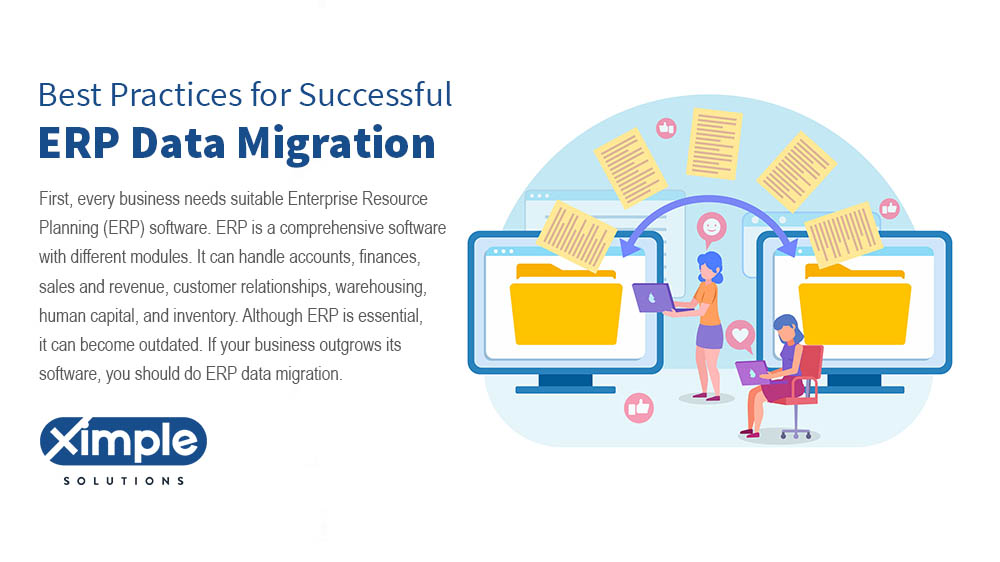

Migrating Data vs. upgrading ERP – What is the difference?
Now you know why you need another ERP platform. However, you need to decide between an upgrade and an ERP data migration process. Ensure that you understand the difference between the two. Hence, an upgrade is a software revision exercise. It can entail moving from a basic software edition to a premium version with better features. Software migration is moving data from its current location to another location. It is, therefore, a delicate process that might require more caution and resources. In short, you need to redesign the current data setup completely.
Challenges during ERP data migration
The process of migration involves moving data from your current ERP to the new data migration ERP system. While it sounds like an easy thing to do, it has its challenges. The following are some of the challenges:
- You need financial resources – Before you do a data migration process, ensure that you have the money and time. As well, ensure you have knowledgeable people who can do the ERP data migration project. Without adequate funds, you cannot accomplish your goals.
- Duplicated records – You will not shift your data the way it is now. Instead, you will edit it to remove duplicate errors and other inconsistencies. The task itself can be complex because you must edit data from different sources. Eventually, the data format should be uniform, which can be tough to achieve.
- It is hard to get everyone’s approval – More importantly, you can face difficulty seeking project approval from the top management. Hence, you must take the time to explain the reasons for ERP data migration.
- How to factor in compliance issues – How well you can comply with the law largely depends on how you process and store your data. If you are operating overseas, you have more regulations to follow. Abiding by all of them is one of the challenges in data migration in ERP.
Why leading distributors are migrating their Legacy ERP to the Next Generation Cloud ERP designed based on micro-services, Java, and Angular technology
The Legacy ERP system is one of the most popular software products. Since 1988, businesses have used it to run more efficiently. And why not when the product entails hardware and software at once? While the Legacy software works well, most businesses do want it now. Indeed, many distributors are searching for the most reliable ERP software. They are doing ERP data migrations regularly. But why don’t people like it now? What is wrong with the Legacy ERP? The biggest problem with it is that now it is an unreliable system.
Legacy ERP software is a powerful system, yes, but it is hard to move to the cloud. Some people think it offers poor usability, making it expensive to run. Besides, businesses want to embrace advanced millennium software products. As companies compete for younger talent, none wants to run old platforms that restrict technology. Furthermore, the early supporters of the Legacy ERP system are retired now. They had all the knowledge of running it and gone home with it. On the other hand, the current generation would rather avoid the Legacy ERP because they are more complicated.
Migrate data to cloud ERP solution
ERP is more efficient, versatile, and cost-effective. However, if it becomes outdated or hard to use, you should consider getting a new one. In addition, you should be ready to face the ERP data migration challenges. As this is a big decision, you should slow down and plan carefully. In summary, consider these factors:
1. The total cost of ownership – Currently, you are running an ineffective on-premise ERP. To shift from it to the cloud ERP, you must evaluate the total cost of ownership. Hence, this will include the cost of buying, implementing, and maintaining software. Will you need to hire external consultants? Can you handle the extra expense?
2. Which cloud option is best for you? – There are various choices, including SaaS. Others are:
- Private cloud solutions – These are dedicated clouds designed for one user only. As a result, they are more flexible, more secure, and highly scalable.
- Public cloud solutions – As the name suggests, these are for businesses that want to share server space with others. They have lower maintenance costs.
- Hybrid cloud options – These are a combination of a public and a private cloud. Also, they can be a merger between a public cloud and an on-premise platform. They are the easiest to deploy.
3. Create a suitable ERP data migration plan – If it is easy to customize your current ERP system, it might be easy to shift it to the cloud. In your migration plan, select a system that will be more beneficial. Consider how software shifts can affect your business functions. Are some applications harder to move? Concerning data, will it need thorough editing before importing it to the new ERP? If so, who can carry out the editing work, and what will it cost the organization?
4. Make everyone aware of the ERP cloud migration considerations – Organizational change management status can affect the migration process. If people have accepted the process, they will ensure its success. On the other hand, if they are afraid of the transition process, it is likely to fail. To ensure that your workers are ready, organize their training needs.
Why are distributors migrating to Cloud-based ERP?
Distributors and manufacturers are in dire need of better ERP software. Their distribution processes are too complex to tackle with ordinary software. Legacy software is too rigid to meet their ever-changing needs. As the supply chain gets complex, it gets harder to manage. More intermediaries require better treatment and management.
Hence, distributors have realized that an advanced ERP is the only best solution. It is highly scalable, flexible, reliable, and cost-effective. Besides, they can now use distributor-specific ERP that can help solve their problems. Also, distributors can access different data patches in real time. Above all, cloud storage is better for distributors because they need to access data remotely.
Conclusion
Businesses may need to replace their current ERP system due to various reasons such as outgrowing the software, high costs, inefficiency, and lack of support. The process of ERP data migration involves moving data from the current system to a new one and can be a complex process. To ensure success, businesses should consider factors such as the total cost of ownership, the best cloud option, creating a suitable migration plan, and making everyone aware of the migration process. Distributors are migrating to cloud-based ERP solutions because they offer scalability, flexibility, reliability, and cost-effectiveness. To ensure a successful data migration to a new ERP, businesses should plan the process carefully and ensure they have adequate resources for implementation.
Posted on
How to ensure a successful ERP Migration
Let’s Find out how to execute a successful ERP Migration
An Approach to an ERP Migration
- ERP implementation is a multi-layered, complicated endeavor that needs to be carefully planned and managed. One of the important layers is the part of migrating your data to the new ERP system.
- Many companies make the mistake of assigning very little importance to this essential task. As a result, they either end up scrambling at the last minute to resolve data display issues or end up with a frustrating mess of an implementation altogether.
- There are, however, steps you can take that will help you make sure the ERP data migration process proceeds without glitches and in as short a time frame as possible.
- ERP migration phases are the process of organizing, restructuring, copying, and migrating data from your old ERP systems to your new solution.
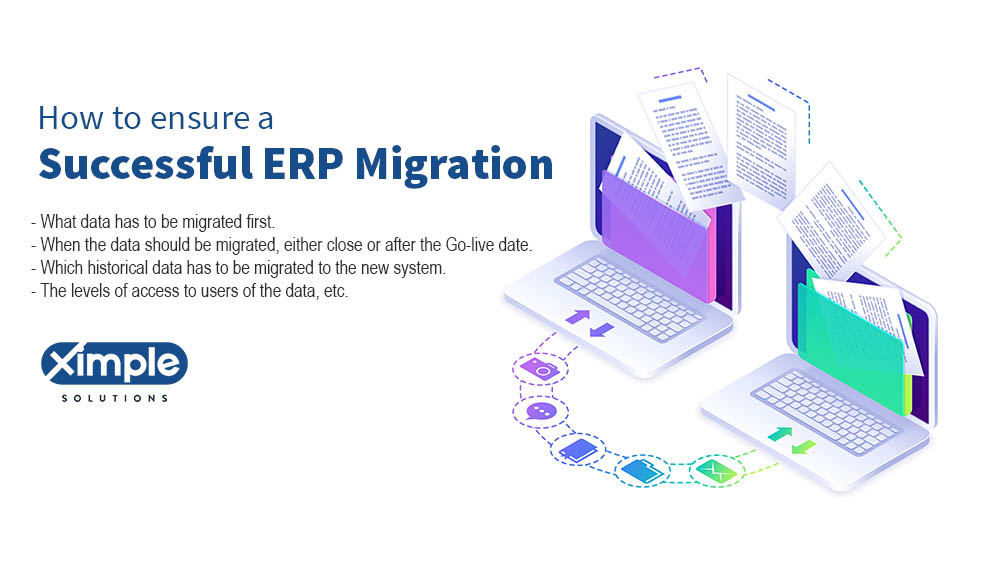

Table of Contents
1. ANALYZE THE ERP MIGRATION PROJECT
Analyzing your data way ahead of the actual ERP migration is a crucial step. You know that your business deals with different kinds of data.
- Master data – the core data that is essential for the operation of your business processes. It is a consistent set of attributes and identifiers that describes the different entities of your company, e.g. customers, products, suppliers, chart of accounts, etc.
- Historical data – collected data that is over two years old.
- Live/current data – all of your recent transactional data
So before you let your vendor embark on ERP data migration, you first need to make some decisions about these types of data.
This can be a tricky and complicated process. If your employees had been inputting data into your legacy system using standardized processes all along, then that’s great news. If, however, at some point or another they had created their own ways of data entry, it may open the door to a whole new set of complications.
You have to define things like,
- What data has to be migrated first?
- When the data should be migrated, either close to or after the Go-live date.
- Which historical data has to be migrated to the new system.
- The levels of access to users of the data, etc.
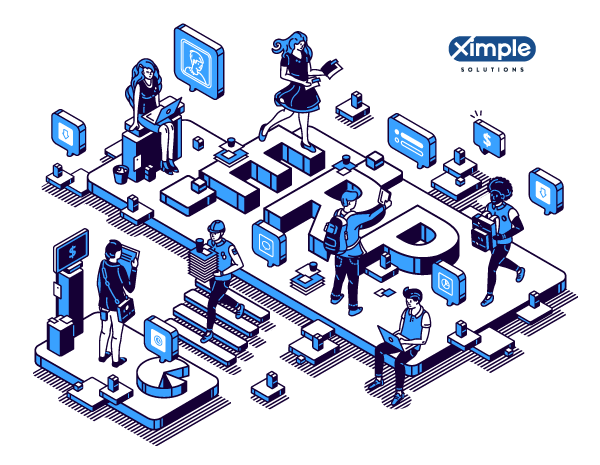

Hence it is very important to overlook the planning and strategizing portion of the ERP migration phases if you don’t want to be hit with unpleasant and frustrating complications.
2. REVIEW YOUR DATA AND PROCESSES BEFORE MIGRATING TO ERP SYSTEM
You have to assess whether you actually need all the data in the new system or not. Before migrating your data from your Legacy system to a new ERP system. you have to do some spring cleaning.
- Review your data and decide on its quality. This is the perfect opportunity to rethink or reassess the ways to record data.
- You may also want to consider changing your processes and ask your new ERP vendor for recommendations on the structure of the data that is stored.
- You have to assess whether you actually need all that data in the new system. This is the time to clean up irrelevant information, inaccurate data, and duplication.
In the end, you should have organized, consistent data categories ready to be migrated to the new system.
3. ASSIGN THE RIGHT PEOPLE
- Apart from making sure that your vendor is completely briefed with the information about your data before they begin the migration process, an essential success factor for this project is assigning an in-house team or employee that will superhead the process.
- Ideally, these people should be long-term company employees who are well-versed in the company’s background and its history with legacy systems.
- These employees can surf your company to extract and organize that data into structured charts.
- You, in turn, will rest assured that you have trusted people who will make sure to keep pushing the ERP system migration forward until everything is successfully entered into the new system.
4. REMEMBER THAT TIME IS OF THE ESSENCE
- The way you map out your data migration processes is crucial. You should have a clearly defined timeline that reflects the types of data, the amount of data, the necessary changes to be made, etc.
- Do make sure to also have contingency plans for delays – unforeseen issues are more likely to arise than not.
5. TEST AND FIX ISSUES IF NEEDED
In order to make sure that everything goes correctly and according to plan follow the following testing procedure :
- First, take a small amount of test data.
- Make sure that it loads correctly in your new ERP system.
- Check how the new solution is handling the data, and take the feedback.
Your key users should then take the new system for a test drive. Simulating their daily business processes and running rigorous tests on the system. This is the key step in catching problems and tracking them early.
Conclusion
“Switching to a new ERP system is never easy, and ERP migration is one of the more complicated parts of the process. Planning ahead and defining a strategy for the process will save you a headache in the future.”
Get in touch with us to see how Ximple Solutions can help your Distribution Business!
FAQ
Why is data migration so important to an ERP migration?
Data migration is a part of the ERP implementation process.ERP solutions depend on the integrity of data to produce credible results. Thus, data migration must lead to accurate, consistent, valid, and complete data.
What are the 4 major phases of ERP implementation?
ERP implementation requires a good deployment plan to succeed. Four major phases of the ERP implementation process include:
- Discovery and planning entail creating a broad team of experts to oversee the ERP implantation process. The team should discover inefficiencies and possible interruptions before planning the implementation process.
- Evaluation and selection – The team must select the best platform for solving existing inefficiencies and problems.
- Design and development – The ERP team must determine if the selected platform can work with existing workflows. If not, it should identify the workflows requiring change. After this, it must start the development process to help meet the needs they have defined above. It is where the data migration process should occur. The team will also determine how to train users and choose the training materials.
- Testing and Deployment – Testing allows the team to assess the platform before it goes live. If the platform is fine, the team will start deploying it. In this step, training is necessary to help reduce resistance to change. After deployment, the team must support the users to ensure they do not miss anything.
What are the three major plans for ERP implementation?
To ensure a successful ERP implementation procedure, carry out three activities. These include:
- Project management
- Process improvement
- Change management.
Related articles
Posted on
5 Reasons Why Modern Cloud ERP Boosts Your Business?
Digital disruption has introduced more data sources, more channels, more complex business models, and increased globalization. Along with it have come mobile, social, analytics, and many other technological innovations. With modern Cloud ERP organizations can Achieve greater Productivity and Control. let’s find out 5 Reasons Why Modern Cloud ERP Boosts Your Business.
In this environment, opportunities are rife but old monolithic enterprise resource planning (ERP) systems are ill-prepared to deliver the support for the increasingly dynamic decision-making processes that businesses need to succeed.
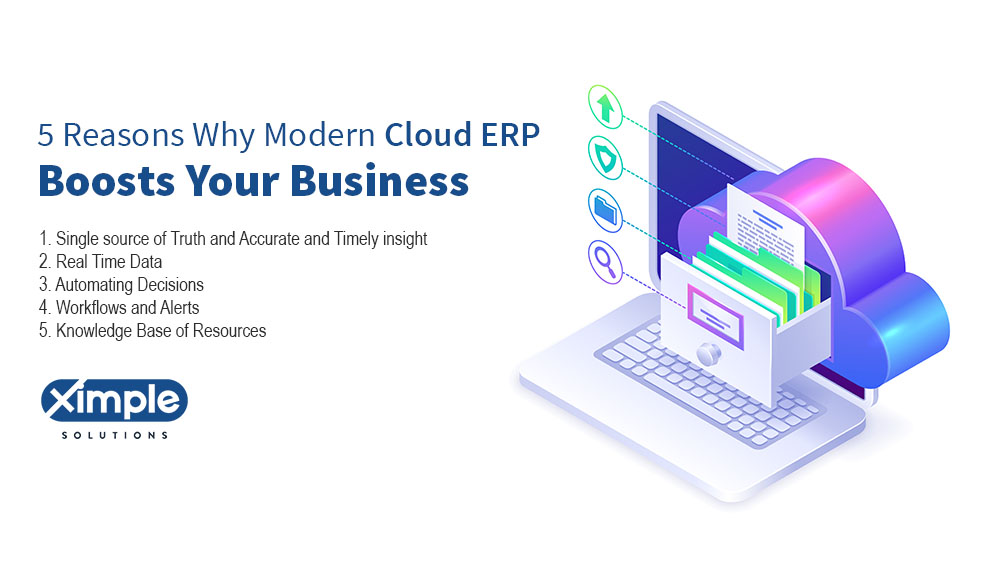

To support improved decision-making and action-taking, modern cloud ERP platforms give organizations :


- The ability to analyze business conditions.
- To develop improved business plans.
- Monitor and Measure progress.
- Provide visibility into day-to-day operations.
In a recent survey by Ximple Software executives were asked to list the issues that would have the biggest impact on finance and accounting in their business over the next two to three years. The top two responses were big data and investment in new or more advanced IT systems.
Table of Contents
Here are 5 reasons which of the following is an advantage of Modern Cloud ERP:
1. Single source of Truth and Accurate and Timely insight
- Decisions made from a report of how the business is performing give any company a competitive advantage.
- According to your business needs modern cloud ERP can centralize its data to a Cloud ERP or an On-site Server.
- When all data is consistently stored in one place and accessed independently, regardless of if it’s used for financial reporting, operational control, or budgeting/planning, the business can provide a superior customer experience. This is a serious advantage in crowded, complex, or fast-moving markets.
2. Real-Time Data
Decisions made from a report of how the business is performing give any company a competitive advantage.
According to your business needs modern ERP can centralize its data to a Cloud ERP or an On-site Server.
When all data is consistently stored in one place and accessed independently, regardless of if it’s used for financial reporting, operational control, or budgeting/planning, the business can provide a superior customer experience. This is a serious advantage in crowded, complex, or fast-moving markets.
Decisions should be based on the most up-to-date Real-Time information, not traditional reports which are out of date as soon as they are created. This type of information enables.
- Greater customer satisfaction.
- Operational efficiency.
- Better business performance.
- Getting the Right Information to the Right Person at the Right Time your business demands can make a difference between closing or losing a deal
- The real-time flow of information from the Core Modules of a Modern Cloud ERP enables decision-makers to not only view the data they need but also place it within the right context so that the right decision can be made and achieve greater efficiency across the value chain.
3. Automating Decisions
- Smart businesses know that by automating the right decisions, staff can be freed up to use their initiative, experience, and instinct to innovate and drive the business forward.
- It makes little sense to have senior people making decisions that could easily be made within business systems.
- For automated decisions, modern ERPs are Specifically designed for each industry.
4. Workflows and Alerts
Creating and enforcing unique business processes through workflows and alerts supports continuous improvement and increased productivity. Waste can be eliminated without major customization and decision-makers can focus on accessing the right data.
Setting up the right processes for centrally managed data and workflow automation should be an easy process and with a flexible platform, these processes can be adjusted and fine-tuned as the business changes and grows.
5. Knowledge Base of Resources
Creating and enforcing unique business processes through workflows and alerts supports continuous improvement and increased productivity. Waste can be eliminated without major customization and decision-makers can focus on accessing the right data.
Setting up the right processes for centrally managed data and workflow automation should be an easy process and with a flexible platform, these processes can be adjusted and fine-tuned as the business changes and grows.
- Collaborating around a project.
- Procurement Challenge.
- Customer Incident.
- Budgeting Process.
- Lack of collaboration in the old systems leads to a big revenue loss. Modern Cloud ERPs offer an Ideal Solution for many business problems and seamless interaction among various modules.
Ximple is the Best ERP software, that provides a highly scalable and cost-effective solution, easy implementation, and world-class support allowing business leaders to confidently take advantage of windows of opportunity and grow their business.
Posted on
Top 6 Reasons Why Companies Purchase an ERP System?
Now is ERP system offers you many different selections to help providers accomplish this objective. However, leading ERP applications goes beyond handling daily operations by providing tools to induce customer involvement and incite customer devotion. let’s identify Why Companies Purchase an ERP System
Table of Contents
- 1. Legacy System
- 2. GROWTH
- 3. DIVESTITURE
- 4. CHANGE AGENT
- 5. SILOED DEPARTMENTS OR LOCATIONS
- 6. KEEPING UP WITH COMPETITION
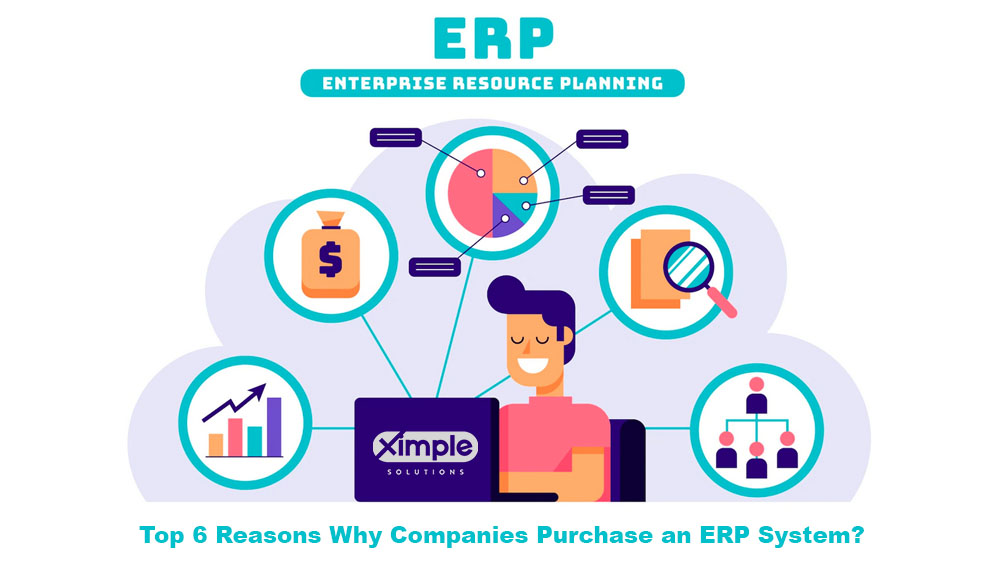

1. Legacy System
Among the most frequent reasons why businesses buy an ERP system is that their current legacy system is not worth the annoyance or cost, and a choice is made that it is time to cut loose. We are increasingly viewing legacy systems that are no longer supported and consequently have outstayed their welcome via stale operation and increased danger of collapse.
Old technologies are often a lot more costly to maintain than newer, lighter systems, from an overall maintenance perspective. Additionally, since the machine platform or code era, it has become more challenging and more costly to discover a support team that is knowledgeable about the obsolete system.
Companies that are still working with legacy systems also see that they may have safety problems, a lack of modern features and performance, and too little flexibility to customize or integrate. The machine becomes a ball and chain for the company to grow.
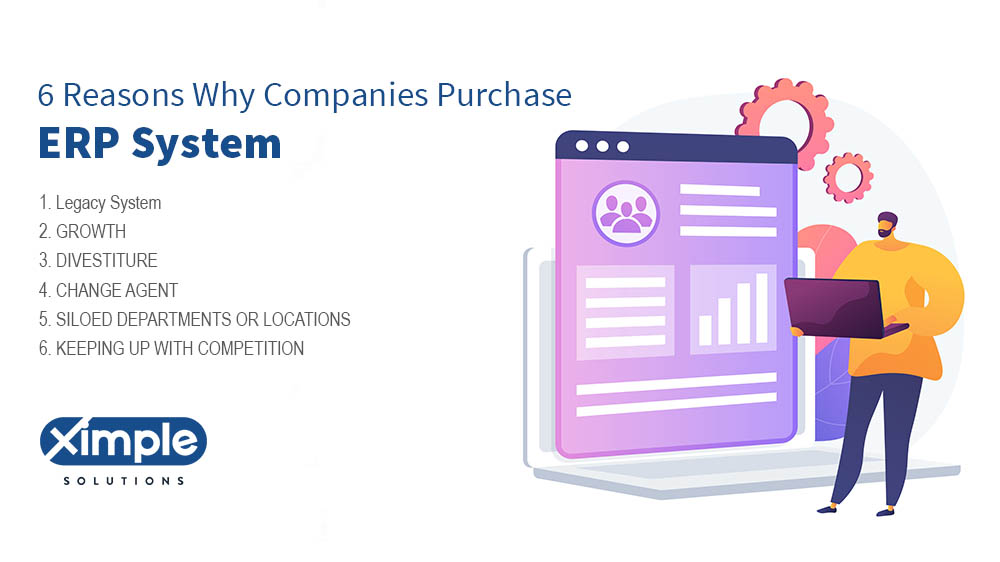

2. GROWTH
Just like how children experience growing pains, so do performing business — it is part of growing up after all. As a company becomes more and more recognized in a current market, it is very likely that preexisting — or base’ — systems and processes are not a fantastic fit.
This expansion, called organic expansion, often requires more than only a straightforward accounting system. During expansion strategy implementation, everyday complexities like handling several places, coping with improved staff communication demands, and also the necessity to better manage processes arise that heritage or fundamental systems cannot manage.
Additionally, as a company grows, so does the value of departmental data management and data flow. The procedure for sharing information across sections becomes a challenge since the data becomes trapped in a section silo and is not readily accessible.
Together with organic expansion, businesses may also experience non-organic expansion such as mergers and acquisitions. An acquisition plan might incorporate a system that may be flexible in embracing and integrating numerous methods of handling and monitoring a business enterprise. That approach may also incorporate a system that’s simple and quick to roll out at recently acquired branches or companies.
3. DIVESTITURE
It is not unusual to find companies seeking to re-focus their surgeries, mainly when a subsidiary of this business is underperforming or does not match with future goals and direction. Even though a subsidiary might be experiencing modest to no expansion for part of the more significant corporation, it might be very beneficial to the market as an independent operation.
For subsidiaries that are very spun off, it’s normal that they need to put money into another sized system and begin with clean information and tailored information fields. In addition, for a business spinning off a branch or merchandise, a new ERP system may ease the change of focus from a service or product, and help to achieve a clean break’.
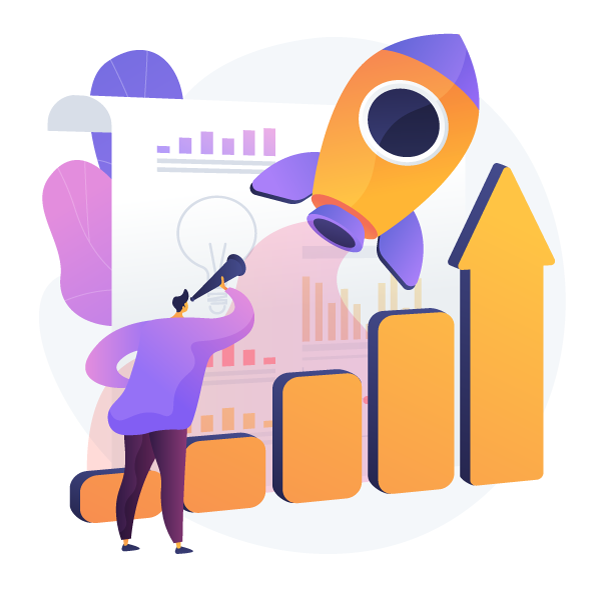

4. CHANGE AGENT
An ERP is a great approach to ease cultural change within a company. Implementing an ERP system puts expectations and boundaries on ‘the way we do things and what is okay. It frequently guarantees a provider grows more accountable with compact internal procedures, and enhanced coverage, and is a chance to decide on a focus on what needs to be monitored inside the business.
Firms experiencing a tactical management change also generally achieve an ERP system. They could be considering changing a product line, or a service line, or even attempting to change the branding of their business – a practice that starts internally.
5. SILOED DEPARTMENTS OR LOCATIONS
ERPs supply vision into inter-departmental pursuits and situational awareness that’s not possible to obtain with no ERP. They allow organizations to use the same information across sections, stamping out the danger full of the time-consuming, cash-wasting exercise of duplicate data entry.
Businesses will also proceed into an ERP whenever they need to set up the government to make sure distributed teams function and operate in the same manner throughout the organization. Risk reduction is found in lessening the incidence of individuals or places performing a similar procedure in vastly different manners.
6. KEEPING UP WITH COMPETITION
An ERP is now a ’must-have’ for any business seeking to stay competitive, as progressively organizations seem to technologies to gain competitive benefits.
Organizations are searching for faster access to data, history, and statistics to make conclusions in a more expedited manner. They are also seeking to enhance the client experience without including extra costs related to greater headcounts.
With countless ERP implementations under their belt, Liberty Technology Advisers understand what to ask and what is reasonable (and ridiculous ) when it concerns the execution and contractual discussions. You would not walk into a restaurant blindfolded and expect you to select the ideal meal for you, so why if you do precisely the same using something as essential as an ERP system?
Posted on
How to identify which is the best ERP?
While it would be nice if there could be a simple and consistent answer to everything, there is not one ERP that really is the best. The better question to ask is ‘What is the best ERP for my business?’ The right ERP is the right fit and it will vary depending on your business, your industry, your size, your budget, and your needs.
What might be the best solution for multinational organizations that will not meet the needs of SMEs that are just getting started?
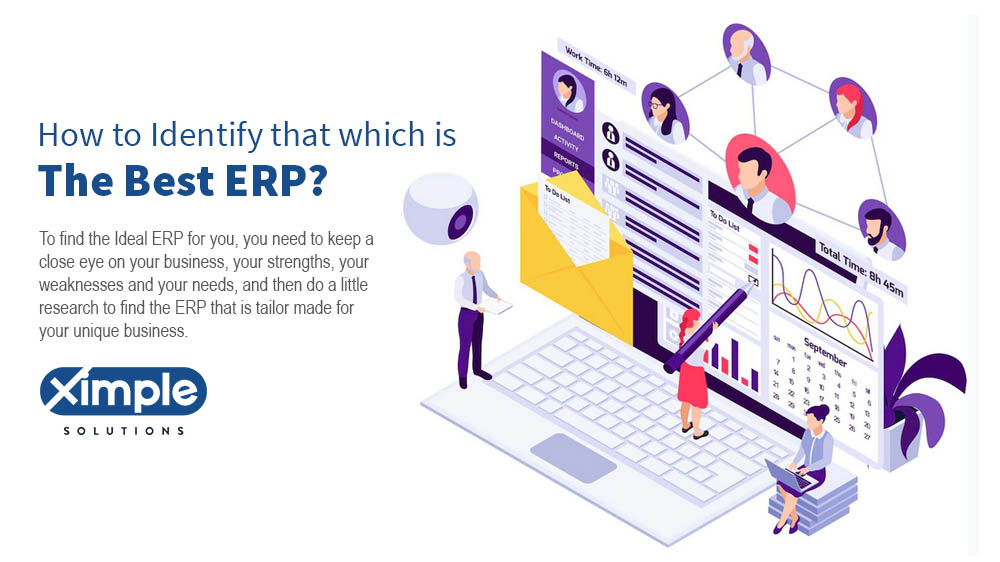

Let’s have a look at how to Identify that which is the Best ERP
- To find the Ideal ERP for you, you need to keep a close eye on your business, your strengths, your weaknesses, and your needs, and then do a little research to find the ERP that is tailor-made for your unique business.
- There were only a few ERP providers in the market for a long time, but today there are ERP vendors for every industry, size, and specialty.
- A good ERP for you will be one that specializes in your business line, and the features you need to improve your business.
YOU ALSO KNOW THAT
- To find a good ERP for you, you need to keep a close eye on your business, your strengths, your weaknesses, and your needs, and then do a little research to find the ERP that is tailor-made for your unique business.
- There were only a few ERP providers in the market for a long time, but today there are ERP vendors for every industry, size, and specialty.
- The best ERP for you will be one that specializes in your business line, and the features you need to improve your business.


Great ERP IS WHAT HELPS YOUR BUSINESS
Before you start researching ERPs and are dazzled by cutting-edge features and sales pitches, sit down with a small, trusted group of people at your company and ask yourself what do we need to improve to be a better business. The best sentence to use for absolute clarity is “We need to improve ______ by ______.”
Maybe you need to improve profits by reducing the cost of raw materials. Maybe you need to minimize errors by specifying procedures.
Once you know what you want, your organization has a specific need to improve your business, then you can start looking for an ERP system with the right features for you.
Posted on
Importance of ERP for Business | Why use ERP?
Along with the worldwide ERP software program market anticipated to be price $41.69 billion by the year 2020, the impact of the systems is clear. Whereas this volume is outstanding, those who have by no means used the PC software program may discover it challenging to know why ERP is critical to their enterprise.
Nonetheless, as globalization dominates {the marketplace} for many companies, it’s vital to search out all instruments to offer your organization an aggressive benefit. For many companies, that is completed by way of utilizing ERP.
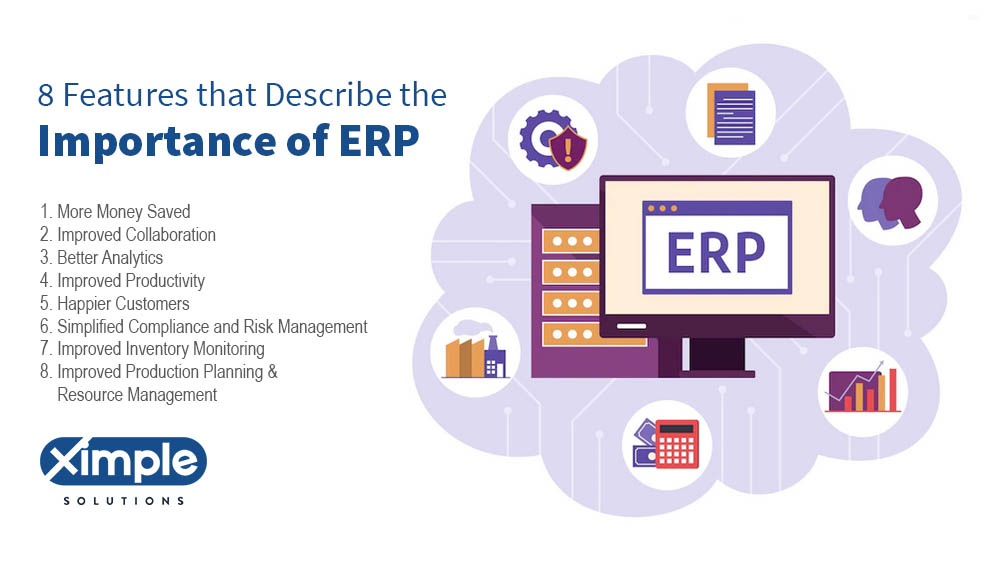

Table of Contents


What are the Uses of ERP?
ERP is widely employed by firms working within the distribution chain to keep track of all of the moving parts of distribution and manufacturing. However, ERP can be used by a lot of different sectors, including people in Purchasing, Sales, Accounting, Inventory, Warehouse, Employee gateway, Operations, etc. Organizations needing to control their employees, inventory, and customers can rely on ERP advantages.
Related articles
Why Use ERP? Importance of ERP
Enterprise resource planning software is used to handle several business purposes, but how can it be better than other alternatives? Though ERP might have similar aims to other options, its specific attributes make it a distinguishing competitor in the applications marketplace.
Here are the 8 reasons why the significance of enterprise resource planning (ERP) systems must be regarded by any company:
1. More Money Saved
- Though a lot of vendors have introduced flexible pricing in the last several years, ERP packages continue to be a large investment. For all, the high costs alone could make it seem improbable that the program will wind up saving your company any money in any way. But when you get past the sticker shock, it is a lot easier to see how ERP can supply a superb ROI.
- To start with, ERP allies quite a lot of the programs that may presently be fragmented in your group. From product growth to accounts payable, your staff can have the flexibility to get all the wanted instruments for his or her venture from a centralized system.
- By consolidating techniques, you help your employees use their time better. With ERP, users do not need to look down a slice of data across multiple programs. Together with the database, data is a lot easier to regain.





See How We Can Help to Reduce Your Operational Costs for Your Wholesale Distribution Business.
Ximple ERP automation improves workflows & processes across the distribution departments which help to reduce operational cost and productivity.
If you want our wholsale distribution business experts at Ximple Solution to help you digitalize your distribution business or upgrade your legacy ERP, just book a call
2. Improved Collaboration
- The qualities of ERP software may vary slightly based on the app you’re using, but all systems enhance collaboration in some manner. As stated earlier, the database is an essential component of what creates an ERP special.
- With this database, you also give your firm with just one source of facts to operate from. This reduces any mistakes caused by using erroneous information, further reducing prices.
- Furthermore, a central database minimizes any hesitation or stalling throughout jobs, since all staff members have access to the company-wide information they require. Additionally, there’s no requirement to unite information across different sources or systems.
- Since each information is accumulated, saved, shared, and accessed via one system, there’s not any concern about the way accurate, complete, or protected the information files are.
3. Better Analytics
- A central database of data also assists in enhancing your reporting and analytics. As ERP documents and stores, all of the information users enter, it makes for a superb company intelligence tool.
- So long as your seller offers strong performance, ERP applications make it simpler and quicker for your team to create many reports. Reports that could take weeks of research and compilation with no ERP take only minutes.
4. Improved Productivity
- With conventional procedures, tedious jobs are unavoidable. Tasks such as creating reports, tracking inventory levels, timesheet processing, and tracking orders have taken workers hours to achieve.
- Along with carrying uptime, these procedures lower worker morale and open yourself up to human error. Following the umpteenth hour of entering the identical line of information into various types, even the very best staff members will definitely make a mistake.
- In the event you pick the best solution, an ERP can automate your most boring tasks. The database inside ERP software removes redundant tasks like data entry and permits the system to do complex calculations within seconds.
- This frees up your staff members’ time to perform more considerate work, raising your ROI when it comes to labor. By doing this, ERP boosts your company’s productivity, efficiency, and endurance.
5. Happier Customers
- Handling your clients has never been so significant. In our electronic age, an increasing number of folks are turning to the World Wide Web to obtain information on what clothing to wear, what food to eat, and how to live their own lives. And with 84% of customers expecting online reviews as far as they would a buddy, previous client remarks are more impactful than ever before.
- The very best method to enhance customer satisfaction is to supply client-centered services and goods. ERP provides this in a couple of various ways. To begin with, many ERPs are outfitted with a client relationship management (CRM) tool or can be readily incorporated with you. Having an ERP, your CRM has access to information across company purposes.
- Together with contact info, an integrated CRM can reveal information like order history and charging info. This allows your team to view your own customers more to acquire a better comprehension of their needs and requirements. The higher customer visibility makes it possible to invent your revenue strategy for enhanced lead generation.
6. Simplified Compliance and Risk Management
- As firms grow and do business in different states, it can be hard to keep track of all of the various regulations imposed on your company. Even local companies will need to fret about different environmental, data security, and human resources regulations.
- Fortunately, lots of ERP offerings are constructed with all these regulations in mind that will assist you in maintaining compliance at each stage. Additionally, ERP applications offer built-in auditing programs to help with assigning things like compound usage and tax provisions. This makes it unbelievably simple to invent reports and send them to the applicable governing body.
- Furthermore, ERP frequently provides tools to control risk. This solution improved the accuracy and reliability of general financial management as there’s less opportunity for errors throughout bookkeeping.
- Forecasting tools also enable users to forecast events as soon as it comes to demand, labor, and price range. With this data in hand, you can produce more secure budgets, programs, and product development strategies.
7. Improved Inventory Monitoring
- A significant challenge for growing businesses is monitoring and tracking their expanding stock amounts. ERP uses barcoding, RFID tags, and sequential numbers to keep tabs on your stock at each stage through the distribution chain.
- These tools help you keep costs on stock levels at several warehouses, which things have been in transport, and which items are on the shelves ready for customers. The greater warehouse visibility optimizes the selection, packing, and shipping procedure significantly, eliminating all of the guesswork.
- Inventory monitoring additionally strengthens reporting, as monitoring technologies provide more precise numbers. Users may configure customized KPIs to determine which goods move the quickest demonstrating greater need and which raise carrying costs.
- Together with the greater accuracy provided by ERP, warehouse supervisors may get real-time information on their stock to make more accurate business decisions.
8. Improved Production Planning and Resource Management
- Together with managing the inventory, ERP additionally manages to fabricate. ERP offers insight into all production operations, including the store floor. This permits users to maximize production programs, labor, and equipment to optimize capacity.
- Furthermore, ERP oversees your Bill of Materials (BOM) and adjusted assets. With this application, users can quickly create and edit BOMs together while keeping an eye on previous changes.
- Fixed asset management lets users schedule equipment maintenance to decrease sudden downtime, enhancing your endurance and supply chain connections.
Conclusion
The significance of ERP far outweighs the initial cost, effort, and time involved with execution if you opt for the ideal solution. Watch our ERP Buyer’s Guide to learn more about functions and features, implementation objectives, and questions to ask sellers.
With sufficient careful study and thoughtful consideration, you will locate ERP applications that provide all of the advantages listed above, painting an image of why ERP is significant to a corporation.
Related articles
Posted on
Enterprise Resource Planning – ERP
- Enterprise resource planning (ERP) is generally known as a type of company management application, typically a package of integrated software that a company may use to gather, store, handle, and interpret data from several small business tasks.
- Enterprise Resource Planning provides an integrated and continuously updated view of core business procedures using shared databases maintained by a database management program.
- ERP systems monitor company resources such as money, raw materials, manufacturing capacity, and also the standing of company responsibilities: orders, purchase orders, and payroll.
- The software that forms the system shares information across different sections (manufacturing, buying, accounting, sales, etc.) that offer the information.
Table of Contents
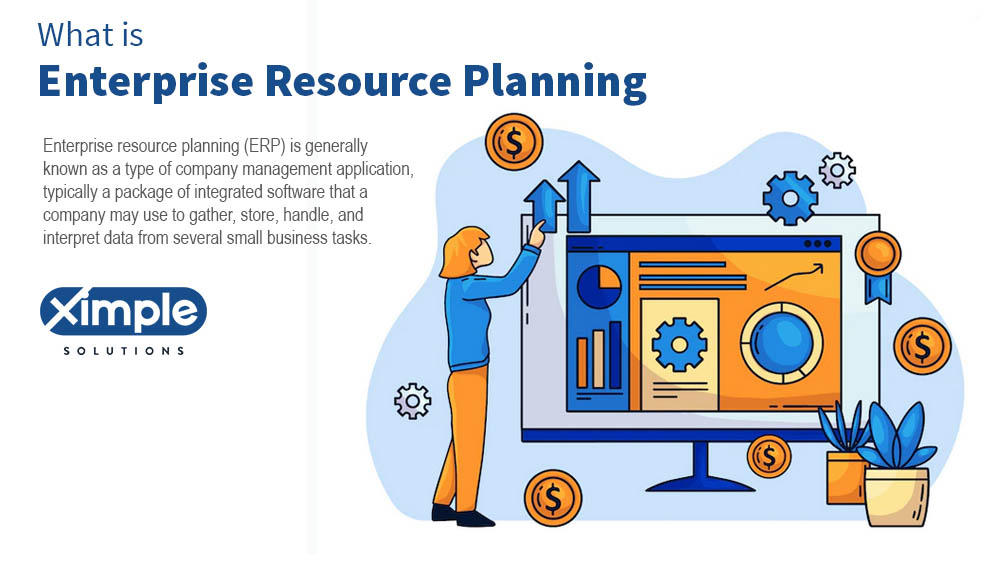

ERP Functional Areas of Management
In Enterprise Resource Planning systems, Below are Functional Areas of Management:
Financial Systems :
General ledger, fixed assets, payable including vouching, matching and payment, receivables, and collections, cash management, and financial consolidation.
Purchase :
Purchase Orders and contracts, Invoices, Tracking and aging, RPO, Vendor Relations, Goods Received Management, Back Order Report, Links to Updated Prices and Products.
Operations :
Workflow & Business Rules, Activities & Approvals Business Intelligence, Role-specific, Dashboards Document, Management Real-Time Solution.
Accounting :
Budgeting, Costing, Cost Management, Activity-Based Costing.
Human Resources :
Recruiting, Training, Rostering, Payroll, Benefits, Retirement, Pension Plans, Diversity Management, Retirement, Separation.
eCommerce :
View your inventory, Get pricing as if they were at the store, Place orders and quotes, View past orders and trace open orders, Generate current statements, Keep track of multiple jobs, and Start a return.
Manufacturing :
Engineering, bill of materials, work orders, scheduling, capacity, workflow management, quality control, manufacturing process, manufacturing projects, manufacturing flow, and product life cycle management.
Sales :
Sales Quotes and contracts, Order Entry, Lot Orders, Discount Layers, Payment Terms Automation, Opportunity Management, Return Management, and Authorization.
Order Processing :
Order to cash, order entry, credit checking, pricing, available to promise, inventory, shipping, sales analysis, reporting, and sales commissioning.
Warehouse :
Easy receipt entry of goods, Automated and manual transfers between distribution centers, Comprehensive shipment management, Setup of delivery routes, and Notified customers on shipment.
Inventory :
Multi-organization & Location Costing Flexibility Inventory Allocations & Transfers Non-inventory Cost of Sales Warehouse Management.
Vendor :
EDI Point of Sales Point of Transfer SPAs SPJs Vendor Pricing Updates Goods Issues Buying Groups.
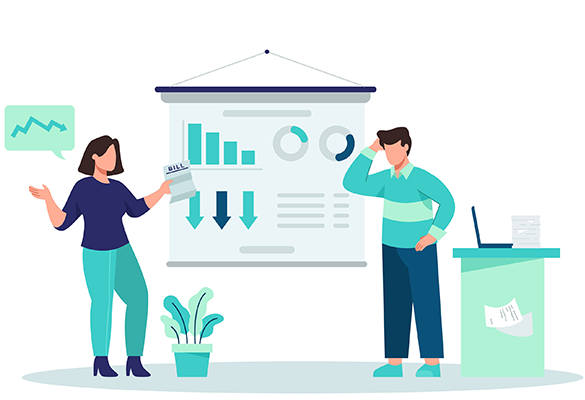

- Sales forecasting, which allows inventory optimization.
- Matching purchase orders (what was ordered), inventory receipts (what arrived), and costing (what the vendor invoiced).
- Revenue tracking, from invoice through cash receipt.
- Provides a comprehensive enterprise view, making real-time information available to management anywhere, anytime to make proper decisions.
- Order tracking, from acceptance through fulfillment.
- Chronological history of every transaction through relevant data compilation in every area of operation.
- Facilitates standard product naming/coding.
- Protects sensitive data by consolidating multiple security systems into a single structure and brings legitimacy and transparency to each bit of statistical data.
Primary Business Benefits of an ERP System
- ERP creates a more agile company that adapts better to change. It also makes a company more flexible and less rigidly structured so organization components operate more cohesively, enhancing the business—internally and externally.
- ERP can improve data security in a closed environment. A common control system, such as the kind offered by ERP systems, allows organizations the ability to more easily ensure key company data is not compromised. This changes, however, with a more open environment, requiring further scrutiny of ERP security features and internal company policies regarding security.
- ERP provides increased opportunities for collaboration. Data takes many forms in the modern enterprise, including documents, files, forms, audio and video, and emails. Often, each data medium has its own mechanism for allowing collaboration. ERP provides a collaborative platform that lets employees spend more time collaborating on content rather than mastering the learning curve of communicating in various formats across distributed systems.
- ERP offers many benefits such as standardization of common processes, one integrated system, standardized reporting, improved key performance indicators (KPI), and access to common data. One of the key benefits of ERP; the concept of the integrated system, is often misinterpreted by the business. ERP is a centralized system that provides tight integration with all major enterprise functions be it HR, planning, procurement, sales, customer relations, finance, or analytics, as well as other connected application functions. In that sense, ERP could be described as a “Centralized Integrated Enterprise System (CIES)”
“At Ximple, we constantly upgrade our software to the newest and the most advanced technology. We have integrated the most cost-efficient payment processing module that has proved to guarantee raise in profits along with impeccable customer satisfaction”
Posted on
How does Credit Card Processing ERP Affect Your Business?
Let’s find it out The Power of B2B Credit Card Processing in ERP Affects Your Business guarantees High-Profit returns.
Speed is something that cannot be compromised in today’s age. We have understood the power and capability of simple credit cards that we seldom use when we go to a supermarket or get meals.
However, from the B2B business’s point of view, we have many inefficiencies and higher processing prices for credit card integration.
Clunky and pricey credit card processing is weighing down your team. Therefore it’s time to include a payment gateway that is derived from the most suitable Cloud ERP Program.
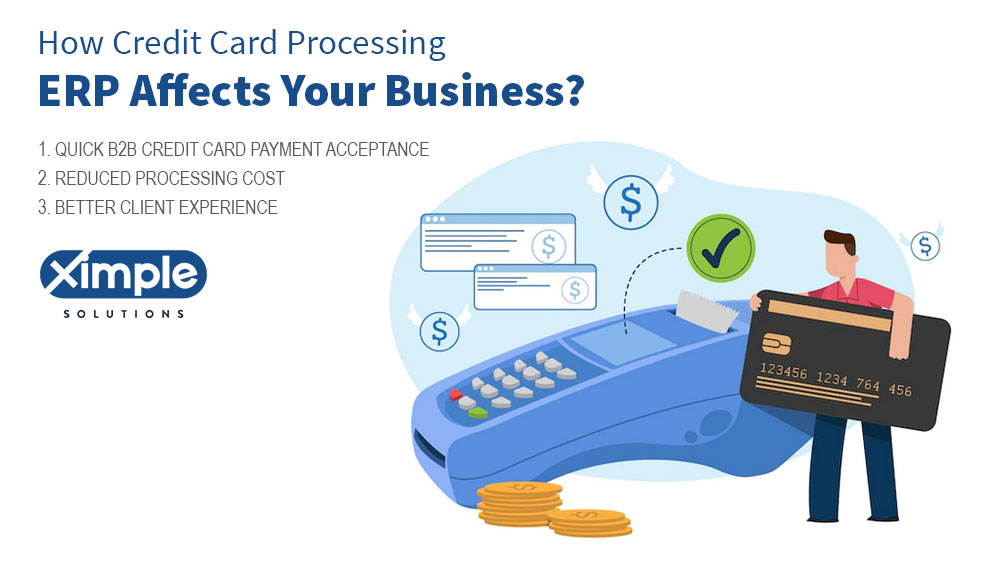

Listed below are the finest few reasons why you should use Ximple charge card integration to approach your payments :
Table of Contents


1. QUICK B2B CREDIT CARD PAYMENT ACCEPTANCE
- Our B2B Credit card processing is considerably a lot more complex than B2C credit card processing, we make B2B Cloud-Based Credit Card processing Simple.
- Producers, distributors, and wholesalers often don’t interact with the client. Instead, they take credit card orders on the World Wide Web, via the mail, or on the phone.
- These distant transactions call for a good deal of data entry, which adds up to lots of missing time and ensures fast transactions.
- Payment integrations Permit You to accept credit cards Interior Ximple Cloud ERP without having to change to a different application. They also save customer payment information about protected, offsite, and PCI-compliant servers, which means that you can quickly pull their data for duplicate orders, which saves time.
2. REDUCED PROCESSING COST
- Card processing charges are greater for B2B businesses than B2C Businesses, in substantial part because of the increased risk related to B2B.
- To account for this higher financial risk, banks put higher processing charges for B2B.
- ERP Card integrations can substantially lower these trade Prices for B2B businesses. Integrations mechanically pull trade details from Ximple and furnish them at the time of this trade.
- This extra information better ensures the safety of B2B transactions and leads to reduced processing fees.
3. BETTER CLIENT EXPERIENCE
- Payments from the Customers are not Disruptive or time-consuming procedures.
- Invoicing portals Enhance the collection encounter by You begin by uploading customer invoices into a secure online portal from Ximple.
- Customers can utilize any wise device to log into the internet portal site and pay down their invoices in their advantage. Paid invoices digitally revert back to Ximple and upgrade your AR and GL.
- A fantastic feature that enriches customer interaction is email Pay, which lets you send email invoices to customers from inside Ximple Cloud Credit Card Processing ERP Affects Your Business.
Conclusion
“At Ximple, we constantly upgrade our software to the newest and the most advanced technology. We have integrated the most cost-efficient payment processing module that has proved guaranteed rise in profits along with impeccable customer satisfaction”
Posted on
What are Cloud Computing Services? Cloud Computing at a Glance
Cloud computing services date back to the 1950s when mainframe computers came into existence. Cloud computing had just started with mainframe computers being hosted via dummy portals to a central computing system. This technology further came into the limelight in the 1990s when the concept of virtualization was introduced and expanded…
The cloud services that we have today is the result of the increasing demand and evolution of this technology.
So what exactly is today’s modern-day cloud computing?
How has this technology that started with mainframe computers being centrally hosted become an integral part of today’s digital world? And how does it evolve continuously?
Let’s have cloud computing at a glance
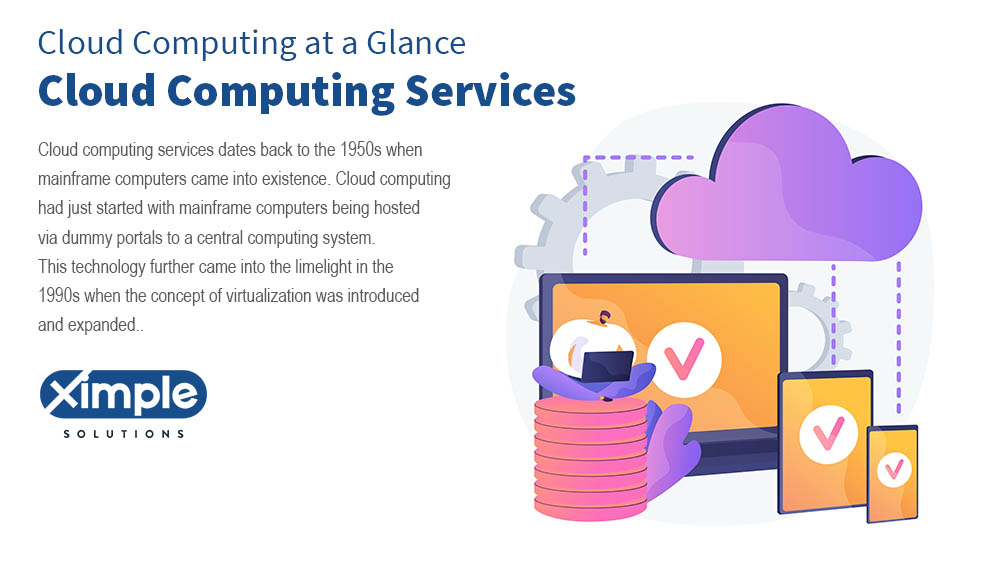

What exactly are cloud technology services in today’s time?
Need for cloud technology to evolve: As per statistics
- Enterprise workloads are dependent on cloud technology in 2020
- Enterprises already use a cloud service.
- All IT budgets are allocated to cloud computing.
- Enterprises already have a central cloud team or a cloud center of excellence.
Therefore, cloud service providers have to constantly keep themselves updated with the latest and the best technology to keep up to the market standards.
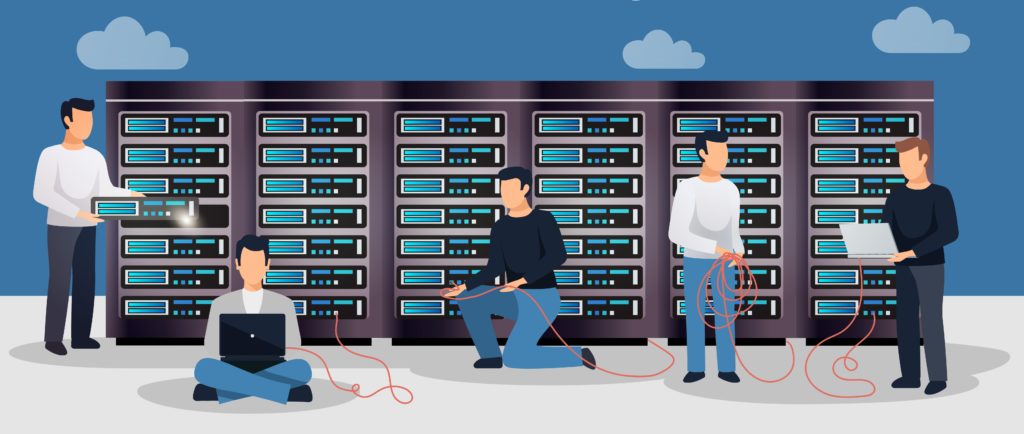

Over 2.5 quintillion bytes of data are created every single day servers and data centers must match up to the best processing power and must be provided with high maintenance.
The data centers must have adequate backups in case of a server failure or any loss of data from one data center. Thus cloud technology evolves every single day.
With hackers who figure out various loopholes to break into the system, new security mechanisms are to be adapted every single day. Thus cloud technology evolves every single day.
So why choose Ximple Solution’s cloud technology-based ERP services?
As our customers make use of our ERP services as they embark on their journey to the cloud, we’ve got their back always. From on-premise solutions to public and private ERP cloud deployments,
- Our unique way of understanding the client’s needs
- An unprecedented range of domain services
- The most flexible and scalable cloud-based solutions on the market
- We provide an enhanced overall cloud experience for all businesses.
Ximple solution’s Cloud-based ERP solutions provide multiple deployment models with a Cloud-Connected desktop using our products hosted over the cloud. We match up to the pace of the evolution the cloud technology.
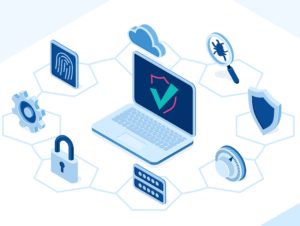

Our cloud-based ERP services are highly secure with multiple layers of complex security mechanisms and no one but only our authorized staff has access to our data centers. This makes it impossible for any unauthorized person to break into our system..
We help enlighten organizations with advanced industry insight and an improved overall digital transformation experience, we do so not only with superior performance and expertise – but in Evaluation, Purchasing, Onboarding, Security, and dedicated Customer Support
Using Ximple solution’s cloud services means you can move faster on projects and transactions without lengthy procurement and big upfront costs. At Ximple Solutions, we know ERP and cloud systems. And, we understand the business and market of today’s world.
Cloud Computing at a glance: If you’re still wondering why do you need Cloud-based technologies in your business?
1. In today’s ever-changing business climate, business owners must get what they need right when they need it. The cloud enables businesses with mobile access to data and helps them be more competitive within their market.
2. Cloud-based solutions are ideal for businesses with growing and fluctuating bandwidth demands. If your business demands increase, you could easily increase your cloud capacity without having to take a position in physical infrastructure. This level of agility can give businesses using cloud computing a true advantage over competitors.
3 Cloud computing services could seem intimidating and “only meant” for larger businesses or corporations. However, this isn’t true; cloud computing is extremely important for small-scale businesses, too. Cloud computing has brought new opportunities for small-scale businesses so that they can grow their business on a worldwide scale.
FAQ
1. What are the 3 types of cloud computing?
Three kinds of cloud computing solutions include the following:
- IaaS – It refers to the Infrastructure-as-a-Service. In short, Infrastructure-as-a-service becomes active when a third party manages your servers, data storage, networks, and related things via the Internet. As a user, you will access your business resources using a dashboard or an API. Thus, you will pay the third-party service provider to store your data resources in the cloud. They will carry out all the maintenance work and upgrades and handle technical problems.
- PaaS – The meaning of PaaS is Platform as a Service. A third-party cloud service provider provides an application software platform and hardware. However, the user is responsible for handling all the apps running on the platform and the data they use. Thus, PaaS is an option for educated and experienced programmers or developers. They can run a shared application development cloud platform.
- SaaS – The meaning of SaaS is Software as a Service.As the name suggests, the service delivers a software tool from the service provider.SaaS can be mobile app-based or internet-based applications. Either way, users need to access it using a web browser. As in the case of IaaS, the SaaS provider carries out all the maintenance and repair work.
2. What is cloud computing with examples?
Cloud refers to the internet. Computing refers to the infrastructural systems that enable PCs to interact with information. Instead of hosting these systems on hard drives or a premise-based server, cloud computing stores these on a web-based server. Cloud computing examples include many applications. Some of these are:
- Medical care – Doctors can share the results of their diagnoses from any place via cloud computing. It eliminates delays and inefficiencies.
- Distant learning – How do universities offer distance learning courses nowadays? They do it via cloud computing, allowing them to teach worldwide students.
- Public institutions – Government institutions, such as the military, were the earliest adopters of cloud computing. Besides boosting remote communication between parties, government-based cloud computing includes advanced analytics technologies.
- Communication – How do we access WhatsApp, emails, and related tools? Cloud computing provides the correct infrastructure for that.
- Business management – This is where software platforms like ERP come in. Many businesses are now shifting to cloud ERP to run their affairs remotely.
- Storage – To synchronize files from devices, you can use cloud computing tools like Dropbox and Gmail and a social networking platform like Facebook.
- Storage of citizen data – Cloud computing does not only make storage of citizen data possible. It can also help us check the current status of various citizen applications.
3. What will 3 years of cloud computing look like?
In like three years, what will cloud computing be like? Although moving business resources to the cloud is popular now, the revolution might not happen as fast as we expect. According to experts, cloud computing might grow at the same rate as the internet and computer technology. While changes will finally come, they will not take the mass migration route.
Cloud security will improve in the next three years, but it might still be a concern. However, large cloud service providers will offer beefed-up in-cloud security features. As for the management and governance of the cloud, the resources will be in place in the next three years. Most tiered data will be on massive public clouds, but some private and community clouds might crop up to help control partially private data.
4. What are the benefits of Cloud computing?
Cloud computing has several benefits. One of the main advantages of shifting your data to the cloud is high savings. As the service provider will manage and maintain the servers and take care of upgrades, you need no equipment or technical knowledge. Also, cloud computing can offer these other benefits:
- Regular software updates without paying more money
- Few or no downtimes depending on the service provider you select
- Easier compatibility between various operating systems
- Robust data backup and recovery techniques
- Boost performance and the company’s ability to scale and expand
- Adequate data storage capacity and strong security.
Posted on
What is INDUSTRY 4.0 ERP? INDUSTRY 4.0 and ERP
This article is relevant to anyone interested in Industry 4.0 and ERP technology, particularly those in the manufacturing, wholesale, and distribution businesses. It provides an overview of the different Industry 4.0 technologies, including IoT, simulation, horizontal and vertical integration, cloud computing, additive manufacturing, augmented reality, big data and analytics, and cyber-physical systems, and how they can be integrated with ERP systems. The article also discusses the benefits of adopting Industry 4.0 technologies and integrated ERP systems, and how cloud-based solutions can simplify implementation and maintenance.
Industry 4.0 is a new stage in the industry that concentrates on interconnectivity, automation, machine learning, and real-time data. It is investing in technology and tools to enhance manufacturing and distribution efficiency and effectiveness. It is about revolutionizing the way business operates and grows by applying real-time data and information interconnected by IoT sensors.
The benefits of integrating Industry 4.0 technologies and ERP systems will be very high, especially in support of intelligent machines and processes, data analytics, and modeling, which can help companies in the real-time decision-making process. Modern ERP systems support Cyber-Physical Systems, which lead to feature end-to-end vertical integration, from inbound logistics, planning, and marketing to outbound logistics, and services.
Industry 4.0 ERP systems’ role has changed from a central database system that collects data to supporting mobile role-based user interactions. Legacy ERP systems need to be redesigned or replaced for Industry 4.0 for the FoF (Factory of Future). It will require real-time two-way communication between machines, processes, and products.
Table of Contents
- Simulation
- Horizontal and Vertical Integration
- Cloud Computing
- Additive Manufacturing
- Augmented Reality
- Internet of Things
- Big Data and Analytics
- Cyber-physical systems
- Benefits of Adopting an Industry 4.0 technologies
- Industry 4.0 and Cloud-based ERP technology
- Distributors and Wholesalers Cloud ERP: Industry 4.0
Industry 4.0 contains nine technologies, and each of them is related to the ERP systems; somehow, some are analyzed below.
The Internet of Things (IoT) is the first industry 4.0 technology, which should be supported by ERP systems. IoT is an integration point of Industry 4.0 and ERP. Nowadays, in most cases, data from manufacturing, Warehouses, production planning, distribution, quality control, processes, and other sources are entered manually into ERP systems. The use of IoT would help automatically enter data into ERP systems, which are collected from different production sources. This would have the effect of eliminating data entry errors. Entering data through the use of IoT equipment would also help in changing the approach to ERP systems.
Simulation
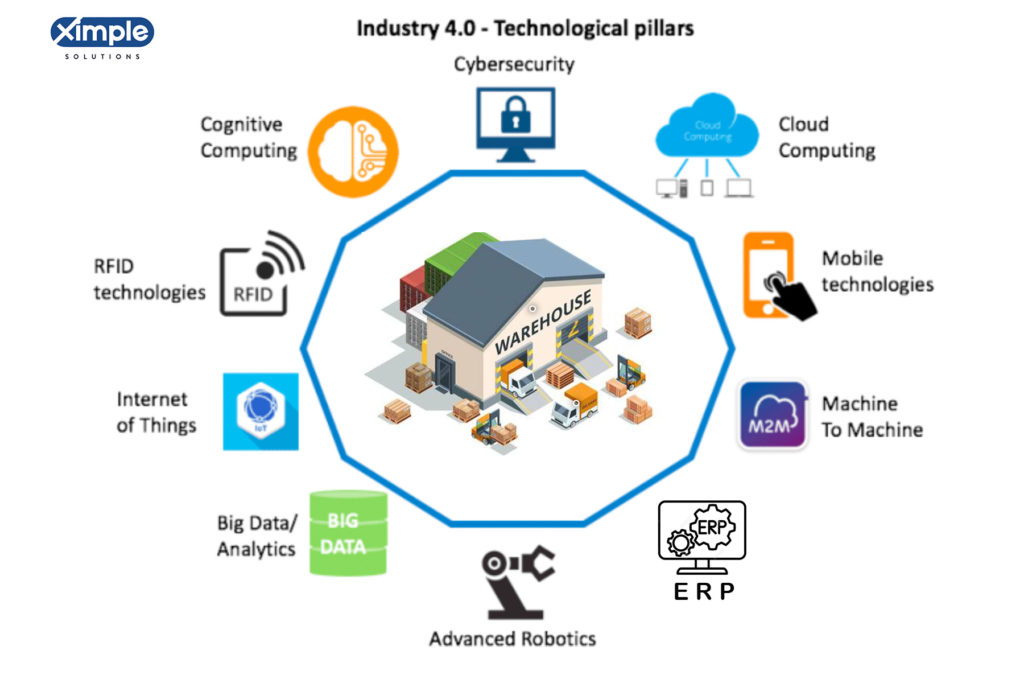

A simulation is a tool for predicting and evaluating the performance of systems. It helps companies optimize the decision-making process, which provides the “smart brain” required to improve industrial systems’ efficiency. Companies can simulate real-world situations in a virtual model to help companies optimize products and places in the virtual world before the physical setup.
Simulation can relate to ERP through Big Data Analytics for predicting and evaluating the performance of systems that optimize the resources.
Horizontal and Vertical Integration of INDUSTRY 4.0 ERP
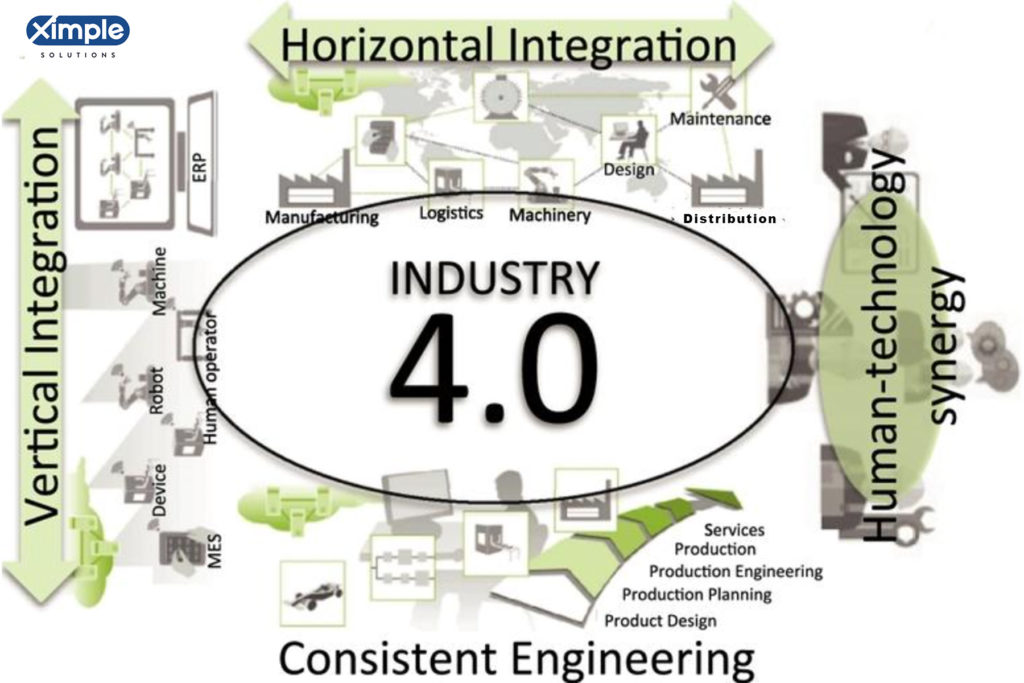

Horizontal integration implies the connection between all the value chain components, starting from internal company logistics, production, distribution, sales, and services, to external partners, suppliers, customers, and energy suppliers to create a value chain as autonomously acting participants.
Vertical integration connects different company levels with IT systems in production, distribution manufacturing, and low-level PLC (Programmable Logic Controller) machine controllers & sensors within the company to increase flexibility and performance in planning management.
By using the Horizontal and Vertical integration approach supported by ERP systems, autonomous production methods can be powered by Robots that can complete tasks intelligently, with a focus on safety, flexibility, versatility, and collaboration. This integration would be a benefit in generating value for customers, creating a new competitive environment, and increasing company productivity, and global economic growth.
Cloud Computing
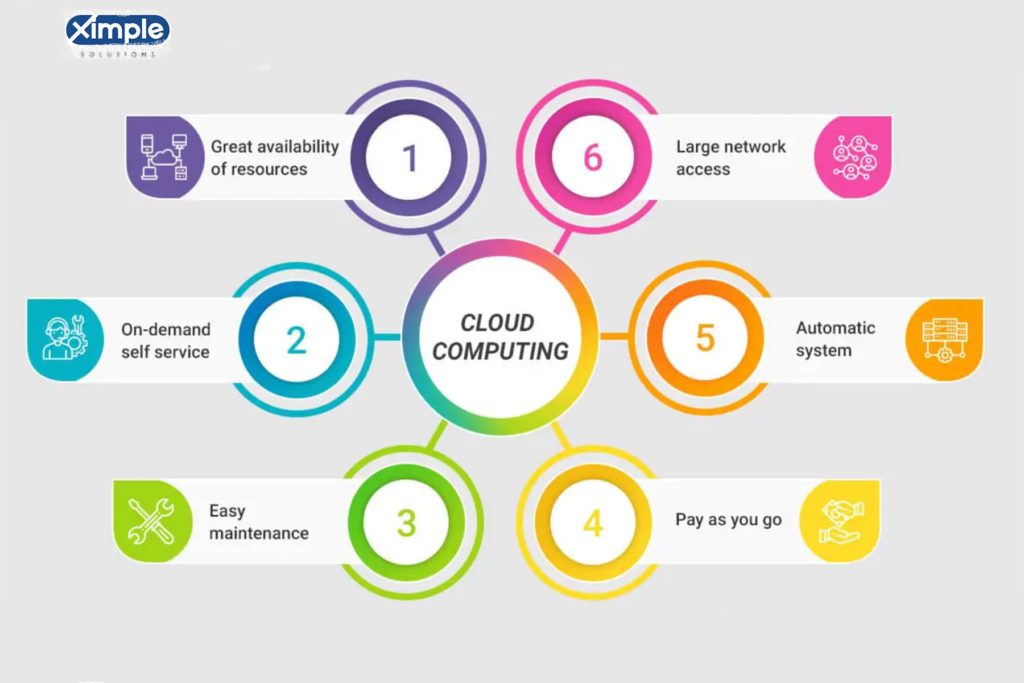

Cloud computing is defined as an Internet-based service or IT infrastructure, starting from applications delivered as a service or hardware and software in the data centers. The Cloud computing is divided into three categories.
1. Software as a service (SaaS): a software model where a provider licenses an application delivered over the internet.
2. Platform as a service (PaaS): a software development framework and components delivered on the network. The PaaS model is a platform that includes an operating system, programming language execution environment, database, and web server. A PaaS client can develop and run its applications at the software layer.
3. Infrastructure as a service (IaaS): an integrated environment of computing resources, storage, and network fabric delivered over the network. Offered as an on-demand, pay-for-usage model.
Additive Manufacturing
Additive Manufacturing is a technology that allows companies to produce a prototype, individual components, and 3-D printing. “With Industry 4.0, additive-manufacturing methods will be widely used to produce small batches of customized products that offer construction advantages, such as complex, lightweight designs. High-performance, decentralized additive manufacturing systems will reduce transport distances and stock on hand“.
Augmented Reality (AR)
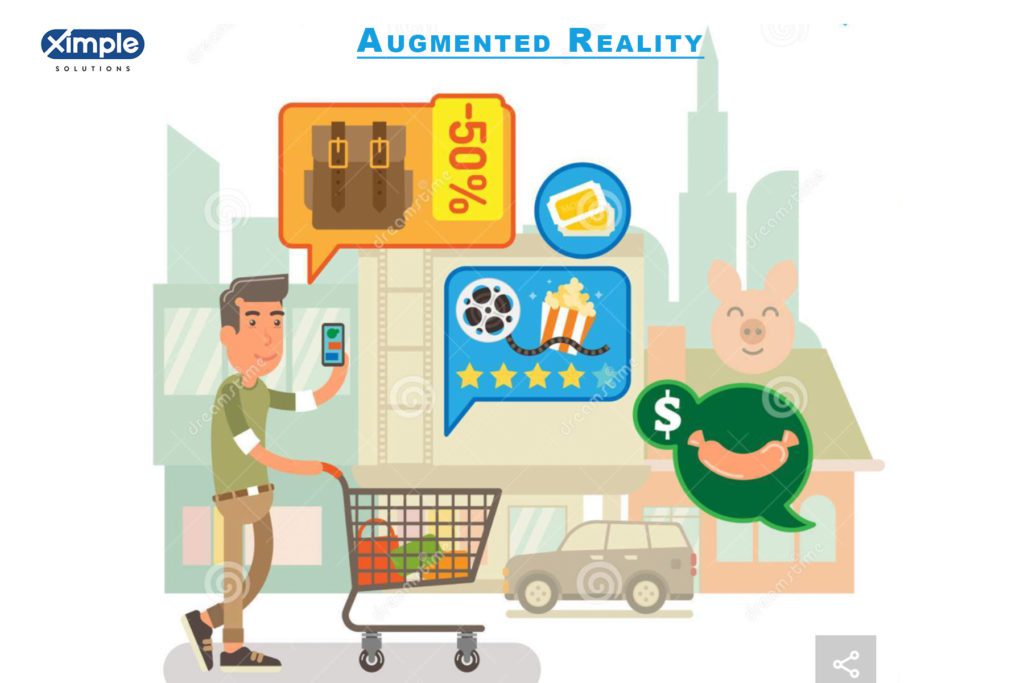

It can combine the physical, and real-world environment information by adding virtual data generated by computers. The main advantage of AR is the ability to integrate the virtual environment and real-world interaction. Augmented Reality-based systems nowadays are used in different aspects in a real-time situation, starting from warehouses, and maintenance instructions, which helps the users of this technology improve decision-making and work procedures.
It can use data stored in the INDUSTRY 4.0 ERP system and choose accurate information for boosting it for scene processing and visualization of the augmented scene.
Internet of Things
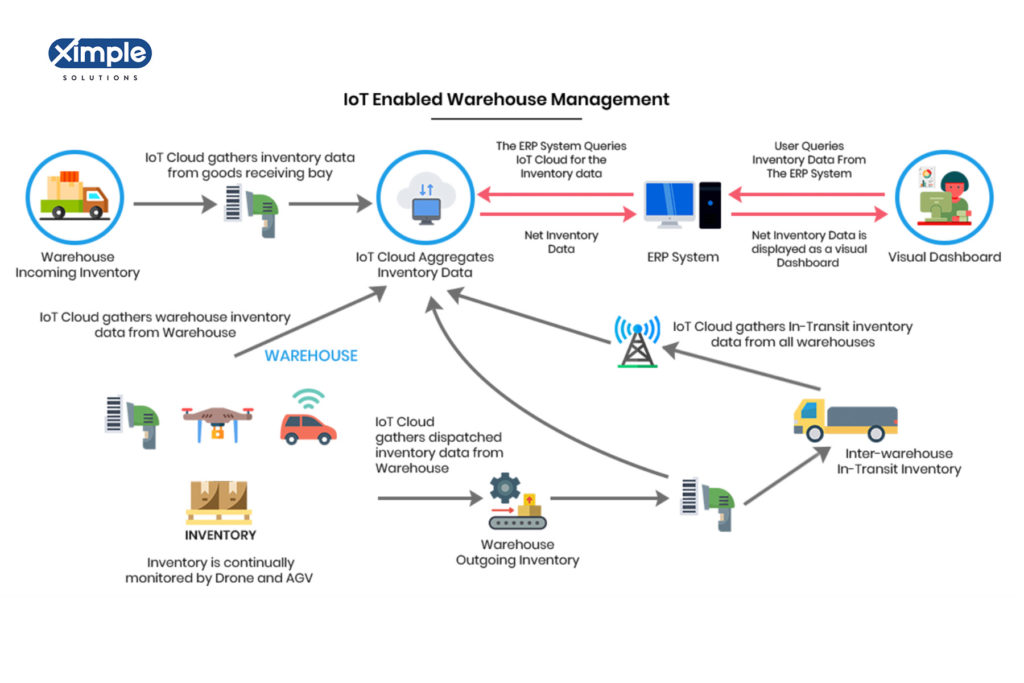

There are many reasons to apply the Internet of Things in the Industrial fields. The companies can reduce the cost of operation and prevent the production line’s failure or stoppage in the future. The companies gain extra profit via service-oriented production system, and the managers’ needs will be satisfied for easier decision making”. The application of Internet of Things devices can contribute to the data reading and transferring to the central databases; simultaneously; this equipment allows automatization of the data entry, which reduces data entry errors and data processing time.
Big Data and Analytics
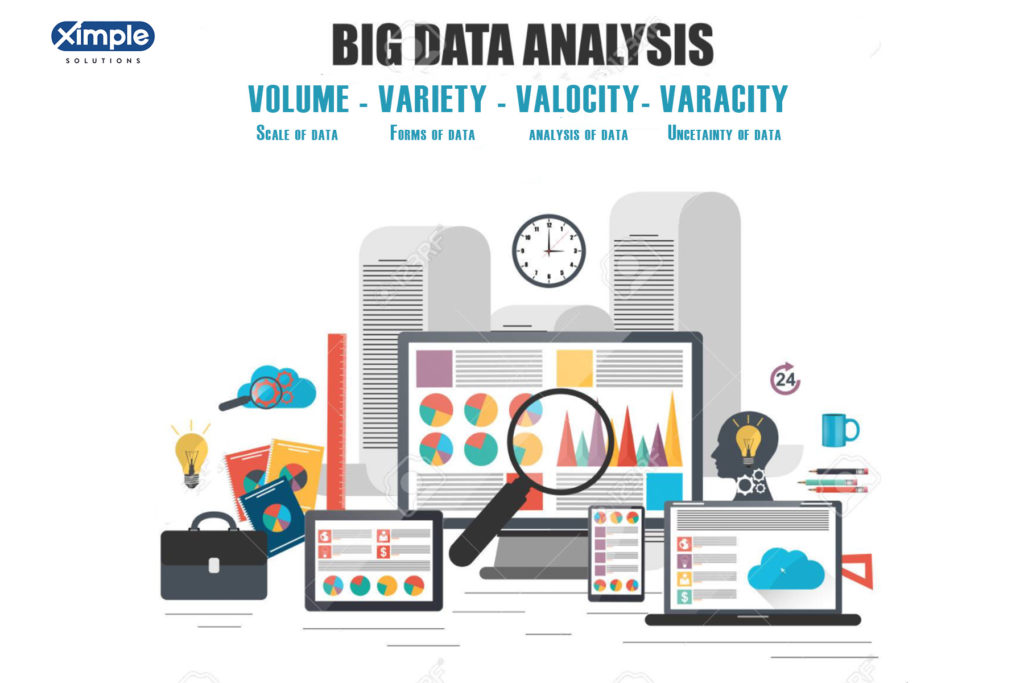

Big data can help companies analyze the past, and present, and predict the future using an analytical application to generate value from the available data. There is a link between ERP and Big Data Analytics and the other technologies of Industry 4.0. With Big Data Analytics, ERP systems can enable the collection and evaluation of data from different sources in real-time. They can help in decision-making, quality control, optimizing costs, and other aspects.
Cyber-physical systems (CPS)
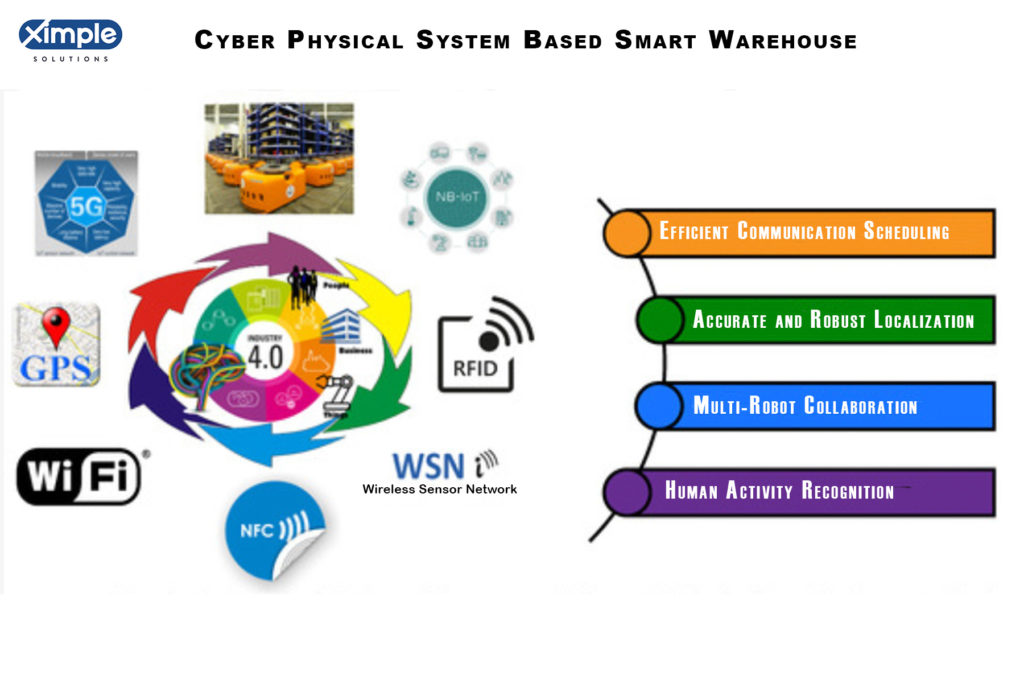

Cyber-physical systems, also sometimes known as cyber distribution, refer to an Industry 4.0-enabled distribution environment that provides real-time information collection, evaluation, and transparency in every part of a distribution operation.
Benefits of Adopting Industry 4.0 technologies and integration with ERP
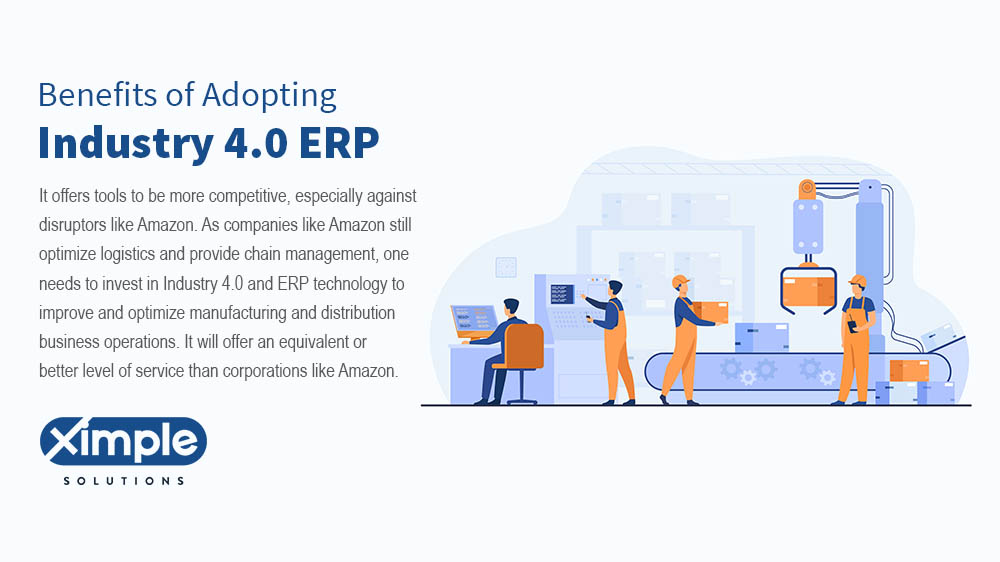

It offers tools to be more competitive, especially against disruptors like Amazon. As companies like Amazon still optimize logistics and provide chain management, one needs to invest in Industry 4.0 and ERP technology to improve and optimize manufacturing and distribution business operations. It will offer an equivalent or better level of service than corporations like Amazon.
It offers a competitive edge to hiring a talented young workforce. Companies that invest in modern, innovative Industry 4.0 technologies and Modern Cloud-based ERP are better positioned to draw in and retain new workers.
Companies that invest in Industry 4.0 and Modern Distribution ERP solutions can increase efficiency, boost collaboration between departments, enable predictive and prescriptive analytics, and permit people, including operators, managers, and executives, to more fully leverage real-time data and intelligence to form better decisions while managing their day-to-day responsibilities.
Industry 4.0 Integrated ERP allows dealing with potential issues before they become big problems. Predictive analytics, real-time data, internet-connected machinery, and automation can all assist in being more proactive when it involves addressing and solving potential maintenance and provide chain management issues. Top-rated Distribution and Wholesale ERP with Industry 4.0 trims costs, boost profits, and fuel growth. Industry 4.0 technologies optimize all aspects of the manufacturing, wholesale, and distribution business. It gives real-time access to real-time data and insights for smarter, faster decisions about distribution and manufacturing business, which may ultimately boost the entire operation’s efficiency and profitability.
Can we have the resources and staff to implement and manage Industry 4.0 and Cloud-based ERP technology?
Cloud-based technologies and ERP do not need a large IT team to manage and maintain systems. Even regular updates and maintenance are performed by the service provider. Legacy ERP systems have massive implementation and upgrade challenges. This challenge could be easily overcome by leveraging cloud-based Distribution and Wholesale ERP or software as a service (SaaS) or Platform as Service (PaaS). Like cloud storage, the cloud ERP provider assumes the prices otherwise borne by IT to create and maintain infrastructure. A cloud-based ERP system provides all of the advantages of ERP without requiring dedicated IT infrastructure or staff and frees those resources to be utilized in other IT tasks.
FAQ about INDUSTRY 4.0
What are Industry 4.0 technologies?
The meaning of Industry 4.0 is the fourth industrial revolution. Thus, there were the first, second, and third industrial revolutions before the fourth one emerged. Industry 4.0 entails cyber systems and technologies. So it includes the Internet of Things (IoT), cyber-physical systems (CPS), cloud computing, AI (artificial intelligence), cognitive computing, and smart factories and manufacturing. Industry 4.0 technologies allow automation in the manufacturing sector by creating factory machines with Wi-Fi connectivity and sensors for monitoring and visualization.
Is Industry 4.0 Software?
Industry 4.0 is a software solution that automates manufacturing to enhance efficiency, safety, customer experiences, and problem-solving. It refers to digital technologies. This technology allows you to monitor your production process at every stage via sensors that provide real-time information. Industry 4.0 does not include robotics, but it can connect robots to work together or put them in different areas of the production process.
What are Industry 4.0 applications?
Industry 4.0 has many applications in the modern world. Meanwhile, it allows companies to automate administrative tasks to ensure that humans no longer handle these repetitive jobs. Machines and software can reduce human errors like duplication, incorrect data, omissions, and outdated data.
As we said earlier, Industry 4.0 technologies facilitate manufacturing work by installing wireless sensors on factory machines to monitor and gather data. Thus, you can track, identify, and correct issues before they worsen. The Industrial Internet of Things is possible due to Industry 4.0 technologies.
Industry 4.0 also has applications in intelligent processes where machines can analyze data and predict when to maintain it. They can even reserve a technician to help with the repairs. An advanced analytic software tool can help us mine data to pinpoint the most efficient product and maintenance scenarios.
With an Electronic Data Interchange system, companies can exchange documents electronically rather than manually. That’s because Industry 4.0 allows the integration of computer networks and connecting products to the internet.
Is your ERP ready for Industry 4.0?
We are in a digitalization era. So you need to ensure that your ERP system is Industry 4.0 ready. In other words, you need to consider leaving your legacy ERP in favor of the cloud ERP system. The cloud ERP connects your company to the rest of the world. It supports remote data processing in real-time.
It can help you use the internet to collaborate with your suppliers and business associates via EDI for B2B connections. Also, you can have a transactional website for B2C use.
Conclusion
A whopping 85% plus percent of ERP users would abandon enterprise software for disconnected spreadsheets, defeating an enterprise application’s purpose when confronted with poor software usability. Ximple’s product development team takes user experience into account and even puts it front and center, combined with a mobile-first approach. The new types of interfaces enable interaction with Natural Language Processing as part of the enabling mix. Ximple Cloud ERP for Distribution and wholesale business will be at the forefront of IoT, massive data analytics, cognitive and process automation, let alone autonomous processes, and decisions.
Ximple Solutions’ vision for Distributors and Wholesalers Cloud ERP: Industry 4.0
To facilitate success in the Ximple product roadmap and align with Industry 4.0, we have invested heavily in R&D and built a large team of engineers to revamp and re-architect the Ximple ERP system. We plan to make an ERP solution API-driven to allow easy integration to various techniques and IoT devices, designed to make the user interface customer and user-centric and infuse artificial intelligence for autonomous business decisions on the business process level.
Posted on
What is Quickbooks software?
The most popular software for accounting work is Intuit Quickbooks. Although it suits a business of any size, small business owners find it more useful. It should not surprise you, as Intuit Quickbooks online is affordable and functional. It can handle invoicing, sending of payments, tax preparation, and report generation, among others. Additionally, it is easy to find a Quickbooks accountant or bookkeeper if you don’t want to train or have no time for training. Besides, Intuit provides different options to ensure each business finds the most suitable product. For instance, most versions are cloud-based, and others are downloadable. To summarize, Quickbooks software is a tool for tracking the Accounts Receivables and Accounts Payables of your enterprise.
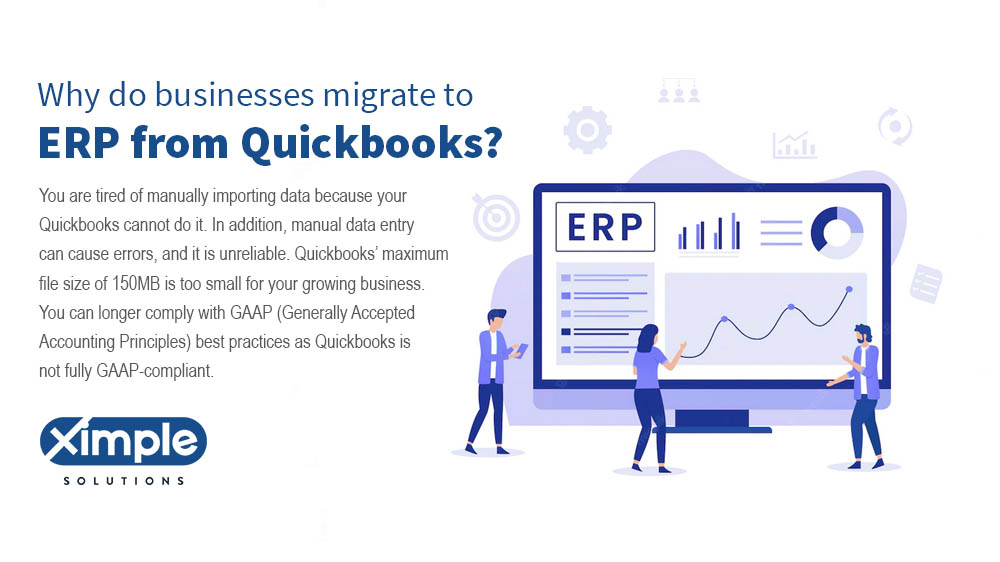

Table of Contents
- Different Quickbooks versions
- Benefits of using Quickbooks
- Disadvantage of Quickbooks
- Why should you be exploring Quickbooks Alternatives?
- Best QuickBooks Alternatives for Your Business Accounting
- What’s the difference between Quickbooks vs. ERP?
- Why do businesses migrate to ERP from Quickbooks?
- How do you migrate from Quickbooks to ERP?
- Why are Distributors migrating to Ximple ERP from QuickBooks?
- Conclusion
Different Quickbooks versions
The available versions of this accounting software include:
QuickBooks Online
It is a cloud-based solution for small businesses. It has different subscription levels like Essentials, Plus, Simple Start, and Advanced.
QuickBooks Desktop
This one is so broad, seeing that it has six different editions. Therefore, you can purchase Pro, Plus, Premier, Premier Plus, Enterprise, and QuickBooks for Mac.
- Quickbooks Pro – This version of desktop Quickbooks suits a small enterprise that does not make products at all.
- Premier – This is ideal for non-profit organizations, manufacturers, contractors, and retailers.
- Quickbooks Enterprise – This version suits large-scale enterprises.
- Plus and Premier Plus – These will match any business that is comfortable paying an annual membership fee rather than a substantial one-time fee at the time of purchase.
- QuickBooks for Mac – It is just like QuickBooks Pro and will work perfectly for any small enterprise that doesn’t manufacture anything.
QuickBooks Self-Employed
If you run a business, Quickbooks Self-employed is the best software. It is cloud-based and convenient.
Quickbooks core features
Without a doubt, QuickBooks is an excellent way to automate your accounting and bookkeeping functions. It provides the following core features:
- Expenditure tracking – This software will automatically find all your bills and expenditures. All you need to do is to connect all credit card accounts and bank accounts to the tool. Then, for cash and check transactions, enter data directly into QuickBooks.
- Payroll management – Quickbooks payroll can automatically track employee hours and give you accurate data to create paychecks and tax returns.
- Inventory tracking – Quickbooks software provides an inventory tracking feature to locate the items you have in stock and how much each costs.
- Business reporting – As you record and manage business cash inflow and outflow in Quickbooks, you can also generate as many reports from it as you want. Also, the software will update each statement in real-time and make it available to you anytime.
Quickbooks tools, training, tutorials, and pricing
- Quickbooks Tools – This hub contains everything you might require when a Quickbook error or failure occurs. The Quickbooks Tools Hub is highly reliable.
- Quickbooks Training – If you want to buy and use Quickbooks personally, you should train with an expert. There are Quickbooks classes for someone like you online.
- Quickbooks Tutorials – If you can learn by reading tutorials, you don’t have to wait. Search for them on the internet and save time and money.
- Quickbooks pricing – Price varies based on the type of Quickbooks you want. The cheapest and the best for small to medium-sized enterprises is QuickBooks Online. It costs between 25 to 150 dollars. There is a QuickBooks Desktop for SMEs, and it costs between $399.99 and $1,213 for the first year. QuickBooks Self-Employed is suitable for independent professionals who run personal businesses. It is only $15 a month. Lastly, QuickBooks for Mac is for SMEs that use Mac PCs. It costs a one-time fee of $399.99.
Benefits of using Quickbooks
A business of any size will benefit from the use of QuickBooks software. As long as your company knows how to use Quickbooks, it can help a lot. The tool can offer these advantages:
-
- Can create and track different invoices. Whether you wish to create and print or send electronically to customers, this tool will let you do it. In addition, it will tell you how much each customer owes and show all pending invoices. These are called accounts receivables, and as well as these, you will get a report showing how many days each invoice is overdue.
- It can show you all the bills you have not paid. Quickbooks checks accounts payable too. In other words, it can automatically connect to your bank and credit card accounts. In addition, it can allow the tool to download and categorize your bills. You can also enter some bills personally, and Quickbooks will help you track future payments.
- Generate printable financial statements: Each time you carry out a cash inflow or outflow activity in
QuickBooks pro
- You can use the payroll option to track employee hours Once the software tracks hours, these will flow to your customer invoices and payroll. In short, you can pay your employees the correct salaries by check or direct deposit and be able to calculate their federal and state taxes.
- You can find out when to replenish your stock Quickbooks can show the quantity of each unit of inventory and its cost. In addition, it will automatically allow a percentage of stock to the cost of goods sold as this is a requirement for computing taxable income.
- Can help you accept online-based payments If customers can pay what they owe you online, they will love to do business with you. Buy the QuickBooks Payments option, and it will help your customers pay directly.
- There are scanned receipts for future retrieval You require receipts when computing your taxes. With the help of the Quickbooks App, you can take snapshots of each receipt and upload them to the software for future use.
Disadvantage of Quickbooks
As well as having advantages, QuickBooks has disadvantages. These are:
- Depending on the version of Quickbooks you are using, reports can be few, and charts can be hard to customize.
- Some users think that learning how to use Quickbooks is complicated when compared to similar tools.
- If you are using the simpler QuickBooks Online version, you might find that addressing inventory management issues is limited.
- The synching difficulty is slightly common among users, and some say that it can take them a day or longer to sync finally.
Why should you be exploring Quickbooks Alternatives?
Although Quickbooks are relatively affordable, some people cannot buy them. Instead, they look for free alternatives that can satisfy their needs. These do it to avoid the cost of buying once or every year. Some other people choose a Quickbooks alternative software tool because of outgrowing Quickbooks. For these, their businesses have grown and expanded so much that Quickbook alone cannot help. Still, some companies quit because they did not like using Quickbooks or were recommended something else.
Best QuickBooks Alternatives for Your Business Accounting.
There are several Quickbook.com alternatives for you. Some of these are:
- Wave – A free accounting tool
- ZipBooks – A free accounting platform
- Xero – If you type this on Google, you will find some articles on Xero vs. Quickbooks. Xero is a paid option.
- FreshBooks – This cloud-based software for accounting is idiot-proof and easy to access from any place. It is a paid option.
- ERP software – If you are looking for a tool that will do accounting and every other business management work, choose Enterprise Resource Planning (ERP) software. If you are in the wholesale distribution business exploring a simple scalable Next Generation Cloud ERP solution, then the Ximple solution is the ideal choice.
What’s the difference between Quickbooks vs. ERP?
Before you learn how to use Quickbooks, it is essential to understand how it compares to ERP. Therefore, it would be best to decide which between Quickbooks and ERP can help your business succeed. However, there is one big difference between the two tools. While Quickbooks can only tackle the accounting work, ERP can do accounting and more. To be specific, ERP has different modules: accounting/finance, human capital management, sales order management, purchase management, warehouse management, project management, and customer relationship management, among others. In addition, with ERP, you can expect real-time updates from every department of your business.
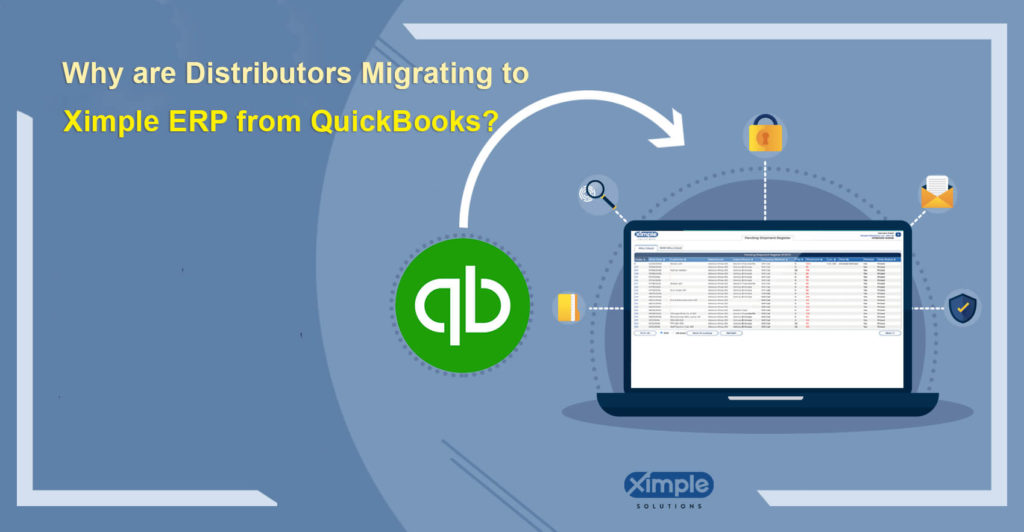

Why do businesses migrate to ERP from Quickbooks?
If you are already using Quickbooks, you can tell it is time to shift to ERP. Here are the signs:
- You are tired of manually importing data because your Quickbooks cannot do it. In addition, manual data entry can cause errors, and it is unreliable.
- Quickbooks’ maximum file size of 150MB is too small for your growing business.
- You can longer comply with GAAP (Generally Accepted Accounting Principles) best practices as Quickbooks is not fully GAAP-compliant.
- You are in the distribution and wholesale business, and your inventory management has become too complex for Quickbooks software to work.
- As Quickbooks does not offer real-time data monitoring, you are not able to make decisions quickly. This can limit your business’s performance and success.
How do you migrate from Quickbooks to ERP?
Although anyone can learn Quickbooks and use it, some businesses may not need them. These would instead use ERP software that suits their business goals and structures. Thus, if you are ready to shift from Quickbooks to ERP, here is how you can do it:
- Carry out a data cleanup exercise – As earlier implied, Quickbooks has a limited file size. Once you store 14,000 files, there is no space for more. Like other people, your accountants will start creating Excel Spreadsheets. While these are fine, research shows that 88 percent of long spreadsheets with over 150 rows contain errors. Don’t transfer a single Quickbooks error to your new ERP software. Instead, remove outdated data, duplicate records, inconsistent data fields, and other errors.
- Discover inefficiencies, restructure your workflows, and determine your ERP needs – Quickbooks and ERP are two different tools. Even if ERP has an accounting function, it is a broader module with a unique structure. Thus, you cannot import your Quickbooks data the way it is because of ERP’s extra capabilities. If you need help, then seek an ERP consultant.
- A change management strategy – The ERP implementation process is complex, and workers might fear it. It is even more complicated when you migrate from Quickbooks, CRM, or other business management software. Ensure that workers understand what the process is all about and their roles to help you avoid resistance to change.
Why are Distributors migrating to Ximple ERP from QuickBooks?
First of all, Ximple Solutions is a reputable company that began in the year 2000. With 21 years of consistent practice, this company has enough experience. This is why distributors are choosing it as an alternative tool for Quickbooks small business accounting tool. Secondly, Ximple Cloud ERP is integrated software that can take care of every business need. Besides, distributors are looking for a tool that will do more and cost less. While there are several ERP solutions online, Ximple is versatile, scalable, modern, and fairly priced. It is easy to use and ideal for any growing business that wants a single integrated software suite. Distributors will easily monitor the real-time flow of data concerning their suppliers, customers, and workers. Above all, they will be able to select either an on-the-cloud or an on-premise Ximple ERP version.
Conclusion
There is no doubt that Quickbooks is a famous software tool for accountants. It is available in different versions, allowing you to select the type that could help your accountants. Concerning usage, you can read Quickbook tutorials online or hire someone who is already trained and certified. Finally, if your distribution wholesale business outgrows Quickbooks, you can migrate from it to ERP. This article has quick tips on successfully migrating from Quickbooks and finally recommends Ximple ERP to you.
Posted on
What is a Distribution Strategy? Importance of Distribution Strategy
Did you know that sales are the key to higher revenues and contented workers? That’s true, and if you want to sell more, you should make a plan. First, you should have a goal to attract and retain customers. Second, you should deliver a product or service to the customer and the correct information. To achieve this, you should come up with a distribution strategy that goes well with your business needs. This strategy will help you manage the complete sales process. But, do you know what it is all about? If not, don’t worry; this guide will educate you.
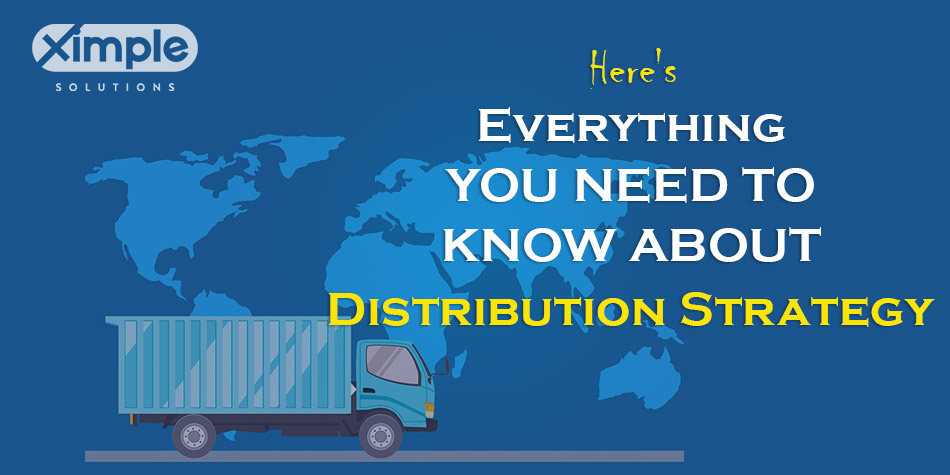

Table of Contents
- What is a Distribution Strategy?
- How to select the right Distribution Strategy
- Distribution Strategy: Stay competitive in the Digital world
- Distribution Strategy examples
- What are different types of Distribution Strategy?
- What are different distribution Channels?
- How can I select the right distribution strategy for my wholesale business?
- Key Modules of the Distribution Software
- What is the difference between Direct and Indirect Distribution
- Conclusion
What is a Distribution Strategy?
In a nutshell, the best distribution strategy definition is a plan to help you deliver a product or a service to the customers you are targeting via a supply chain. This plan includes all the approaches you would use to give the customers what they expect from you. A good strategy can incorporate your distribution channels or employ other companies’ channels. In addition, your business can use its exclusive stores or sell through other retail stores.
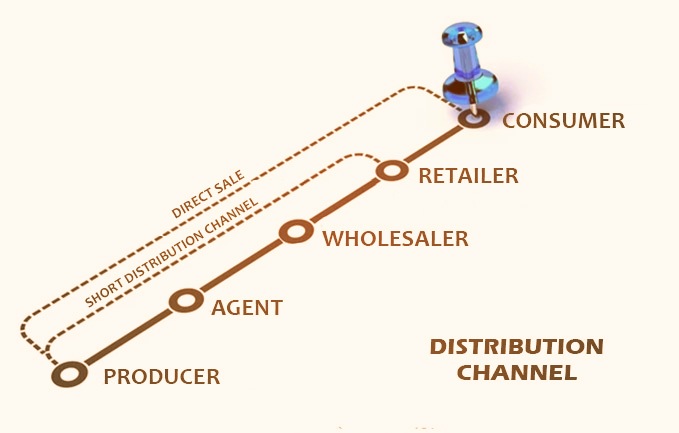

Moreover, a business can use both its stores and third-party retail chains. In modern times, especially after the Covid-19 epidemic, companies are using online exclusive sales channels. Hence, you should pick a distribution channel strategy that suits your business. The best approach will help you deliver goods or services to the target audience at optimal distribution costs. It will also maximize your sales revenues and profits. On the other hand, Bad distribution strategy types will cause losses and let your competitors win.
How to select the right Distribution Strategy
Now you know what a distribution strategy is. Next, you will learn how to select the right one for your business. There are a few factors to reflect on, and they include:
Check the market status right now
Before coming up with a distribution marketing strategy, carry out a thorough market analysis. The goal is to discover the correct way to distribute the type of products you sell. For instance, if you deal with consumer goods, the proper technique is FMCG distribution. Only a meticulous market analysis can reveal the appropriate distribution channels for your products. It can also help you study customers’ buying behavior and pinpoint their specific needs.
Distribution costs
No matter the channel you choose, there will be costs to incur. If you select a more comprehensive direct distribution strategy, it means you will sell directly to the final customer. The method is more straightforward, but it has some costs to incur. The more comprehensive strategy involving intermediaries is more convenient, and goods can reach customers almost immediately. However, every intermediary should earn something to continue being loyal to you. In essence, you should develop charts and graphs showing potential costs and profits from each distribution channel.
Do you sell complex or simple products?
As you try to create a sales distribution strategy, focus on your product. The product is complex in that it requires technical support after delivery. Do the customers need an after-sale service, such as installation and maintenance help? If so, you should sell it more directly to go to a dealer and then to a customer. The dealer will help your customers sort out their issues. On the other hand, if your product is a typical household appliance, such as a blender, you can select an extended distribution channel for it.
What profits are you targeting?
If you choose the shortest distribution method, your business revenues can increase. Nonetheless, this can happen only if you don’t sell FMCG products. For these, you need a more extended distribution channel to increase your revenues and profits. In some situations, higher revenues may not translate to higher net profits.
What will be your market share?
How quickly can your business establish itself in a new market? If such a market is already saturated, you will find it hard to penetrate a new market. There will be competitors doing well already, and it will take longer to get a market share. So you have to do you distribute strategy math very carefully.
Where your product is in its life cycle
If your product is new, a more extended distribution channel is necessary to ensure it is recognized on the market. As you choose who to connect and grow with, you should consider their availability and expertise.
Distribution Strategy: Stay competitive in the Digital World
As you think of how to make a distribution strategy, focus on technology. First, think of how to use technology to promote and sell your products. In this case, you should explore eCommerce as a distribution channel. It is estimated that by 2021, e-commerce sales will reach 4.8 trillion. Why wouldn’t you want to be part of that? Countless people are using apps to buy things online, and you can sell to them too. Secondly, you can use technology to implement your preferred distribution strategy. As you will learn below, there is software that can help you manage your supply chain processes
Distribution Strategy examples.
A suitable distribution strategy example will vary depending on the marketing channels you have selected. First, a direct channel occurs when a manufacturer sells straight to the consumer. The channel must be short if it’s direct. Hence, good examples of this are primarily retail brands that sell fast foods and perishable goods.
An indirect marketing channel, it occurs when the path is long and complex. Typically, there will be many distributors and middlemen. Examples can be soft drinks companies, including Coca-Cola and Pepsi
An intensive distribution strategy is more intensive and considers more than just the size of a distribution channel. It uses a more aggressive approach, and examples include vehicle brands and distributors of household appliances.
Moreover, a business can use an exclusive strategy when it has a high brand value to protect. It will open stores in major cities with upper-income and classy customers and still outdo its competitors. Examples are big fashion houses with high-end designer products.
Lastly, some businesses use a selective distribution strategy. You will find them on almost every street, or they may start a few stores in every major town. Good examples are big supermarkets and retail chains.
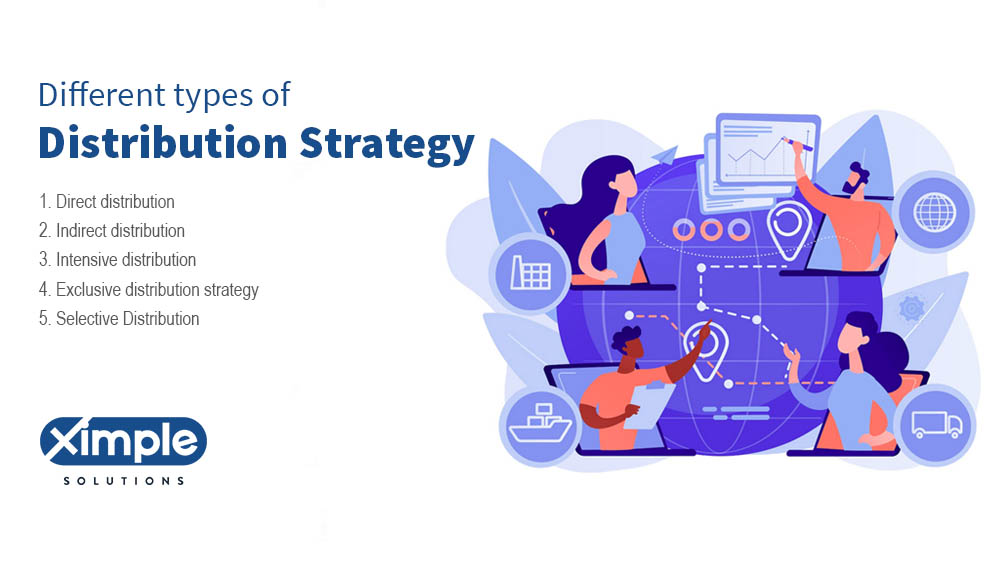

What are the different types of Distribution strategy?
Direct distribution


Here, manufacturers sell directly to the end consumer. Some direct distributors sell online, particularly those targeting younger generations that have more technological knowledge. The rest use product catalogs, product lists, phone calls, and other advertising methods.
Indirect distribution
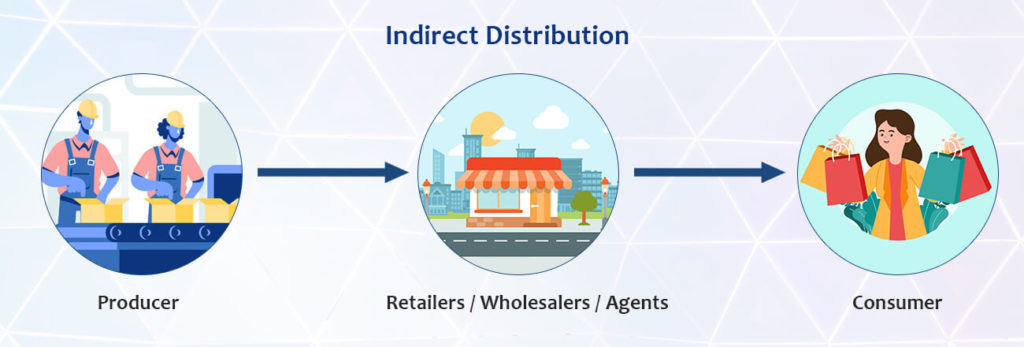

It is the opposite of the direct distribution method. Simply, this method entails intermediaries like wholesalers, retailers, and agents.
Intensive distribution
As aforementioned, this technique entails a more aggressive and extensive marketing approach. Hence, several retail outlets are opened to reach more customers and increase sales revenues and profits.
Exclusive distribution strategy
This method is a preference of companies that sell luxury goods. To purchase their products, you must approach their dealership. A good example here can be the Mercedes Benz car brand.
Selective Distribution
This technique is partly similar to intensive and exclusive strategies. Those who use this technique know full well that not all people will be interested in their products. So they set up stores in some selected areas. Their stores don’t sell anything else, and if they pick external stores, these will sell closely related products.
Related articles
What are different distribution Channels?
These channels are all about how to distribute products to customers. As a distributor, you obtain goods, store them, and then sell them to customers via a distribution channel. Different channels include the following levels:
- Zero – This distribution channel involves direct contact between manufacturers and customers. It is the shortest.
- One – This one entails one middleman standing between the manufacturer and the consumer.
- Two – It involves two intermediaries, and this can be a wholesaler and a retailer.
- Three – This distribution channel has three middlemen, namely: agent, wholesaler, and retailer.
How can I select the right distribution strategy for my wholesale business?
If you are a wholesaler, you need a product distribution strategy that works for your business. There are different types of systems, but some may not work for your business. The system that might work for you might not help the next wholesaler. You can opt for direct marketing via telemarketing and product catalogs or choose eCommerce marketing. It can be trial and error at first, but eventually, you will discover the best strategy for your business. Briefly, you should:
Know your customers perfectly
Ensure you find out who your target customers are, what they need from you, how soon they want it delivered, and where
Focus on your product
If you sell perishable goods or daily-use products, by all means, choose a direct channel. On the other hand, if you deal with non-perishable goods, choose indirect marketing channels. More to the point, select your intermediaries wisely.
Seek professional help
As a wholesaler in any industry, you have competitors. Any small error in decision-making can cost your business considerable losses in terms of time and money. Thus, if you honestly can’t select the right distribution strategy alone, find a professional who can help you.
After finding a distribution strategy to get the message to customers, the next thing is to implement it. As technology has become more innovative than ever, you should use it in your business. More specifically, you should start searching for the best distribution software. It would be best if you bought wholesaler distribution software as it is designed for your business. Not only will it make the distribution process easier to track, but it can also reduce human errors and stress.
A good software tool for distributors should have automation capabilities. In other words, it should boost productivity and ensure that you complete tasks quickly. Another component of this software is RFID tracking which simplifies inventory monitoring in real-time. It is based on a modern technology called the Internet of Things. Moreover, the software needs to have all business management modules in a central position. The most common modules are accounting, warehousing management, customer relationships management, inventory management, and procurement management. Lastly, the software should be cloud-based rather than in-house. Cloud-based distribution software is easy to access from any place, anytime, as long as there is a Wi-Fi hotspot and mobile gadget.
Key Modules of the Distribution Software
Distribution software includes modules to manage plan, administer, execute, track, and report the tasks running in Distribution warehouses that belong to wholesale distributors business. Distribution software contains the ‘Flow’ of material for distributors. Key Features of the Distribution Software are:
- Sales Order Management
- CRM
- Inventory Management
- E-Commerce
- Product Catalog
- Employee Management
- Billing
What is the difference between Direct and Indirect Distribution?
In direct distribution, the product is distributed to the end-user from the manufacturer’s or distributor’s warehouse. This is usually the case for a manufacturer that sells its items via a distribution center or retail outlet. In indirect distribution, the product (i.e. a service) is provided through a supplier or agent who’s contractually obligated through the manufacturer to buy the products and supply them to the end-user. The indirect distribution technique is regularly used by manufacturers and distributors to make certain they don’t oversell or have leftover products.
Direct Distribution = Direct-to-consumer (DTC) is a distribution channel that is not utilized by the brand. The main reason for the use of this channel is to gain a competitive benefit as it is a quicker and more direct way to reach the customer. Companies use direct distribution channels for customer products as it is very effective. This is a direct method of reaching the consumer with the product.
Indirect distribution is an indirect form of distribution channel and is used to sell products and services. It is also called indirect marketing. It is a form of marketing that involves a company or individual taking someone else to make a sale for them. This is known as indirect distribution as it does not involve the company or individual going to the customer directly.
FAQ about Distribution Strategy?
1. What are the 4 types of distribution strategy?
First, a distribution strategy is a plan for distributing goods or services to customers. Successful distribution of your product or service will depend on your selling strategy. There are four distribution strategies, and they include the following:
- Direct – A manufacturer uses a direct distribution method when they want to avoid intermediaries. They can create an eCommerce website and sell their item to direct online customers. Alternatively, they can use catalogs or sell directly via phone calls. The best-selling method for a company depends on the customers’ technical knowledge and age.
- Indirect – This technique includes an intermediary that delivers goods to the customer. Thus, an indirect marketing channel is longer than a direct one. A company will consider the type of items it produces and the customers it wants to reach. An indirect distribution technique can include wholesalers who take goods directly from the manufacturer. After that, they sell these goods to retailers who distribute them in small quantities.
- Intensive – A manufacturer chooses many retail shops to which they deliver their product. An Intensive distribution method suits items like candy or biscuits. These snacks sell fast regardless of the location or shop type. As customers buy these snacks on impulse, the intensive distribution technique tends to work best.
- Selective – It includes Intensive and Exclusive distribution techniques. An Exclusive distribution strategy involves just one point of sale, such as a retail store. The manufacturer creates branded stores and puts them in different locations. So the only way to get their product is to visit the branded store. This technique works for luxury products like high-end vehicles. A Selective distribution method has the traits of Intensive and Exclusive strategies since the manufacturer places products in its branded stores and a few departmental stores.
2. What are the critical parts of a Distribution Strategy?
A distribution strategy has six parts or elements. These include:
- Order processing
- Customer service
- Transportation method
- Inventory control
- Materials handling
- Warehousing.
3. How do you determine a distribution Strategy?
Selecting the correct distribution method determines your overall selling success. So, it is necessary to understand the tastes and preferences of your target consumer. For instance, younger generations have more technical knowledge while older generations may prefer simplicity.
Customer perception of your brand matters a lot when selecting a distribution channel. If they view it as a luxury brand, you might choose an Exclusive or Selective distribution strategy.
A pricing strategy that works for the chosen distribution channel is a must to ensure everyone involved benefits from the deal. Lastly, the relationship you share with your customers is a vital consideration.
Best way to send your goods to the customers
Companies produce different items, meaning their distribution strategies cannot be similar. When selecting the best way to send your goods to the customers, reflect on the following:
- Who is your competition, and how do they distribute their goods? If there is a distribution technique that none of them or only a few of them use, you can grab it. For instance, some of your competitors may not yet have an eCommerce website. Those who have a website may not be actively promoting it to get leads. You can fill this gap and make more significant profits.
- Cost of using a given distribution channel – Choosing the best distribution strategy is not enough. You must incur some charges for building a reliable support system. Can you handle these expenses with your current financial resources?
- Create your favorite list of options – So far, you have examined different distribution methods based on their pros and cons. Next, make a list of options starting with the most beneficial approach. Finally, select the strategy that could get you many customers.
- Create an expansion plan – As your business grows, you might have to select more distribution channels. To do that well, study the market to know what your target audience wants and how you can send it to them. Also, consider the new techniques your competitors adopt.
4. Why is a distribution strategy important?
Selecting the best distribution strategy is necessary because of various reasons. Some of them include:
- You can ship your products to the target markets without causing unnecessary delays.
- Knowing the best distribution method can help you improve customer experience. It can provide information on consumer preferences and tastes and help you fulfill their needs.
- An accessible, intuitive, affordable distribution channel can help build and retain customer loyalty. You can deliver the items your customers want on time.
- The best distribution channel can let you find ways to deliver goods cheaply. For instance, you can outsource the transportation and logistics role to an able distributor.
- Choosing a perfect distribution strategy can let your company reach its long-term goals to ensure faster growth and higher revenues.
5. How does technology enable distribution strategy execution?
Technology growth affects distribution execution in some ways. It makes the distribution role better in the following ways:
- There are new software systems that improve information flow via the automation of different areas of the supply chain. For instance, a distribution enterprise resource planning (ERP) tool puts all the necessary logistics disciplines into a single centralized database.
- Automation of distribution networks keeps every supply chain participant informed. For instance, distributors can track their inventories in real-time and instantly tell their suppliers or manufacturers so they can adjust their production cycles and quantities based on current demand.
- Technology has led to the release of new warehouse management machines. These reduce human labor and its errors. Warehouses do not have to be large buildings now. With pallets, conveyor belts, elevators, and rail systems that receive control commands from a central computer network, warehousing is an easier task.
- Software technology allows traffic managers to choose the most cost-effective loading and delivery systems. GPS systems show drivers the least expensive and the most secure routes. Technology will keep shifting to help shorten delivery times, improve the safety of goods in transit, and lower the cost of inventory management.
Conclusion
If you want to create an effective distribution strategy, you should know that this is a multi-faceted and complex process. You have up to five distribution channels to choose from and a range of factors to think about. Whether you settle on a direct, indirect, intensive, exclusive, or selective marketing strategy, you need software to simplify the implementation process. In addition, if you cannot develop a strategy alone, you can consult a professional.
Related articles
- What is ERP? | How It Can Help Your Business Grow
- How to Choose an ERP Consultant?
- 6 Key Benefits of ERP Accounting System
- Best Purchase Management ERP | Top Order ERP Systems
- 8 Features that Describe the Importance of ERP for Business
- What is Cloud ERP and How Does It Work? | Advantages of Cloud ERP
Posted on
ERP vs CRM: What is the difference?
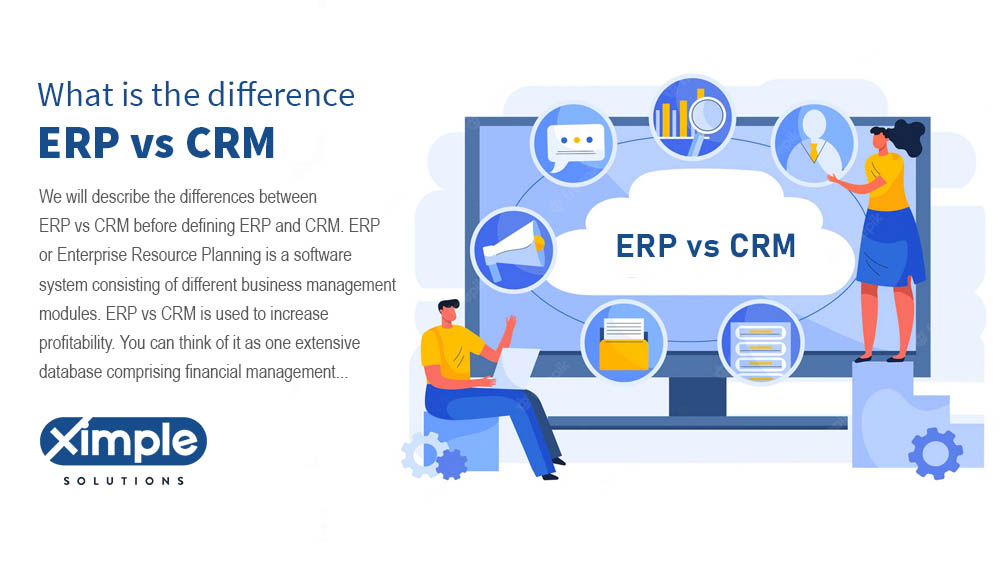

What is ERP?
We will describe the differences between ERP vs CRM before defining ERP and CRM. ERP or Enterprise Resource Planning is a software system consisting of different business management modules. ERP vs CRM is used to increase profitability. You can think of it as one extensive database comprising financial management, accounting, purchase management, human capital management, Customer relationship management, project management, warehouse management, business intelligence, and sales management, among other modules. A business selects the modules to add to the ERP software to boost productivity, profitability, and efficiency.
Table of Contents
- What is CRM?
- Key difference between ERP vs CRM
- ERP vs CRM – Key Features
- ERP vs CRM: Key Benefits
- CRM vs Cloud ERP
- How are ERP and CRM systems similar?
- Can CRM be integrated with ERP?
- Is CRM part of ERP?
- Integration of CRM, SCM, and ERP
- Does our Distribution business need ERP or CRM, or Both?
- Cloud CRM vs Cloud ERP
- Conclusion


What is CRM?
CRM refers to Customer Relationship Management. It is a type of software program that businesses use to scrutinize and manage customer interactions and data all over a customer lifecycle. They use this tool to enhance customer service relationships. A CRM software program can collect customers’ data across various contact points between a business and a customer. Concerning ERP vs CRM, all business departments require ERP, while the sales and marketing team mainly needs?CRM. Each communication between a business and a customer enters into the CRM database for future retrieval. Besides capturing details of every customer, A CRM program can help a business design or identify the most desirable products and services.





See How We Can Help to Reduce Your Operational Costs for Your Wholesale Distribution Business.
Ximple ERP automation improves workflows & processes across the distribution departments which help to reduce operational cost and productivity.
If you want our wholsale distribution business experts at Ximple Solution to help you digitalize your distribution business or upgrade your legacy ERP, just book a call
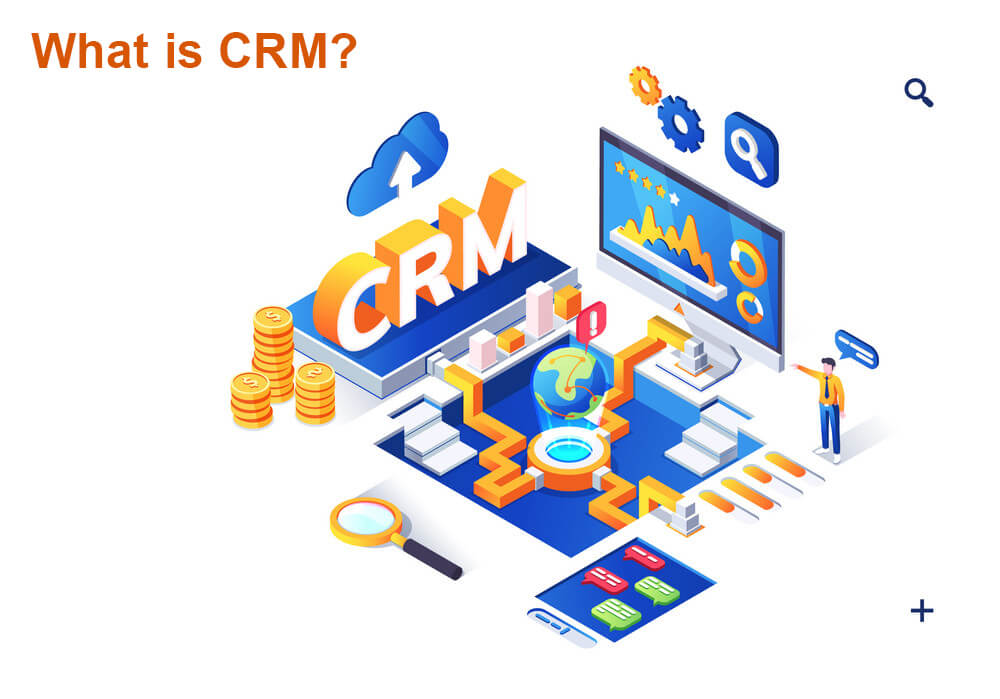

The key difference between ERP vs CRM
After defining ERP vs CRM, next, we will describe the differences between ERP software vs CRM. These two are essential business management software tools but are they different? ERP vs CRM is used to increase profitability. ERP vs CRM integration so crucial The following are the main differences between them:
- While ERP controls different business functions, CRM provides a single database for the sales function or department.
- It is easier to install CRM as it is a single system targeting the sales process and team. On the other hand, it isn’t easy to implement ERP because it can have several modules as a business requires.
- CRM being sales-specific software, shifting customer data to it is more straightforward. On the other hand, transferring the entire organization’s data from previously owned automated solutions to the ERP system is laborious.
- An ERP purchase and implementation process demands a more substantial financial commitment than a CRM purchase and execution.
- When it comes to who needs ERP and CRM, it is clear that a few medium-sized enterprises and many large-scale businesses can afford the expensive ERP. On the other hand, almost all small businesses would struggle to implement the costly ERP. They can easily afford CRM implementation.
Key Features: ERP vs CRM
An ERP system can have as many functions and modules as a client wants. However, some of these are critical and commonly included during ERP implementation. Features of an ERP vs CRM are more holistic in terms of the business as a whole. As you will see in the functions indexed below.
Common ERP Features
- Finance and Accounting
- Procurement or purchasing
- Manufacturing
- Inventory management
- Order management
- Warehouse management
- Supply chain management
- Customer relationship management
- Project management
- Human capital management
- Service Resource Management
- E-commerce
- Sales and Marketing Management
As you can see, you should not confuse ERP vs CRM software because CRM can be a part of ERP.
Common CRM Features
A single Customer Relationship Management program can have as many as 30 features. All businesses don’t need all of these features. The most important and common ones are:
- Contact management – Enables a business to create a big customer contacts list and use it for marketing later on.
- Lead management – It’s not every customer that is worth following up. With this module, you can sort high-quality leads and strive to retain them.
- Lead scoring module – This is a crucial feature that can help a sales team identify leads likely to convert to loyal customers.
- Sales analytics – This module is vital as it can help the sales team gather data from all platforms, analyze it, and create analytical reports to be used when creating future sales campaigns.
- Mobile CRM – This feature ensures that CRM is available to mobile device salespeople.
- Sales forecasting – This is a feature that will help the sales department create a yardstick to measure sales efforts against the actual results.
- Salesforce Automation – This is a tool for automating routine tasks that employees do to help them focus on other more beneficial tasks.
- Emails Client Integration – This is all about having an email client within the CRM software for more accessible communication.
- Business intelligence, reporting, and dashboards – allow users to capture real-time data updates no matter the platform they are using. As a result, they can make better decisions.
- Data or file storage – This feature is created in CRM software systems to help users store and retrieve data quickly.
- File Sync and Share feature – You can merge CRM with Google Drive, DropBox, Outlook, MS Excel spreadsheets, or any other program you like.
- Sales Performance Management – This module is added to help management overview the sales team’s performance.
ERP vs CRM: Key Benefits
These ERP and CRM systems have several benefits in the way they help manage company processes.
Let’s take a look at ERP vs CRM benefits:
Benefits of ERP
By implementing ERP, a company can note some advantages. These are:
- An ERP system provides a module for each department, helping the whole organization work as a team.
- Although the initial cost of executing ERP is high, the system fully recovers it in the future by reducing overheads and streamlining processes.
- ERP automates business functions and gets rid of paper-based operations.
- ERP improves decision-making processes among seniors and subordinates by generating real-time data.
- ERP improves stock management by assigning a barcode to each element of a finished product. The same barcode gives potential customers more information about the product itself.
Benefits of CRM Cloud
A cloud CRM is a customer relationship software program that exists in the cloud. Therefore you can access it anytime as long as you have an internet connection and a browser. ERP or CRM can be on the cloud; it is your choice. Advantages of using a CRM cloud system include:
- It is super easy to install CRM software even if you are a small business.
- Cloud CRM is a seamless system that a salesperson can access from any place any time they like.
- Although your sales team needs training, the whole onboarding process is more straightforward than that of ERP.
- CRM cloud can help a business save time, one of the most irreplaceable resources.
- ERP CRM solutions encourage teamwork and collaboration as everyone must refer to a central database.
- Cloud CRM software is scalable and versatile, meaning that it will still fit your business if it expands.
- CRM that is in the cloud can be combined with other essential business applications to simplify the sales team’s work.
- It includes constant updates and provides reliable data backup.
CRM vs Cloud ERP
When deciding between CRM vs ERP applications, it can be easy to determine the one you want based on if it is in the cloud or not. First, if you can afford to install cloud ERP, then do it and ensure that you include a CRM module. A standalone CRM is fine, but it cannot compare to an ERP already in the cloud in terms of benefits.
Your sales team can access this type of CRM at the office only. This is not the case for a team that is using Cloud ERP with a CRM module. They will always access it no matter where they are as long you have an active Wi-Fi hotspot.
How are ERP and CRM systems similar?
In this section, we want to describe the similarities between the ERP & CRM systems. Are they even related to each other? The answer is yes. The main similarity between the systems is that CRM is a common component of ERP. While a separate CRM module in a whole ERP system can’t be as robust as a standalone CRM software tool, it still works. It will generally lack some standard features found in a standalone CRM system. If present, the features might be brief.
Can CRM be integrated with ERP?
Yes, ERP and CRM integration is possible. This can allow you to have a single software system that can manage every other business process plus sales. What we mean by integration is that standalone CRM software is connected to an ERP to ensure that they work together as one system.
Is CRM part of ERP?
Customer Relationship Management is a unique business function that deals with sales activities. As software, CRM can stand alone or be merged with ERP. When integrated with ERP, CRM is one of the five most important features of an Enterprise Resource planning system.
Integration of CRM, SCM, and ERP
So far, you understand the meaning of ERP and CRM. When these are combined with SCM, do they even work? SCM refers to Supply Chain Management. This is a critical business function, especially for distributors and wholesalers. It is possible to have ERP systems that have a Customer Relationship Management module and a Supply Chain Management module. Each component will enhance your employee’s work. You can hire an ERP CRM SCM software company to help you carry out the complicated integration task.
Does our Distribution business need ERP or CRM, or Both?
As a distributor, you want activities per distribution channel to be quick and error-free. You can do so by obtaining CRM software. This can be a separate tool, or it can be a part of your ERP. If you already have distributor ERP software, the easiest way to have CRM is to add it as a module. If you don’t have ERP and cannot afford it right now, you may be best buying the CRM software alone.
The choice to invest in a CRM, ERP, or both will depend on the requirement of your company. A business with a small number of high-value customers and complex financials should invest in ERP Software.
You don’t need both software systems if you have a customizable ERP and your sales function is manageable. However, if you run a large business with global networks, your sales activities might require a Standalone CRM software program for robust management. If you cannot afford either, there are ERP CRM open source tools for you.
Cloud CRM vs Cloud ERP
When making ERP CRM cloud decisions, you have to be careful. Will you deploy ERP or CRM software? If you want both, then you can either have software run separately or add CRM to ERP. When it comes to cloud CRM vs. Cloud ERP, you should know the best option based on your needs and financial ability. As a small business, you should probably postpone ERP installation and implement the cheaper cloud CRM. As a medium-size or large-scale business, you should either integrate ERP and CRM or run each software tool separately. Considering all things, running an ERP on the cloud will be more beneficial because it includes several business functions.
Conclusion
So far, you know the difference between CRM and ERP systems and the similarities as well. You also understand that you can either use an ERP system with a CRM module or use CRM independently. If you are a distributor, you can have ERP with supply chain management and customer relationship management modules. What you require to succeed is an ERP CRM consultant to help you select and install the best software for your organization.
Related articles
- What is ERP? | How It Can Help Your Business Grow
- How to Choose an ERP Consultant?
- ERP for Distributors – Warehouse Management Software
- 6 Key Benefits of ERP Accounting System
- Best Purchase Management ERP | Top Order ERP Systems
- 8 Features that Describe the Importance of ERP for Business
- What is Cloud ERP and How Does It Work? | Advantages of Cloud ERP
Posted on
What is an ERP Platform?
A corporate ERP Platform Software is broader than any standalone business management software. It is a merger of different software tools used for running a business. Thus, an ERP Platform Software has other software modules, including accounting, warehousing, distribution, purchasing, inventory management, finance, payroll, sales and marketing, and supply chain. Depending on your business size and type, you can have as many modules as you like.
The best ERP Platform software is customizable. So, you can add extra modules and features to it to ensure it meets all your business needs. The first ERP was developed in the 1960s, and in 1972, SAP made its first automated system. From the 1990s to 2021, the Software has mainly evolved, and many businesses have adopted it. Now ERP is on the cloud. ERP Platforms such as the Ximple Cloud ERP platform for wholesale distributors provide a unique competitive advantage by offering core distribution wholesale industry functionalities while offering open APIs and microservices to integrate with other systems with ease.


A corporate ERP system is broader than any standalone business management software. It is a merger of different software tools used for running a business. Thus, an ERP Platform has other software modules, including accounting, finance, payroll, sales and marketing, warehousing, CRM, and supply chain. Depending on your business size and type, you can have as many modules as you like.
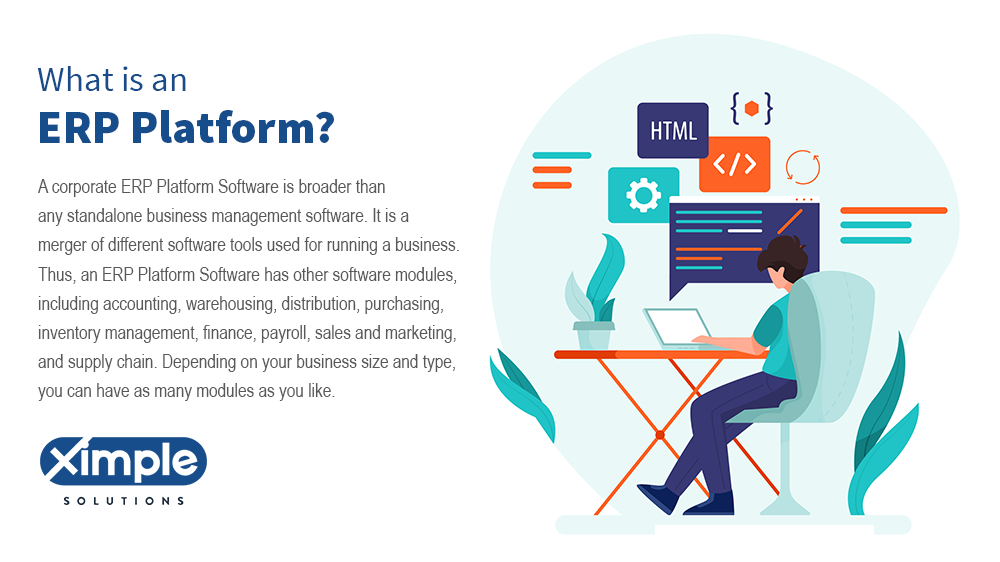

The best enterprise resource management software is customizable. So you can add extra modules and features to it to ensure it meets all your business needs. The first ERP was developed in the 1960s, and in 1972, SAP made its first automated system. From the 1990s to 2021, the Software has mainly evolved, and many businesses have adopted it. Now ERP is on the cloud.
Table of Contents
- What is Cloud Computing Platforms for ERP applications?
- Open Source ERP Platforms
- ERP Software Platform Features
- ERP Platform Benefits
- ERP Platforms Challenges
- Small to Large Size Wholesale Distributors: Selection of ERP Platforms
- Global Wholesale Distributors: Selecting ERP Platforms
- Implementing ERP
What are Cloud Computing Platforms for ERP applications?
An ERP on a cloud platform refers to a system that is accessible on the internet anytime and anywhere. It is typically hosted online by the software provider, and they can offer it as a service you can purchase every month; it is primarily SaaS-based. A business requires a connection to the host’s web server.
A cloud-based platform provides real-time insights to all involved in the running of a business. All cloud ERPs offer core business functions plus others. It is hard to find an ERP software platform that does not have these modules:
- Finance and accounting.
- Human Capital Management
- Customer Relationship Management.
- Inventory Management.
- Warehouse Management System (WMS).
- Supply Chain Management.
- Order Management.
- Procurement.
- Project Management.
- Customer Relationship Management (CRM).
Many benefits follow when the wholesale distribution business implements cloud enterprise resource planning solutions. The immediate ones are that a software provider will manage the application totally from their end. They will make sure your application is hosted 24/7 and produce real-time security updates and feature upgrades. On-premise ERP software requires a business to use its skilled employee to maintain and upgrades the system.
Open Source ERP Platforms
These platforms are offered for free. They are the best when you want to use ERP business software but don’t have the capital to implement it. Software like SAP, Oracle, and Microsoft Dynamics are not for everyone. They are fantastic but too pricey for some upcoming businesses to afford. Ximple Cloud-based ERP is an excellent alternative to those companies if you are in the wholesale distribution business exploring Next Generation ERP software. Many companies need to use open-source ERPs if they do not have a software budget. Though they cannot offer all the features found in premium products, open-source options are better than none at all.
As most of these are downloadable web applications, anyone can use them. But, there should be a server to which you will install your open-source ERP platform. Support will come from either the active user community or an outsourced entity.
A list of Technologies for ERP Platforms
The following is a list of technologies that developers use in their ERP-based Software.
Options for databases include:
- Oracle SQL
- MSSQL
- PostgreSQL
- IBM DB2
Programming Options:
- Python
- PHP
- Java
- Ruby
- NET and ASP.NET.
Options for Frontend:
- Vue.JS
- JavaScript
- React
- AngularJS.
- PHP Frontend
ERP Software Platform Features
An ERP computer system should have certain features to perform well. A primary platform should at least offer the most critical business management modules. These are:
Accounting and finance
This module should support primary accounting roles like bookkeeping, cost accounting, and financial accounting. Thus, it needs to have Accounts Payable, Accounts Receivable, and a General Ledger. This module will be crucial to your accountant and financial analyst.
Human Capital Management module
This is all about the management of all expenditures that your workers generate. It should simplify your payroll issues.
This will depend on the kind of business you do. If you are a distributor, it is apparent that you run a warehouse. This module will simplify all warehousing activities.
Customer Relationship Management module
Without customers, any business is nothing. Thus, the best discreet ERP platform should have a module that can help customers track their shipments.
This module helps with stock management. When an item is out of stock, the Software can reorder it automatically.
Other modules you can add based on the business you run and its size include:
Sales and orders management
Compliance Management
Supply Chain Management
Marketing Management
Project Management
This module should support primary accounting roles like bookkeeping, cost accounting, and financial accounting. Thus, it needs to have Accounts Payable Accounts Receivable, and a General Ledger. This module will be crucial to your accountant and financial analyst.
ERP Platform Benefits
We have told you what ERP and ERP solutions are all about. Now you need to know the benefits of implementing these solutions. These include:
- High-quality customer care service and relationships because customers can now track their shipments live and leave feedback.
- A simplified business management role because all business processes are centralized and can be tracked and managed at once.
- Cloud-based ERPs lead to optimal business performance because users don’t have to be stuck in an office to access them. They only need their mobile internet device to see the status of the business processes they are responsible for.
- Human errors are significantly reduced, which boosts the productivity of the business and saves time. Time is a resource you can use where it is needed the most.
- Information is right in front of everyone using the Software. This can enhance communication and collaboration between employees and their managers.
- Enterprise resource planning ERP software leads to lower operating costs as it renders some human tasks redundant and not worth paying for.
ERP Platforms Challenges
Although the electronic resource planning tool sounds great, it’s not easy to implement. The main challenge that affects small and medium enterprises is the initial cost being too high. Other than that, businesses looking to implement this platform may experience these challenges:
- There are several phases during the implementation process, and each has a critical role. One sloppy action in a phase can destroy everything. Thus, forming an expert project management team is a challenge.
- The original implementation budget may fail to include essential software capabilities or features. If these are discovered late in the process, it can be expensive to add them.
- Gathering all data sources from various departmental records that need to be shifted to the new ERP computer system is complicated.
- Duplicated data errors can be a challenge when moving your older software systems’ information to the new Enterprise Resource Planning tool.
- Managing resistance to change among employees is a challenge as some of them may be reluctant to learn.
- If a business has an on-premise ERP platform, it can find it hard to do continuous software upgrades.
Small to Large Size Wholesale Distributors: Selection of ERP Platforms
Small, medium, and large-scale wholesalers still run various departments. Even those small enough to have an office for every business function must take care of finance, accounting, sales and marketing, procurement and purchasing, warehousing, inventory management, and so on. So they need ERP for enterprises to simplify each business function and increase their profitability.
As a small business, you should select an affordable, scalable, and user-friendly ERP. Whether it is bought or open-source Software, make sure it meets the needs of your small business. Medium and large-size businesses may have adequate capital to roll out the ERP software. They should focus on selecting the best software provider to avoid wasting time and money. This should be a stable software producer that can also provide periodic security updates and new software packages to upgrade.
Global Wholesale Distributors: Selecting ERP Platforms
Some wholesale distribution businesses begin small in one country. Due to upward growth, they moved to the neighboring nations and at last shifted operations to many countries worldwide. If you are running such a wholesale business, then one critical tool you need is a distribution ERP platform. You should assess it properly by first determining the features required by your company.
As yours is a multinational wholesale business, you need several business management modules in an all-ERP platform. To determine all the required features, you might have to consult a software provider directly. Some can offer a free analysis to assist you in creating a sensible budget plan.
Implementing ERP
Once you have decided on the ERP product you want to buy, the next step will be selecting ERP platform components and implementing them. The deployment process is usually long and complex, explaining why businesses need to choose one implementation approach that could work for them. Some decide to roll out the platform all at once, while others decide to do it in phases.
Other decisions that should be made concern the type of deployment process that best suits the company. Will it be cloud-based or on-premise? If you choose cloud-based, you will have to select among Software as a Service (SaaS), open-source cloud, or a privately hosted cloud service that you host or hosted by a designated entity.
FAQ
What is ERP, and how does it work?
Enterprise Resource Planning (ERP) is a multi-functional business management software tool. It consists of many modules, including accounting/finance, procurement, warehousing management, inventory management, human capital management, etc.
ERP modules for a company depend on its size, processes, and industry. For instance, a manufacturing company may need an ERP with project management, accounting, customer relationship management, inventory management, and professional services automation.
An ERP has a central data repository for storing real-time data. As a result, it provides better visibility across departments. Any authorized party seeking the truth can get insights from the central database.
How much does an ERP cost?
ERP cost does not just include the actual software purchase price. In addition, you must factor in the maintenance fees, the implementation cost, ongoing training cost, and software support cost. Working closely with an ERP vendor can help you distinguish various ERP costs. Also, some vendors will quote a price and expose hidden fees later.
Working with a reputable ERP vendor is imperative. Legacy ERP systems are costlier than cloud ERPs because they need to be in your office. Cloud ERPs stay in an online server, making them accessible anywhere. Moreover, cloud ERP vendors incur maintenance and upgrading costs while users meet subscription rates.
How to implement an ERP system?
ERP implementation is a technical exercise requiring adequate preparation. After finishing the long ERP selection process, your team should take the time to start the implementation process. Companies implement ERP in phases to end up with the desired result. No matter what, those spearheading the operation should do the following:
- Involve all users – Every person who will use the new ERP systems should be part of its implementation procedure. This is an effective way of avoiding resistance to change and boosting software acceptance.
- Understand the business goals – Each company has strategic goals it can achieve faster with ERP software. Before implementing ERP, a business should know what it wants from the software.
- Determine the project timeline – An ERP implementation process will take time to end. All in all, your team should estimate the correct deadline. As the team needs adequate time for training users and testing the system, choose an extended deadline.
What is an example of an ERP system?
- Netsuite – This ERP is a comprehensive system based on the cloud. It is ideal for managing all your business management tasks, including inventory, warehousing, accounting/finance, sales order, procurement, customer relations, etc. It is among the best software tools for automating your entire supply chain as it provides real-time visibility. Netsuite will automatically compute your stock levels and other affairs even if you have many branches.
- Microsoft Dynamics – Microsoft Corporation is the provider of Microsoft Dynamics software. There are ERP options for small and medium enterprises, including NAV, SL, and NAV. Their AX software is the primary choice for enterprises. No matter your preference, Microsoft Dynamics will drive performance with its AI-based tools, boost operational efficiency, and make your business more agile.
- Ximple solution (wholesale distributors) – This is your ultimate ERP solution if you are a wholesale distributor. It spans different industries and enables you to run all your business channels with one license. It has all the necessary modules you need depending on your industry. Whether you want to shift to a more capable ERP system or need to invest in this for the first time, Ximple Solution is the best SaaS-based platform.
You can also choose Hybrid, which provides a wide range of deployment and hosting options. On-premise EPR implementation is a good choice when you want to place Software onto your server and run it personally. It is not even closer to having the benefits that a cloud-based platform ERP system can give you.
Posted on
What is an ERP Accounting System?
An ERP Accounting System is a useful software to manage financial data and processes of the company. ERP Accounting System includes modules such as SCM (supply chain management), CRM (customer relationship management), Purchasing, Sales, Warehousing, and many more. The ERP Accounting System works by centralizing financial processes from various departments of the company. ERP Accounting System increases the transparency of the financial status of the company. It finishes the complex financial task faster that’s helps to improve decision-making.
ERP Meaning
The ERP System is a software tool for managing businesses of all kinds and sizes. Enterprise Resource Planning software is a broad spectrum tool that comes complete with every business department module. Thus, with ERP system software you can do accounting, warehouse management, purchase and procurement management, financial planning, risk management and compliance, customer relationship management, enterprise performance management, human capital management, and so on. An ERP platform is an all-inclusive system that can gather data from different transactions and scrutinize it thoroughly to remove duplication and other errors.
Table of Contents
- Accounting Software definition
- ERP accounting system definition
- Key Feature of ERP accounting system
- Benefits of ERP Accounting System
- Key modules of ERP Accounting Software
- ERP Finance System
- Benefits of ERP finance Software
- How to select the right Accounting & Finance Software?
- How to implement an Accounting system?
- Key Difference between accounting and finance software.
- Why distributors are migrating to a Cloud-based ERP accounting system.
- ERP Vs Accounting Software – Major Differences
- How does ERP help in accounting?
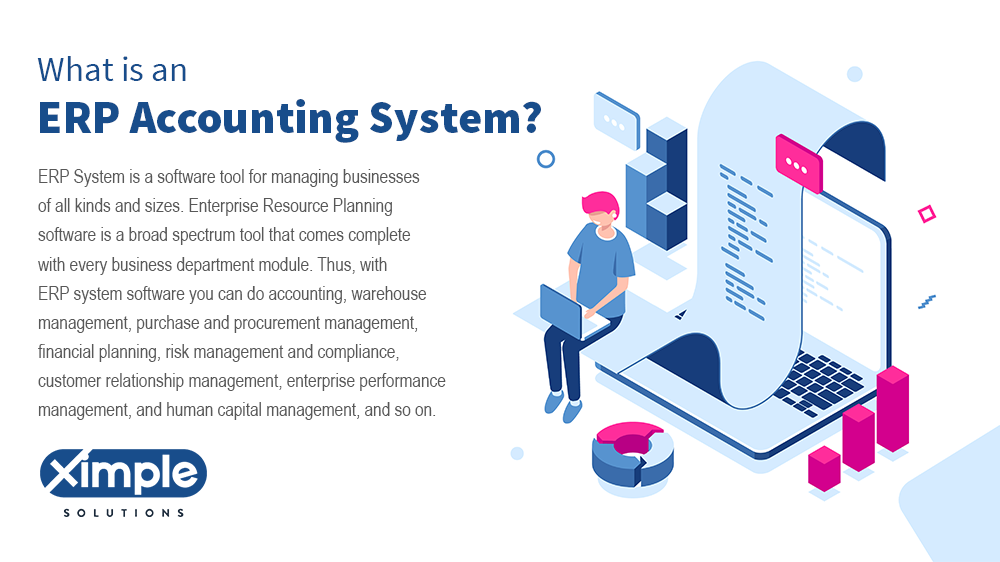

What is an Accounting System definition?
Every business needs accounting software; wholesale distributors are no exception. It is designed to simplify bookkeeping and accounting tasks. This computer software helps an accountant record and report the financial transactions of the business. Examples of this software are Ximple ERP Accounting system for wholesale distributors niche, FreshBooks, Xero, NetSuite ERP, QuickBooks Online, Tradogram, Sage Business Cloud Accounting, etc. A simple accounting software platform will feature the Expense Principle, Objectivity Principle, Matching Principle, Cost Principle, and Revenue Principle.
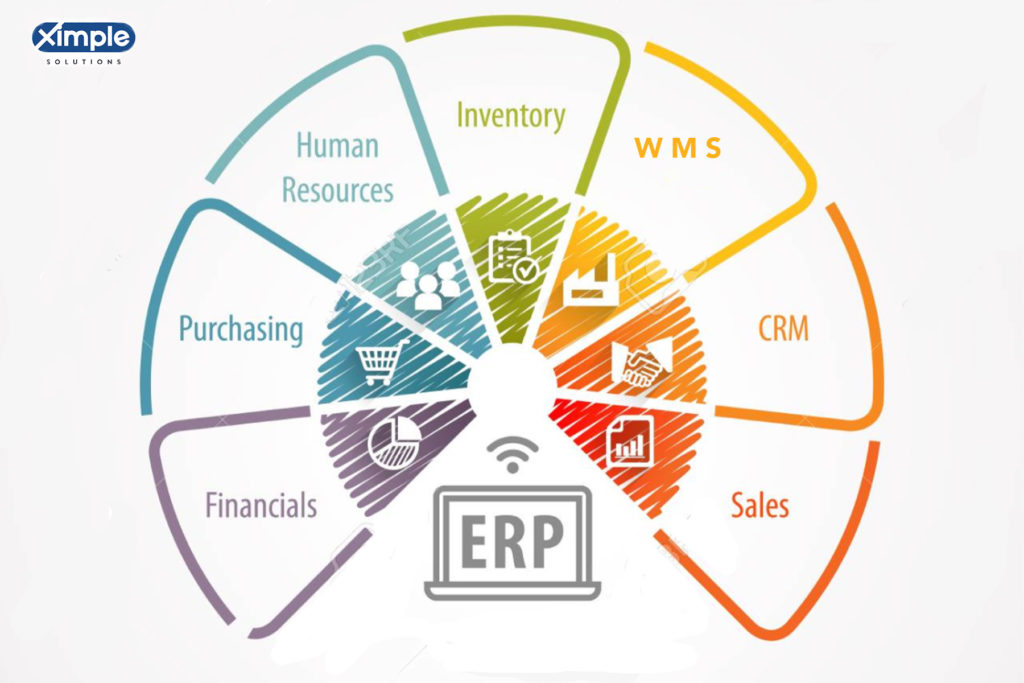

ERP accounting system definition
ERP accounting system has a more prominent role to play as compared to an accounting software tool. The latter is a standalone software program that can carry out all business accounting and financial activities. On the other hand, ERP accounting solutions are just a module within a software product that can manage all companies as a single platform. Instead of having one platform that does only accounting and bookkeeping, you can implement an ERP package with this function and more.
The key feature of ERP accounting system
ERP and accounting software should have several features to be considered helpful. These are:
- Internet function – This is to ensure electronic transfer of documents and help control fund transfers
- Encryption – The security of sensitive business data is vital, and a good ERP accounting tool should provide it.
- Automation – Ability to get rid of manual data entry and replace it with automatic data entry that reduces human labor and errors
- Updates – Constant automatic updates feature a must-have. It is a handy tool to inform the user when their tax reporting or other financial practices are due.
- Scalable – It should be an enterprise ERP with an accounting option that should be easily upgraded to include a newer version, new users, new business data or transactions, and more.
- Mobile compatible – In this era of technology, accountants and finance professionals need a software program they can monitor from anywhere anytime they want
- Bespoke – A dependable ERP accounting system should be easy to customize to meet your organization’s needs. If you want to add more capabilities, the tool should support that.
- Integration – It should be a single platform capable of sourcing transactional data from different business processes and storing it in a central location.
Benefits of ERP Accounting System
There are pronounced differences between a business with standalone accounting software and another with an ERP accounting software The latter stands a chance to perform more productively and profitably than the former. When a business runs an enterprise resource planning program with an accounting module, it can expect the following benefits:
- Easier decision-making based on accounting and financial needs An integrated software provides access to accurate and relevant business data. In line with this data, accountants and finance experts can make better budgets and allocate costs appropriately.
- No more duplicate data entry errors Consistency of data coming from various sources can be achieved through software. What’s more, identical mistakes in the data entry process can be avoided.
- Automation of workflows ERP ensures that the entire business processes are done automatically rather than mechanically. By eliminating much human labor, the software
- Create accurate and reliable financial statements Financial reporting is essential and mandatory for companies. When using ERP with an accounting and financial module, you can track financial data from across the organization and use it to generate accurate financial statements.
- Generates real-time updates As an accountant, you can benefit a lot from a software program that constantly updates you on every economic activity that happens. ERP plus an accounting package tool provides real-time updates to help you monitor, measure, and manage various things, including revenues and expenditures.
- Adequate data security. ERP in accounting information systems can ensure top data security. Suppose it is a system from a trustworthy manufacturer. In that case, it will contain a multi-layer security feature that will help you store data and require users to access it only if they are authorized. It keeps the system secure.
Key Modules of ERP Accounting Software
To understand how to use ERP accounting software, you should first know its key modules. These include the following:
- General ledger – Any accounting solution should have a general ledger. An enterprise planning program with an accounting option has it too. It is for managing all financial operations.
- Account Receivable – This has the power to show you every payment that has been made and all pending payments to simplify invoice generation.
- Account Payable – This sub-ledger shows all the monies that you are sending outside your organization. It allows you to monitor all invoices and to pay instantly for new purchases. Account Payable can stop the business from making the mistake of paying for things twice or skipping a payment date.
- Asset management – This feature is necessary when a business is big and has a lot of tangible assets and commodities. Each asset’s life cycle is easy to follow when you have an ERP accounting module with an asset management capability.
- Payroll – This one can help an accountant do computations for employees’ salaries, taxes, leave payments, travel costs, and other staff expenditures.
- Audit – Auditing is an irreplaceable and crucial accounting procedure. Thus, it would be best to have an ERP accounting module with an analytics and audit feature.
ERP Finance System
ERP finance system definition This is a module in the all-purpose Enterprise Resource Planning Software. It allows you to generate accurate financial reports and future projections for the shareholders. In most cases, it forms part of the accounting system. Thus, you will find ERP for finance and accounting on the market.
Key Features of ERP Finance System
When you go window shopping for ERP solutions make sure you select one with a finance management module. Whether combined with accounting or not, the finance application should consist of the following features:
- A profit tracker – This feature is crucial as it will reveal overall business performance in terms of profits. It will indicate precisely where most profits are arising.
- General ledger management – A financier will need it to track assets, liabilities, income and expenditures, capital expenditures, inventory management, and so on. All these in one location can simplify the detection of errors and fraudulent activities.
- Fixed asset management – This is necessary to help you control your tangible assets, calculate depreciation of assets, compute and pay taxes for existing assets, and meet your compliance requirements.
- Risk management – This tool is necessary as business operations are susceptible to all manner of risks. With this function, you can project risks and develop survival techniques to deal with actual threats.
- Reporting and analytics – This tool will provide real-time data graphs to help you make better decisions about your business money.
- Multiple currencies management – This tool will be helpful if your organization deals with worldwide operations. It will do currency conversions to help speed up various transactions in different currencies.
- Tax management – This particular tool should support tax reporting and tax auditing functions.
Benefits of ERP Finance Software
Why would you need an ERP finance module?
- It can help you generate accurate and transparent financial data for the stakeholders
- It can improve productivity by eliminating human errors that can take ages to correct
- You can enhance budgeting and forecasting through analytics and reporting tools.
- Enjoy continuous financial monitoring as monetary transactions happen
- Minimal data entry errors can save much time, a resource you need in other areas of your business
- Enjoy continuous financial monitoring as monetary transactions happen
- You can avoid missing payments through the accounts payable tool
- You can avoid losing money via the accounts receivable tool
- You can track what’s happening in every business section as financial accounting ERP is an integrated system. Just check the General Ledger
How to select the right Accounting and Finance Software?
The right software for accounting and finance can be easy to select if you know the factors to consider. It would be best if you focused on the following:
- Come up with a list of the features you require in your accounting and finance software program.
- Consult your accountants and finance experts to know the features they would recommend.
- Select important add-on features. Read software descriptions to know the additional features it has. You don’t need all of these. So select wisely.
- Compare your budget vs. the actual cost of software online. Select an ERP product that suits your budget and contains the essential features.
How to implement an Accounting system?
Now you have bought a software system for your business. Next, you will carry out the onboarding process, which is all about implementation. Do the following:
- Select a suitable implementation team and have a team leader
- Get support from everyone in the organization by informing them about implementing the new software and why and seeking their feedback.
- Test the architecture of the software before rolling it out.
- Roll out the software in a controlled way. For instance, you can release it to one department first and monitor its performance. If it’s good, release it to the following department. In Short, roll it out in separate phases.
- Offer your employees enough training and tutorials so they can learn how the new system works.
- Has the system customized based on your vendors’ remarks while ensuring it still meets overall business needs
Key Difference between accounting and finance software.
The ERP accounting module will help an accountant capture daily transactional data and save it in various ledgers for easier bookkeeping and periodical release of financial statements like balance sheets and profit/loss accounts. The finance module of Erp will help the financial analyst plan, direct, monitor, organize, and control the monetary resources. They will specifically use past and current financial data to project future cash flows.
Why distributors are migrating to a Cloud-based ERP accounting system.
Cloud computing makes data and software accessible on the internet. Distributors can access it anytime they want using any internet-enabled device. As the books of accounting are maintained online, they can be accessed via a web browser or a mobile app. Distributors are ever on the move and can benefit a lot from using an ERP accounting information system that can be accessed from any place anytime. Besides, every authorized user in a distribution chain can access the accounts online.
ERP Vs Accounting Software – Major Differences
Is there a difference between accounting software and ERP? Are you better off using both separately or just the ERP? In ERP vs. accounting, ERP is helpful because it represents everything that happens everywhere in an organization. Accountants need this data to do bookkeeping and create periodic financial statements that financial analysts need during budgeting and forecasting. When using a standalone accounting system, they need to get the data personally from each department. On the other hand, if their software is a module in the ERP, they don’t have to get in touch with other department leaders to ask for data. It will be accessible to them and anyone who is authorized to use the ERP.
How does ERP help in accounting?
An ERP application is vital in accounting. It can help accountants in multiple ways, including managing payments, allocating costs to different production activities, budgeting, and estimating capital requirements and management. It eliminates manual handling of data, which reduces human errors that can be costly to remove. They can use it for tracking profits and losses as well as support invoicing and cost analysis.
Conclusion. If you are in the wholesale distribution business, you have a wide range of options to select the ideal technological platform for your ERP accounting and finance system. Most modern ERP such as Ximple ERP for Wholesale Distribution offers On-Premise and cloud-based Financial and accounting software (SaaS).
In an On-Premise Accounting and Finance system, the Customer manages both the Software and the technology infrastructure (Hardware). This level of control enables the Customer to customize the software to suit their unique accounting processes. This flexibility comes at the cost of managing the unfamiliar terrain of managing the IT infrastructure.
In a Cloud-based Accounting and Financial system, the software vendor manages, both software and hardware. The Customer can configure the Accounting and Finance Software to meet their wholesale distribution business requirements. There is limited flexibility in customizing the application to meet the unique business processes. In some cases, the Customer will need to modify their business processes to suit the operations supported by the Software vendor.
The main benefits of Cloud-based SaaS Accounting and Finance Software are reduction in cost and complexity of managing the IT Infrastructure. Irrespective of Cloud or On-premise platform, the key is to understand the critical business requirements and ensure that the Accounting and Finance system that you choose can quickly meet those requirements.
Posted on
What is ERP Consulting? How to Choose an ERP Consultant
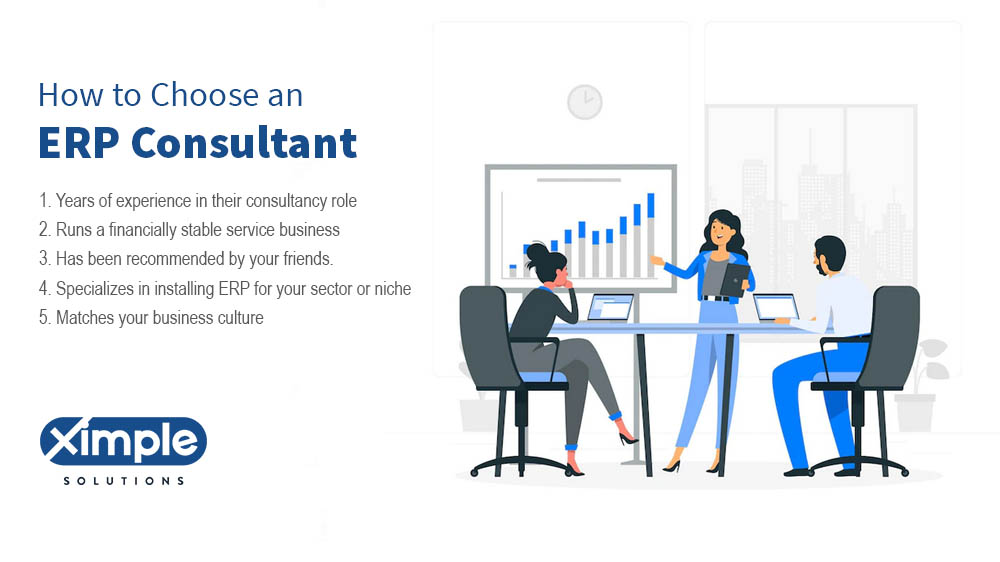

How to Select Your Ideal ERP Consulting Firm
ERP Consultant can help distributors to find the Right ERP Software. If appropriately managed, a wholesale distribution business can be very lucrative. It can grow fast and expand its operations to new regions. On the contrary, poor management of a wholesale distribution business can lead to losses that eventually cause business closure. Management can get more complicated as challenges increase. Below challenges faced by Wholesalers and distributors could be mitigated by leveraging ERP Consulting, Selecting the next generation of ERP Software, and implementing Cloud-based Platform Services:
- Massive competition from large manufacturers with the ability to do direct distribution of goods.
- Retailers who depend on wholesalers and distributors shorten their delivery dates and enforce stricter penalties on those who don’t adhere.
- Fluctuations in fuel prices are happening faster than ever before, making it hard for some distributors to cope. Wholesalers have to transport goods from point A to point B, and if the cost of fuel goes up, their overall expenditures go up as well.
- Wholesalers and distributors deal with warehousing, handling, and transportation of goods. All three roles are super sensitive as goods can get stolen or damaged, leading to losses. Moreover, system failures can offer sneaky workers a chance to pilfer some items.
Although ERP cannot eliminate an issue like changing fuel prices, it can improve your management role. As it is an all-encompassing tool, you can get real-time views of what’s happening in various departments: Accounting and finance, inventory management, warehouse management, sales and marketing, and project management, among others. As a result, you can avoid costly human errors as well as cope with unscrupulous workers.
Table of Contents
- ERP Consultant: What does ERP Consultant do
- ERP Consulting Needs for a Distribution business?
- How to Choose an ERP consultant for your distribution business?
- ERP Consulting can help distributors to find the Right ERP Software
- How much does ERP consulting cost?
- ERP upgrade consulting.
- Legacy ERP migration consulting
- Distribution ERP Consulting
- Conclusion.
ERP Consultant: What does an ERP Consultant do types of ERP Consultants…Functional consultant, technical consultant, Qualifications, experience, and benefits
What does an ERP consultant do exactly? An ERP consultant plays several roles. Their primary role is to conduct thorough research and suggest solutions to help improve the business’s operations that have hired them. Other duties include:
- Helping organizations select the best ERP software tools
- Assisting companies to implement and start using ERP systems
- Helping businesses using legacy software systems upgrade to ERP solutions.
- Assisting a company’s technical team in dealing with change management
- Working with ERP software systems.
Independent ERP consultants carry out different tasks when hired or outsourced. They are competent in other areas and come in two categories. These are:
Functional consultants
A functional consultant is also referred to as a business consultant. Their level of qualification is higher as far as understanding ERP software systems. Their functional knowledge is broad enough to help teams implement new ERP software, migrate from an older system to new ERP software or upgrade an existing ERP system. They understand how various business processes work together between different modules and can get your business the most suitable solution.
So far, you know the leading ERP functional consultant roles and responsibilities.
Technical Consultant
This professional is different from an ERP professional in that they are trained to offer technical support. They are the ones you need to hire when your systems stop working correctly as they can figure out the cause and remove it. Besides eliminating bugs and other glitches, an ERP techno technical consultant understands the process of installing and improving existing systems’ technical aspects. They are requested to install new ERPs or rectify old ones by different businesses with varied approaches and roles, and they can do it.
If you are going to select an ERP consultant, decide on the type you want first. Then check their qualifications to determine if they are fit for your business. Things to look for are:
- Top-notch listening and communication skills
- Ability to teach flawlessly
- Writing creativity and precision.
- Thorough technical skills and knowledge
- Industry-specific qualifications
- Excellent social skills
- Strong analytical skills
- Leadership and teamwork skills.
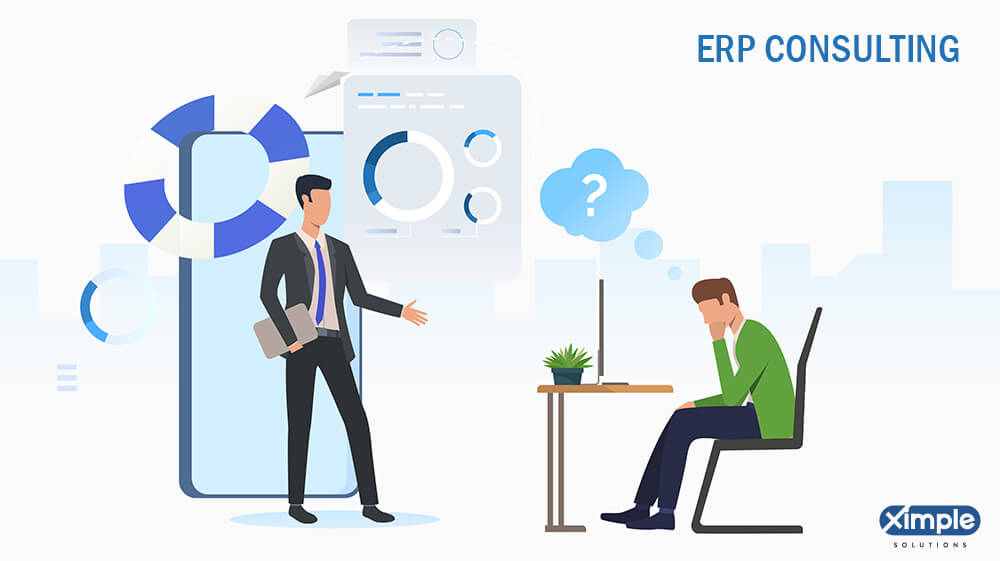

ERP Consulting Needs for a Distribution business?
Did you know that ERP consulting is critical professional to ERP implementation success?
Consultancy gurus know everything concerning ERP software and can oversee an implementation process for SMEs and large businesses. When looking for a consultant to help you, consider that they can:
- Simplify a very complicated ERP project. It is easy to get overwhelmed by an ERP project as it encompasses all areas of your organization. To stay on a budget, get a consultant to offer guidance and remove complexities from your project’s technical and functional aspects.
- Offer vast knowledge. As a small or medium-sized business struggling with business capital, you may not afford to hire a qualified ERP employee. You are the best outsourcing a third party with a strong track record and proper certification.
- Offer industry-specific ERP help. They can help with selection and implementation help.
- Help your organization reduce risks. They can do this during the ERP implementation process and help you avoid high error correction costs in the future.
- Offer consistent support. Soon after completing ERP software installation and it is up and running, a consultant can proceed to offer consistent software support.
How to Choose an ERP consultant for your distribution business?
Concerning how to choose an ERP consultant, there are a few factors to consider. The first one is the type of consultant you want. Do you need a technical or a functional consultant? As many people offer Enterprise Resource Planning (ERP) Consultant services online, you should call a few and screen them based on a selection criterion that works for your business. This criterion should be created based on overall organizational ERP needs, current business resources, and organizational culture, among other things. Ideally, you want to outsource someone with:
- Years of experience in their consultancy role
- Runs a financially stable service business
- Has been recommended by your friends.
- Specializes in installing ERP for your sector or niche
- Matches your business culture
Management Consultants
A management consultant can work with your company to enhance its performance through expert advice and problem-solving skills. Management consultants can check problematic areas and offer excellent solutions. They are an asset in guiding and advising the top management about big projects like ERP implementation projects
How ERP Consulting can help distributors find the Right ERP Software
To get software that can fulfill your business needs, hire top ERP consultants from your region or any country in the world. The outsourced professional can do the following on your behalf:
- Define and analyze your business processes, weaknesses, and strengths
- Assess your current technical infrastructure and determine if it’s ready for ERP software adoption
- Estimate the total cost of introducing the ERP software role
- Oversee employee’s change management
- Create a logical ERP implementation plan
- Measure the benefits of the new system against the metrics your business has set
- Select a software tool that is going to give your unique business competitiveness on the market.
Defining your Requirements
As with any ERP idea, the first thing to do is define your needs. Ask each functional group to list specific and measurable needs that the ERP will benefit those departments and the whole enterprise. Hold meetings and share these lists. In the end, you have to consensus on some of the requirements that the whole organization agrees on and prioritize the list and must-have items and nice to have items both shown. These requirements for your ERP are yours. Any advisors you bring help you for choose the right ERP and guide you to meet those needs by adjusting the ERP properly.
How much does ERP consulting cost?
One primary consideration that your enterprise should make before executing ERP is the ERP consultant’s salary. Mostly, the salary is counted based on the consultant’s time investment. The longer the ERP process, the more you are going to pay the consultant you will choose. Usually, consultants publish their hourly rates online. To compute the actual money you will spend, multiply the project length in months or weeks with a consultant’s hourly rate. Also, the type of consultancy you need will affect the hourly rate. For instance, an Oracle ERP technical consultant might charge a higher hourly rate than a sage consultant. The location of your consultant matters too. For example, an outsourced ERP expert from India may have a lower hourly rate than a company offering ERP consulting in USA services.
ERP upgrade consulting. Migration or Replacement.
Perhaps you have already established a properly running ERP software system. Now you want to update it so that missing things can be added and wrong items can be removed. You can plan your upgrades as a preventative measure, and therefore you will do them voluntarily. This can be beneficial because errors that were about to happen could be found and solved. New software modules can be added. Another way is to conduct involuntary upgrades and, in this case, have no other choice. A severe problem must occur before a forced upgrade, also called a forced upgrade. For instance, your software provider might withdraw their support service for an older system and force you to upgrade. Either way, you will need the assistance of the best ERP consultant.
Legacy ERP migration consulting
Do you own a legacy software system? If so, you should update the system with the assistance of a consultant. They will assist with the migration of data from your legacy system to a modern cloud-based ERP system. Their work will entail the following duties:
- Data migration from your old legacy system to the new ERP system
- Assess your current infrastructure and suggest ways to make it ready for a cloud-based solution
- Oversee change management to ensure that employees adapt themselves quickly to the new solution
- Carry out the entire customization work to ensure the newly shifted system works flawlessly
- Provide resilient support during the migration process.
Distribution ERP Consulting
Distributors endure unique challenges, especially if they have many distribution channels. With a perfectly integrated ERP software tool, they can optimize their supply chains and overall operations. To know the best software to select, then select the best ERP consulting group.
It will identify, create, and implement an ERP solution that will meet all your predetermined business needs.
Conclusion
We sincerely believe and hope that you have learned something about ERP consultancy from us. When the time to install new ERP software, upgrade existing ERP software, or shift from a legacy system to a new ERP system comes, you will know to locate the best software consultant for your organization.
Ximple has the expertise to facilitate digital transformation in the Global Wholesale Distribution business. Our experienced Distribution ERP consultants can complement your internal IT Staff by replacing or migrating Legacy ERP Software with a modern Cloud-based ERP system. Ximple team can help you evaluate technological options available in the market, offer innovative software solutions, and suggest ways to drive productivity reduce inventory, and stay competitive.
Posted on
9 Key ERP Implementation Phases and Methodology
It’s important to know the ERP Implementation Phases because nowadays COVID pandemic has accelerated Digitization, Digitalization, and Digital Transformation plans for many Wholesale Distributors. Wholesale Distributors have suddenly understood that Technology can improve efficiencies, and reduce inventory and profitability. Technology no longer looks esoteric.
The last ten years have seen many technologies and ideas mature from the Proof of Concept (POC) phase to become ‘Industry Ready.’ Technologies like Artificial Intelligence, Remote Collaboration, Machine Learning, Robotics Process Automation, Industrial IoT, and Blockchain have demonstrated their value to the early adopters who made these technologies a part of their day-to-day activities. The information and intelligence provided by these technologies have added value to the adopters.
As Wholesale Distributors get ready to implement Industry 4.0 technologies, it’s essential to upgrade or migrate their Legacy ERP to Cloud-based ERP. Next-Generation Cloud ERP offers distributors many challenges and opportunities. Technological decision markers need to understand ERP implementation processes. Here, we take the opportunity to clarify all concepts related to “ERP Implementation.”
Table of Contents
- What is ERP implementation?
- ERP implementation Phases
- ERP Implementation Methodology.
- ERP Implementation Benefits
- ERP implementation Cost
- ERP implementation Guide in Distribution industry considerations for large distributors implementing a New ERP software
- Considerations for small and medium distributors implementing a New ERP software
- How to Avoid failures in ERP implementation Phases
- Guide for Successful ERP implementation
- Conclusion
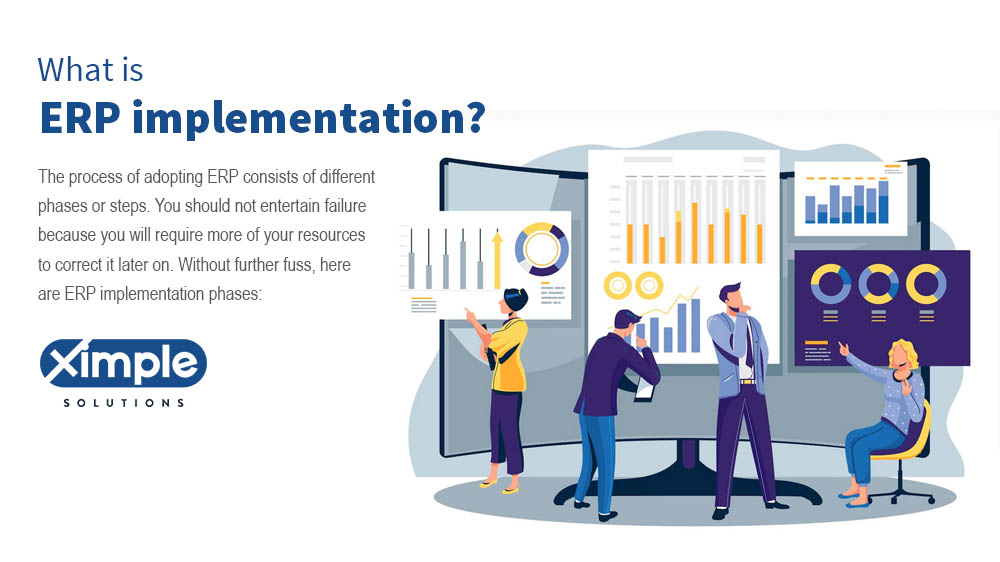

What are ERP Implementation Phases?
First, ERP refers to Enterprise Resource Planning. It is business software for automating various business departments. There are industry-specific ERP software versions. Once you decide to obtain this software, go for an Industry-specific ERP tool. For instance, choose distributor ERP software if you do distribution business. After locating the best software provider, the next big step is implementation. It is the process of installing software, configuring options and settings,
and migrating data from your old software systems to the newly launched ERP. ERP Implementation phases are fulfilled with specific methodologies.
ERP Software Implementation Phases
The process of adopting ERP consists of different phases or steps. You should not entertain failure because you will require more of your resources to correct it later on. Without further fuss, here are the ERP implementation phases:


Phase 1: Project authorization
At this point, a decision to buy ERP has been made, and it’s pending approval by the senior management. Once the CEO approves the project idea, they will ask the Chief financial officer to sign the contract. Their signature will authorize the purchase and implementation of a new software tool.
Phase 2: Official launching of the project
In this ERP Implementation Phase, the project begins officially. The company chooses the in-house team and external professionals that should oversee and carry out the entire process.
Phase 3: An analysis of actual requirements from the ERP
In this step, the team responsible for the entire term the process would take identifies the things the software should help the business do.
At the end of this phase, the team should already have an official report or document that requires approval and signed by top management.
Phase 4: The new software design is agreed upon
After gathering all the requirements, the next thing is to customize the software to ensure it meets every need. Sloppiness in this step is one reason why ERP implementations fail. This role is played by the expert developer you chose in Phase 2. They must choose the most suitable type of programming to do to meet the requested needs. The in-house team leader will then alert the top management about the developer’s decision for their approval.
Phase 5: The new software is configured
This refers to the actual installation and configuration of the software. This step requires software engineers to slot in the software for every requested need. The developers should create some of the most crucial documents for your company, including a purchase order form.
Phase 6: Testing the software after setting it up
User acceptance testing (UAT) is a very critical stage of a successful ERP implementation process. The software has been designed, installed, and configured to suit organizational needs. The UAT phase is imperative because it entails test-running the software. Testers should be selected carefully, and some of them should be IT professionals. Please don’t make the mistake of choosing novices as they will miss some essential software errors or viruses. This will cost you a lot of time and money to repair later on.
Phase 7: Training your employees
After the testing phase is over and everything looks great, the next thing to do is train your employees. They will be using the software, and it makes sense to orientate them at this point. Staff that play a role in distributing goods should be trained to use the new software tool.
Phase 8: Software integration and migration
If you have other software tools on your premises, they should be able to work harmoniously with your newly installed ERP. This step may also be done in phase 3. It is all about pinpointing software tools that can be migrated to the ERP system. Data migration will entail shifting the organization’s data from the old system to the new ERP software. Data can be shipping orders, customer forms, accounting data, sales reports, and so on.
Phase 9: Launch your New ERP system
Everything has been done by now, including project management. The software is ready to go live. This phase is super important as it marks the beginning of better performance and higher efficiency in every department. The software implementation team should hang around for a while to help employees get used to using the new software.
ERP Implementation Methodology
If your ERP execution process fails the first time you try it, many resources will be wasted. It will take your business a lot of time to recover the lost capital. To prevent this, choose the best ERP implementation approaches. The main ones are 3:
Phased methodology
In this one, a developer focuses on executing software in phases. They choose one phase or department and shift all their attention to it. Once they finish with that one, they select the following department. This approach can make the implementation procedure longer than necessary but pose fewer risks and enable quick correction of errors. It also provides the team experience it would need in the subsequent phases.
Parallel methodology
In this one, developers implement the new ERP software while letting the older ones run. This parallel approach reduces implementation risks as a critical issue arises, and the business can continue running its older software system. A similar approach is associated with technical complexities and high costs.
Big Bang methodology
Developers deploy software for the whole organization at once. Unlike the other two methodologies, the Big Bang ERP implementation approach allows developers to deploy the tool across business departments or functions. This is the most complicated methodology and requires adequate planning and expert guidance to avoid costly mistakes. It is, however, the best when you need to save deployment time and overall cost.
ERP Implementation Benefits
There are several advantages you can get from implementing ERP software. They are briefly outlined next:
- Once installed and configured, ERP will get rid of repetitive procedures and boost efficiency.
- ERP can make every department more productive by automating tasks that need a lot of human time and labor.
- ERP software is customizable. It can be altered to suit specific business needs.
- The tool can remove administration and operation costs.
- It is scalable.
- Enables collaboration between departments
- Company data is kept in a single centralized database.
ERP implementation Cost
There is no standard ERP system implementation cost for every business. This is because every business is unique and has its own needs. To discover these needs and budget for them, come up with a plan. There are two pricing models too, and each can influence the overall cost. These are:
On-premise system or perpetual licensing model
our business will host the new ERP tool on its servers. If yours is a large business, the on-premise system is the best pick as you already have servers and other essential infrastructures. With this, the license is yours totally and forever. The initial setup cost will be hefty, though.
The Saas (Cloud ERP) subscription model
Also called a cloud-based system, this model is the best for small and medium-sized businesses. The software will be paid for in small installments every month and will never be yours. However, you can use it flawlessly and safely as it is cloud-based. It is the cheapest to implement of the two.
ERP in the Distribution industry
The first thing that the wholesale distributor ERP software could do to your business is to keep it ahead of the competition. Once you automate your distribution function, it will become more efficient and reliable. Goods will arrive at the desired destinations quickly, satisfying all customers. Distribution software encompasses all areas of your business, allowing you to have a single platform that meets everyone’s needs. When it comes to choosing ERP implementation types, you should be guided by your operations’ size and the amount of capital you have. If you are already a large business and can take a considerable risk, choose the Big Bang deployment method. Otherwise, the most advisable approach is the phased methodology.
Considerations for small and medium distributors implementing a New ERP software
As a small and medium business, your new ERP should help streamline and improve your operations. As your budget is tight, you can make mistakes when selecting and implementing your ERP tool. Your employees are few and might not have adequate IT expertise to supervise an ERP implementation process flow. So you need to outsource the role to a third-party expert to help you come up with a good implementation plan and team.
How to Avoid failures in ERP implementation Phases
Next, find out how to avoid failure while implementing new ERP software:
- Get top management’s approval and consistent support to avoid wasting business resources.
- There are three principal ERP execution methodologies. Select one based on your preparedness to take risks to resist the failure of the whole process.
- Waiting to test-run a finished process and correcting errors when they are too costly to get rid of should be avoided. Correct in the course of the lengthy process.
- Plan for long-term needs as ERP implementation is an expensive procedure to repeat all over again.
Successful ERP implementation
If you want to do a successful process, follow the simple steps listed next:
- Define the scope, needs, and vision of ERP software. Use a team of experts.
- Choose a complete application developer for the installation phase
- Select your application analysts very carefully as they are the ones responsible for successful data migration.
- Use a quality assurance testing engineer for the User Acceptance Testing phase.
- Initiate change management so carefully to help the employees accept change. It would be best if you used training tools that work.
- Select a methodology that suits your business type, size, and financial stability.
- Offer ongoing support to ensure the implementation process ends well.
Conclusion
During the implementation of an ERP software program, wholesale distributors should aim for excellence. Errors should be avoided entirely as they are expensive and time-consuming to correct after the software goes live. If necessary, outsource the task to the right team of experts if you are a small company with less experience and few IT experts to keep problems in implementing ERP systems away.
Posted on
Distributor ERP Selection Guide
This article on “Distributor ERP Selection” is meant for wholesaler-distributors and large to mid-sized distribution businesses who are looking to adopt the next generation of Distributor ERP and other related technologies to improve efficiency, increase revenue, and reduce costs. The article covers topics such as what is a distributor ERP system, why it is needed, its benefits, considerations for selecting an ERP software, and cost. It is also useful for those in charge of handling inventory, warehousing, and logistics.
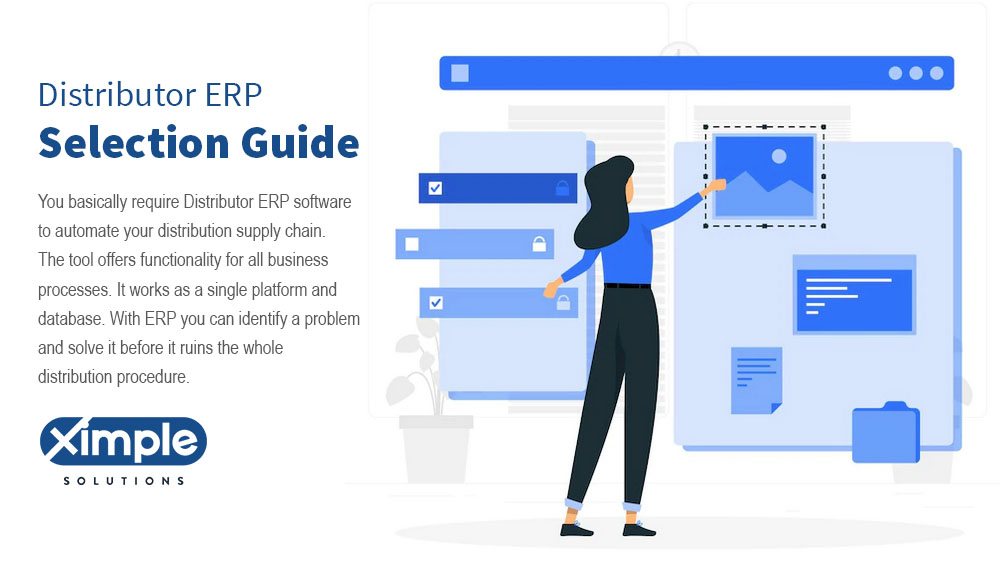

The digital revolution has changed the Wholesale distributor’s Business. Now, Wholesale Distributors are evaluating ways to adopt the Next generation of Distributor ERP and other related Technology faster.
Over the last ten years, many new technologies have come out of the labs and have become ‘Wholesale Distribution Industry Ready.’ Good examples of emerging technologies are artificial intelligence, Blockchain, machine learning, cloud computing, the Industrial Internet of Things, and robotics process automation.
These technologies offer value propositions that Customers cannot ignore anymore. Organizations are designing their Digital Transformation strategies that will provide the technology roadmap for the future. Besides technological innovation has demonstrated that Technology is scalable and mobility is real, and both of them help increase revenue, reduce costs, and improve efficiencies. Also, the market for new technologies will explode over the coming years. In the next five years, it is estimated that the growth of the global cloud computing market will have doubled.
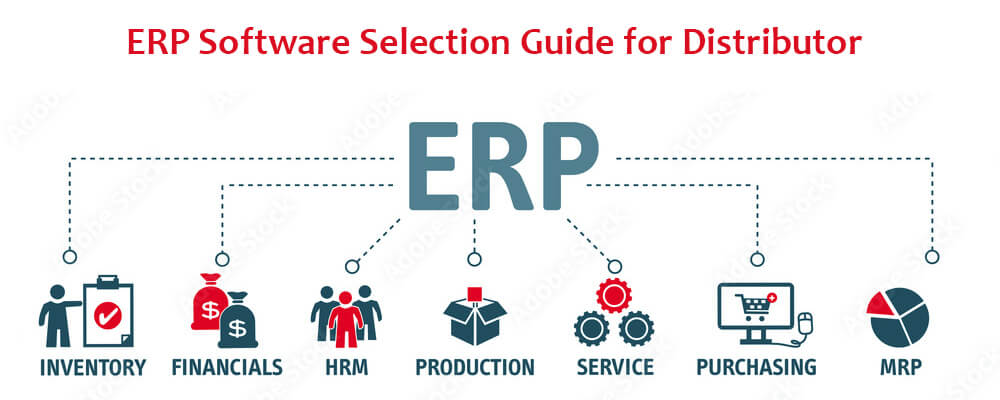

Table of Contents
- What is Distribution in a business?
- What is a Distributor ERP System?
- Who exactly needs distributor ERP?
- Why do We Need an ERP System for Distribution?
- What are the primary Business Benefits of an ERP System for Distributors?
- Consideration for large distributors choosing a New ERP Software
- Consideration for small and medium Distributors choosing New ERP
- Characteristics and Features of ERP
- How can you assess the best distributor ERP?
- What is the cost of distributor ERP?
- How can you build an ERP Selection Budget?
- Conclusion
What is Distribution in a Business?
Among the most important business processes is distribution. A business can either choose direct or indirect distribution channels. Channels connect the manufacturer and the end consumer. Direct distribution, also called zero-level, is the shortest and quickest channel as consumers get goods directly from the manufacturer. Indirect distribution entails intermediaries like wholesalers, distributors, agents, and retailers. It is not just long but complicated too. This is why you need distributor ERP software and get familiar with ERP selection.
What is a Distributor ERP System?
This software is a special tool for handling all your distribution activities. As a distributor, you will make more money if you satisfy your customers by delivering their goods on time. Without thorough tracking of everything that happens throughout your distribution supply chain, an error could occur. A single error that is not discovered early could delay the whole shipment and cause customer dissatisfaction. That’s when distributor ERP becomes a handy tool.
Besides automating every activity in a distribution channel, the software can make you look and feel like a professional. Software is a sure way to increase the speed and efficiency of your distribution service. You can handle large orders with ease no matter their frequency.
Who exactly needs distributor ERP Software?
A distributor ERP system is meant for any person who is in charge of handling inventory, warehousing, and/or logistics. The one who fits this description well is a wholesale distributor. It also suits large retail chain stores and retail shops. While it is largely preferred by those who handle logistics, this software is all-encompassing and can meet the needs of those responsible for warehousing, accounting, sales and marketing, project management, and inventory management. All you need to know are the ERP selection steps.
Why do We Need an ERP System for Distribution?
You basically require Distributor ERP software to automate your distribution supply chain. The tool offers functionality for all business processes. It works as a single platform and database. With ERP you can identify a problem and solve it before it ruins the whole distribution procedure. Any issue can arise, including your delivery truck developing a mechanical problem a flat tire, or skipping an important delivery date. With software, this cannot happen as it’s going to send an alert every time there is an issue. If you don’t know how to select a new ERP system, continue to read this guide as this can save you thousands of dollars later on.
What are the primary Business Benefits of a distributor ERP System?
If you are a distributor looking to enhance your distribution service, you need ERP software. But, why are ERP systems worth their cost? These systems can be extremely beneficial if selected wisely. They can offer these advantages:
- Creates a central repository system that handles every process and task in the distribution process.
- Boosts customer satisfaction and ensures that their confidential information is stored safely in a central database.
- It can quicken the tasks done by your sales force, logistics team, warehousing team, accountants, as well as other people taking part in the distribution of goods.
- It creates reliable financial reports that managers can use to track the performance and success of their distribution channels.
- It can get rid of data errors and repetition. Your distribution channels involve different activities and processes. If you handle them with a single ERP software tool, you can eliminate erroneous data.
- This can lead to revenue growth. If your indirect distribution channels run effectively, it means that everyone including the final consumer will be happy with your service. When customers are happy, they will order more and spread the word about your business. This can translate to higher sales. What’s more, the software can help you manage different resources in a cost-effective manner and this will reduce loopholes through which you can lose money.
- Better stock management. As a distributor, your job entails ordering goods in bulk from a manufacturer, keeping them in a warehouse, and distributing them to various customers as soon as an opportunity comes. When you track your inventory with software, you can see what you ordered, how much stock is left, and when you need to replenish your stock. The software can ensure that no delivery dates are missed because of a lack of stock.
Consideration for large distributors choosing a New ERP Software Package
Are you a large-scale distributor? If so, your business is complex and has bigger legal requirements than an SME(small and medium enterprise). Maybe you already have global operations or are planning to start them. When it comes to how to successfully select a Distributor ERP system, you have to be vigilant and thorough.
The entire process of obtaining and implementing software should take at least a whole year. This being a complex process, you should consult an expert who can help you select and implement software. As for the features, consider standard features and industry-specific features. Standard features must include:
- HCM or Human Capital Management
- Financial Management
- Customer Relationship Management or CRM and Sales Force Automation(SFA)
- Supply Chain Management or SCM
- Contract Management, Document Management
- Material Requirements Planning, Distribution Requirements Planning, and Capacity Requirements Planning
- Enterprise Asset Management, EAM
- BAM(Business activity monitoring)
- Business Intelligence or BI
- Enterprise Performance Management(EPM)
Lastly, your software should be easy to merge with existing enterprise software tools like QuickBooks.
Consideration for small and medium Distributors choosing New ERP Software
As a small or medium business, your ERP software requirements are manageable. You are the only owner and boss. There are several software tools that are designed with your type of business in mind. The essential thing to focus on is how to select the correct ERP system. Consider:
- Available resources – SMEs are known to have financial struggles. If you are not stable yet, you may not implement ERP software at this point. Alternatively, you should select a simpler ERP system that could suit your current budget.
- Features – As an SME that is seeking growth via the assistance of ERP, you should buy a system with helpful features. At the very least, it should have financial management, inventory management, sales orders, and analytics features.
It is necessary to involve your entire staff in decision-making processes concerning the selection and implementation of ERP.
Characteristics and Features of ERP
Regarding features and characteristics, make sure that your favorite software has all you require to simplify your distribution procedure. Usually, most people search for the following ERP software features:
1) Sales order management
The software should support sales functions like sales order processing, sales order inquiry, sales order reporting, shipping management, customer pricing, self-services for vendors and customers, and return policy among others.
2) Financial management
You should know how to select a Distributor ERP package that supports financial management activities. It should be a tool that accountants can use to do accounts payable, accounts receivable, budget forecasting, financial reporting, debt management, order billing and invoicing, asset management, payroll management, and more.
3) Customer relationship management
A good distributor ERP gathers necessary customer data and stores it in a safe database for future retrieval. The CRM feature it should support promotion management, contact management, sales force management, quotes and estimates management, inquiry management, and so on.
4) Warehouse management
Functions relating to warehouse management can range from picking procedures to demand correlation, shipping management, tagging functions, multiple warehousing, outbound processes, and slotting optimizations among others.
5) Inventory management
Another feature to recall when considering how to select Distributor ERP solutions is inventory management. As your customers don’t expect to miss an item they want, then make sure to select software with an inventory management feature. This feature should support various things, including inventory and stocking costs, requirement planning, demand forecasting, and inventory availability among other things.
6) The Procurement management
As a distributor, you need ERP Selection software that can offer you full procurement capabilities such as purchase management, vendor management, purchase orders, bid management, procurement planning, and multiple warehousing among other processes.
7) eCommerce for distributors
As a distributor, you are involved or will soon be involved in B2B eCommerce. When that time comes, you will require eCommerce for distributors, which is a type of software. This will help you connect with other buyers better. Instead of buying a single software tool that does just one thing, you should know how to select the right ERP software for your business. Distributor ERP will have an eCommerce for distribution function and all the above; so, it is cost-effective and dependable.
How can you assess the best distributor ERP?
One thing you will discover when searching and selecting ERP software for your business is that there are several options. To ensure that you end up selecting the right tool, you should carry out an assessment of each in a sensible way. Here is how:
- Create selection criteria for ERP by writing a list of ERP needs for every department you have in the organization.
- Assess your workflows to further understand what will be required by everyone so as to select an ERP that can address every need.
- If you need professional advice or help, call an ERP provider you have been thinking of buying the software from. You can even invite them to come over and have a talk with your entire team.
- If the consulted ERP provider is able to, ask them to demonstrate how their software can transform your distribution channels for the better.
- Assess your team’s training needs and the process of implementing software. This is to know if you need to consult outside helpers or can do it in-house.
ERP Software Selection Criteria
When it comes to the selection of ERP software, you should consider different criteria. These are:
- Business goals and needs
- Business expansion and growth goals
- Redundant areas of your business that can be replaced with software
- Marketing goals
- Current technology and scalability plans in the future
- Your budget and resources as you want to be totally sure that you can afford ERP
- Your in-house technical team to help with software installation and assess if an outside consultancy will be required.
What is the cost of the distributor ERP System?
As you decide the best ERP to get for your distribution business, focus on the cost. After all, you can only get the software you can afford with your current finances. The cost is so important that you should fully understand this: how much does it cost to implement an ERP system? To compute the total cost of obtaining your ERP, consider these factors:
- Who will have to use this too and how many are they?
- Do you get several orders daily or do you need more marketing effort to attain this?
- The cost of the software itself and the licensing fee
- Cost of implementation
- Extra customization cost
- Maintenance cost
- Upgrading cost
- Employee training cost
- Cost of obtaining support
How can you build an ERP budget?
You are about to buy new ERP software and this is great. However, are you aware of how you can control your overall business expenditures in the next few months or years? This will be difficult, but this is how to budget for it:
- Assess the overall cost of obtaining software once again.
- Assess the ERP’s cost savings in the long run.
- Do you have any cash-flow issues now? If not, can you project one in the near future? You are doing this to decide if borrowing is an option.
- Involve management in deciding if your budget deserves approval. If it is approved, then publish it for all to peruse.
- Once you begin spending, revisit the budget plan to see if your estimations and actual costs tally. There will also be planned activities that happen later than estimated. Perhaps you had planned to borrow but got a windfall and don’t require a loan anymore. All these changes should be made to the budget.
- Keep updating your budget as you experience actual costs as this data will be needed by accountants and financiers at the end of the accounting year.
- Finalize and review your budget when you successfully implement your ERP software.
If you don’t know where to begin, you can get an ERP budget template online as it will simplify the process.
ERP Selection Guide FAQ
1. How are ERP packages selected?
Choosing the best ERP package does not have to be complicated. If you make a logical ERP checklist, you will get the most appropriate software for your brand. In your checklist, include the following features or modules:
- Warehousing
- Accounting and finance
- Inventory control
- Sales and order management
- Purchase order processing
- Business Intelligence
- Project management automation
- Customer relationships management
- Supply chain management
- Human capital management
- Product pricing and updates
- Shipping.
2. How do I start deciding on an ERP?
You might not know where to begin if you do not have any Enterprise Resource Planning tool. Therefore, we can advise you to study your business first. Does it have issues that are affecting its profitability and scalability? More factors to guide your selection process include:
- Current software solutions – Are your existing software tools outdated, or has your business outgrown them
- Future goals – Companies have long-term goals they plan to achieve via software like ERP. Perhaps you are looking to integrate your current software with other applications. Maybe your customers want something you cannot provide until you have a cloud ERP. Could it be that you need to expand and adopt new technologies?
- Your industry needs – Many ERP products exist. Some packages may work for your industry, and others cannot. So, consider an industry-specific software tool that can grow with advancing technology.
- Installation ease and pricing – ERP software is a significant investment. Your company should prepare adequately for it, including creating a budget. Additionally, consider training costs for your technical team and the role the software provider should play.
- Return on Investment – How will the company benefit from implementing a new ERP tool? Estimate the return on investment figure that you can later compare with the actual profits.
3. What are some key things to learn from Successful ERP Selection?
Successful ERP selection and implementation is everyone’s goal, But are there things to learn from the process? We would say there are, and they include the following:
- Success comes from within the organization – Getting support from executive managers, employees, customers, and other stakeholders is the first step. Make sure people are on the same page before selecting the right ERP software.
- You must select your implementation team wisely- Employees already know how your company works and what it needs to succeed. Thus, do not skip your best-performing workers when selecting your ERP and implementation team. They should be critical decision-makers.
- You must define the project scope well – If you define your project scope well, it is likely to succeed and provide massive benefits. Include all project requirements, tasks, budget, steps, deadlines, etc.
- It would help if you managed change – A single ERP implementation job can change how workers do their work. They might not like the shift unless you provide training. Also, consider the training costs you might incur in the process.
- ERP implementation tools – If you want to select and implement a cloud ERP solution, you might consider some free tools for simplifying the task. These include Amazon Web Services, Microsoft Corporation Azure, and Google Cloud. Also, consider the cloud service that best suits your business.
Conclusion
ERP systems are crucial for the success of wholesale distribution businesses. They offer a range of features that streamline operations, improve customer relationships, and provide cost-effective solutions. Selecting the right ERP is key and there are several approaches to making the best choice. The next decade holds great potential for the Wholesale Distributor ERP market, with the rise of digital transformation and other driving factors. Ximple Cloud ERP is well-positioned to help leading distributors as stay ahead of the competition, achieve business growth, and increase margins.
Posted on
IBM AS400 ERP SOFTWARE
This article provides an overview of IBM AS400 ERP & IBM I software and its evolution over time. It covers the history of AS400, its benefits, challenges, and compatibility with various accounting and business software. It also touches upon the reasons for the migration of AS400 to cloud-based ERP and the benefits of API, microservices, Java, and Angular technology. The article is intended for those who are interested in learning about IBM AS400 ERP software and its evolution to cloud-based ERP.
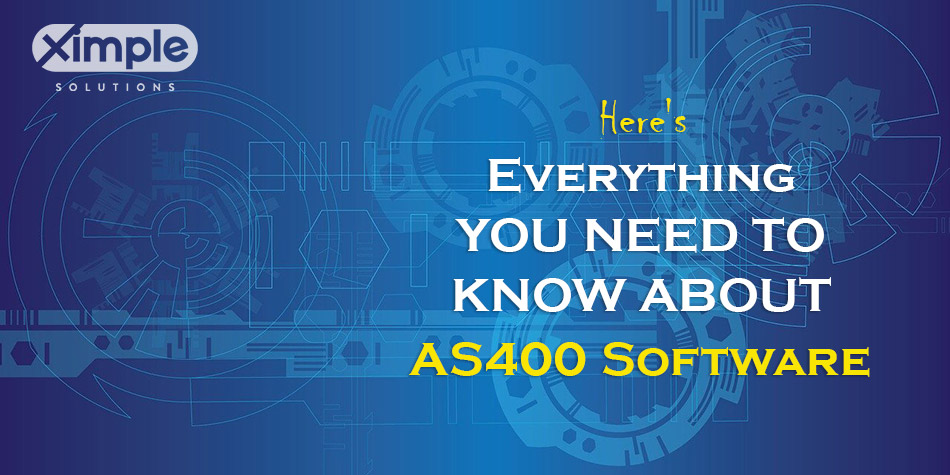

Table of Contents
- What is AS400 Software?
- What is IBM As400 ERP? – History, Benefits and Challenges
- Benefits of AS400 ERP
- Challenges
- List of Major AS400 ERP, Accounting and Business Software
- IS IBM AS400 ERP?
- What’s different between legacy Software vs Next Generation of ERP
- What’s ERP upgrade processes Checklist?
- What are ERP upgrade benefits?
- Why Major Distributors are migrating AS400 ERP to Cloud ERP
- What’s the benefits of APIs, microservices, Java and Angular Technology AS400 ERP?
- How ERP Consultants can facilitate easy ERP migration
What is AS400 Software?
AS400 Software is a mid-range server from IBM. Developed in 1988, the AS400 iSeries is a foundation product that more than one hundred thousand businesses use today. Although the AS400 Software System is not the most powerful software today, it matches the needs of several businesses. Don’t get confused if you also come across words like IBMi, iSeries, or System i. They all refer to the same thing. IBM recognizes all these names and uses them for branding campaigns only.
The operating system, OS400, also changed names over the years. If you come across the i5/OS, or eServer i5 term, the person is talking about OS400. The IBMi system includes a combination of an interactive AS400 System database, networking, security, internet services, and storage management abilities. The main uses for the AS400 system are Java application development, web and e-commerce hosting, and data warehousing.
What is IBM As400 ERP? – History, Benefits and Challenges
History
IBM designed the AS400 about 33 years ago. The system was an integrated product featuring hardware and an operating system (software). The hardware was AS400 while the OS was OS400. Over the years, IBM upgraded the hardware and software to keep their mid-range product offering competitive. They also branded and renamed their product to align with the market and their offering. Currently, the hardware is officially called Power Systems and it runs an upgraded OS known as IBM i. The best-selling feature of the as400 system is its capacity to match with different applications.
Despite being old, the system is compatible with various applications, including AS400 inventory management and accounting software. This means that you can run a program made for the original AS400 on a current Power Systems server without necessarily changing anything. Even with the notion that the system is outdated, several companies continue to use it due to this seamless compatibility. IBM habitually upgrades and improves its platform every two to three years. Here is a summary of its history:
1988
AS400 system line with OS/400. All programs written for System/34 and System/36 could be shifted to the new AS400. System/34 and 36 were part of the company’s first line of minicomputers launched in 1979 that also included System/3 and System/32
2000
IBM renamed the AS400 System as iSeries
2006
IBM renamed iSeries to IBM System i
2008
IBM consolidated System I and System P product lines and rebranded the merged product offering as IBM Power System.
Benefits of AS400 ERP
Although it is a computer server that was made years ago, the iSeries computer is not dead yet. It has the following benefits:
- Scalability – Your business can buy the most affordable core server and upgrade to a stronger 256-core later on.
- Reliability – If you are looking for a server that can offer close to 100 percent uptime, AS400 is the best.
- Secure – As long as you have your IBMi configured properly it will work safely.
- Sophisticated – As this is a regularly updated server, it has become more modern and supports various programming languages, including RPG and Java among others.
- Compatibility – As earlier explained, System I offers amazing compatibility, allowing easier transitions.
Challenges
Although featuring excellent technology, i5 system has its own challenges:
- Some users have the wrong perception about it. They think that AS400 Software is obsolete and not worth buying. This doesn’t seem right as when it comes to compatibility it is excellent. This is why most companies cannot get enough of it.
- People who founded and understand the IBMi better are now old and as they retire, they will go with the entire pot of knowledge and expertise they own. Although it may seem old, the system has complicated internal architecture. To prepare your staff, have them read AS400 Software learning guides and practice with dummies.
List of Major AS400 ERP, Accounting, and Business Software
The Accounting and Business software tools that run on IBMi servers include the following:
Accounting
- Ximple ERP for Wholesale Distributor
- American Software Enterprise
- Financial Accounting Software from Arkansas Data Services
- Compu-tech’s Accounting Software
- Gammasoft Executive Series
- iSeries Financials from Global Software
- HarrisData ERP Applications
- Infor Enterprise Financial Management
- Infor Infinium FMS
- Infor Lawson Financial Management
- Core information system or CIS
- CIS-LAMP
- Mosaic21 Financial Accounting Software
- NGS Concert Series Financial Software
- JD EDWARDS World Financial Management from Oracle
- Integra
- Financial Portrait Software System from Tegratecs
- Unit4 Financials
- Online Business Accounting from Legler Systems Company
- MasterTools by Online Computing
- Open Systems Accounting Software
- S5 financial Accounting System from Sentinel Hill Software
- DS90 (iSeries) Accounting Software
- First Option IBM I (iSeries) Financials from the First Option
- Visual AccountMate/400 version 4.0 (VAM/400) from AccountMate Software Corp.
IS IBM AS400 ERP?
No IBM AS400 is not ERP even though many novice users call it AS400 Enterprise Resource Planning Software. Think of AS400 as an operating system that works as perfectly as Microsoft Windows or Linux. The difference between other operations OS and AS400 Systems is everything in AS400 is defined as an object while other operating systems have files. Windows and Linux understand hardware and software items as files rather than objects. IBM AS400 or IBM iSeries platform is an integrated platform that includes IBM DB/400 databases, hardware, programming & software development environment, and OS/400 operating system. Many mission-critical business applications and ERP run on this platform. Leading retailers, distributors, manufacturing and financial institutes uses AS400 for business application as it offers stability, reliability, high performance, and security.
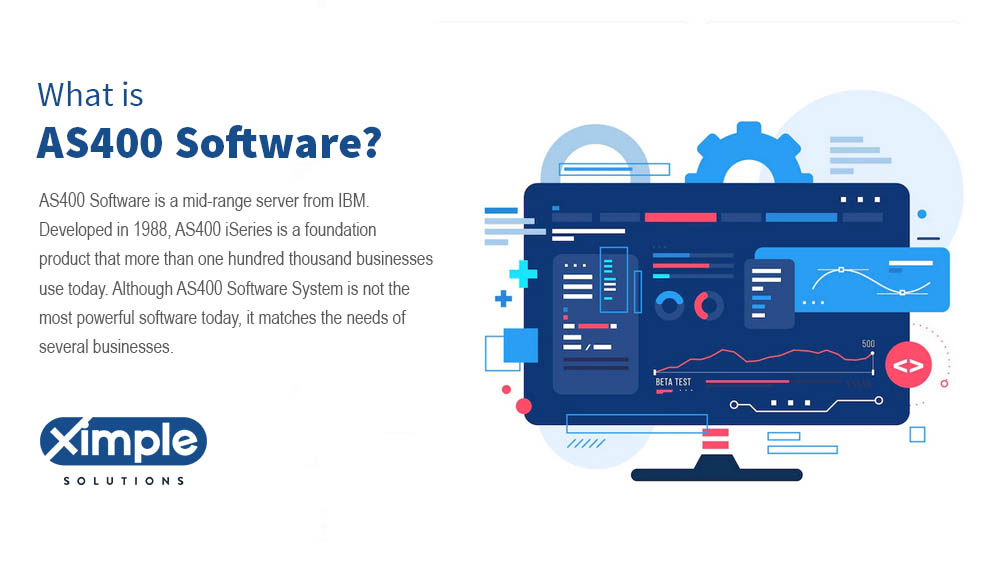

What’s different between legacy Software vs Next Generation of ERP
Legacy software systems are offline ERPs. That’s why they are called on-premise ERP systems. On the other hand, the next generation of ERP refers to cloud-based enterprise Resource Planning tools. When comparing the two, you need to pinpoint the differences. These are:
- The difference between Legacy ERP and Cloud ERP, the latter offers ease of access. With legacy ERPs, you, the owner, have to lease and maintain them live on your computers or servers. Thus, anyone authorized to use them can only access them on your machines. Conversely, next-generation ERPs are stored on an internet server that you either own or lease monthly. One needs only web browsers such as Safari, Chrome, and Edge to access the system.
- Next Generation ERPs have foundations for the future. It has an open architecture for future technologies such as the Internet of Things (IoT), Machine learning, Artificial intelligence, big-data analytics, and cloud computing. ERP has core functionalities deeply defined to the vertical industries it serves. Such ERPs are SaaS-based, commonly known as Software as a Service. It means that you have to pay a subscription fee to have permission to use the software and hardware it operates on. As it is based on installment payments, your business has to incur an operating cost. On the other hand, legacy ERPs belong to the company that runs them. The software and hardware parts have to be bought upfront, giving the buyer full rights to both. This is where software development consulting firms come in. They are cheaper than a team of in-house IT staff requiring salaries every month.
- The cloud-based new generation ERP systems are easier to customize and update. The user can make changes automatically. On the other hand, on-premise, legacy ERPs are difficult to alter and update unless your IT team knows what it is doing. If you don’t have a dependable IT team, you had better use a freelance software developer consultant.
- Any internet-enabled device can be used to access a new generation ERP system as all you need is a web browser. Conversely, legacy ERP is only reachable via a computer in your office.
Related articles
What’s the ERP upgrade processes Checklist?
Software migration does not have to be difficult. Here is a checklist:
- Come up with a plan to help you do the software upgrade.
- Make a shortlist of ERP consultants who can help you.
- Select a consult based on their budgets, their track record, and their ability to deliver on time.
- Create a team to oversee the upgrade process. This team will become the link between your organization and the selected consultancy firm.
- Implement the plan you created in the first step with your consultant’s assistance.
What are ERP upgrade benefits?
If you are using a legacy ERP system, it is important to upgrade it to get all the benefits that those who use the cloud-based new generation ERP receive. It is extremely important to upgrade to the latest version to get regular software updates, new features, service packs, and more in real time. An updated system will perform optimally and reduce your workers’ downtime. An upgraded system fosters speed when doing daily tasks and complies with government regulations like ISO, HIPPA, ACA, and IFRS among others. As you upgrade to Cloud-based ERP from IBM AS 400 ERP, it’s important to avoid any business disruptions.
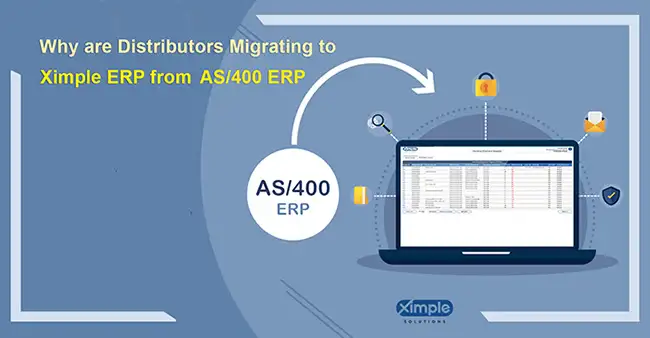

Why Major Distributors are migrating AS400 ERP to Cloud ERP
These companies have realized that AS400 ERP is a good system but with a legacy syndrome. Once you have it you will only access it on your in-house computers or servers. It is harder to update while on the move, unlike the latest IBM iSeries version for the web. That’s why most organizations are looking to upgrade their AS 400 ERP to Cloud ERP. A good consultant knows how to combine the best capabilities of System I with those of modern software.
What are the benefits of APIs, microservices, Java, and Angular Technology AS400 ERP?
Software consulting and development entails two kinds of architecture. One of these is microservices and the other is monolithic. The former is favored because it is more modern. In this architecture method, a single big application is split into tiny modular services. Agility and scalability are achievable when every small modular service assists a specified business goal. One code can be reused for a fresh implementation.
Lightweight APIs can be used to facilitate communication between modules. Microservices will enable a seamless integration process when moving from an on-premise system to a cloud-based ERP system. Java, Angular, React, Node, PHP, and many other programming languages could be used to implement Microservices & API architecture to modernize ERPs. They are easy to read especially when working with complex systems and Jave EE standards match the microservices’ application like JAX-RS for APIs.
How ERP Consultants can facilitate easy ERP migration
- Consultants will first evaluate the current status of your ERP systems to determine where your legacy ERP needs changes.
- Find ways to transition smoothly while considering your company’s needs and goals. Technological leaders have a dilemma upgrade to a new version of existing ERP software or migrate to a new ERP. If you intend to put the foundation for years to come, then migration to new Cloud-ERP works better than legacy ERP.
- Plan in advance to minimize interruptions. The migration process should the thorough and undisrupted.
- Take care to prevent the risk of producing errors or losing data during migration.
- Building a strong relationship with consultants and ERP vendors is a must. Both partners need to be customer-centric to avail of world-class support during and after the ERP migration.
Conclusion
In conclusion, IBM AS400 Software, also known as IBMi, iSeries, and System i, is a mid-range server that has been in use for over three decades. Despite its age, it remains a popular option among businesses due to its scalability, reliability, security, sophistication, and compatibility with different applications. However, it also faces some challenges, such as a negative perception among some users and a shortage of experts with deep knowledge of the system. The system offers compatibility with various programming languages and supports several ERP, accounting, and business software applications. The Ximple ERP is one of the leading cloud-based ERP solutions for wholesale distribution.
Now, many modern cloud technologies are accessibly leveraging this IBM platform including Micro-services, API, RHEL Openshift, supports Open-source, with a wide range of programming languages such as Java, Angular, Node.js, PHP, C++, C, and many more. It ideal platform for private, public, and hybrid cloud offering great security, scalability, and reliability apart from being cost-effective. Almost everything is possible on this platform, you limited by your imagination and competency
Related articles
Posted on
Upgrade your EPICOR ECLIPSE & Prophet 21 ERP with Ximple ERP
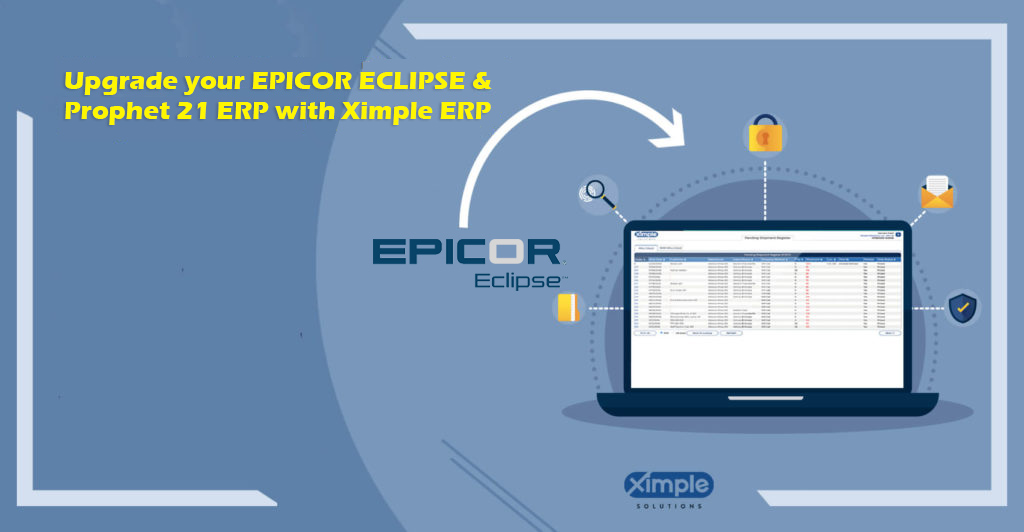

Here, we will show you data migration steps for replacing EPICOR ECLIPSE ERP Software with Next Generation Cloud based Ximple ERP Software.
Table of Contents
-
How to upgrade EPICOR ECLIPSE & Prophet 21 ERP system to Ximple Distribution ERP?
- 1. Analyze Epicor Eclipse & & Prophet 21 ERP Data Migration to Ximple ERP Project
- 2. Review your Epicor Eclipse/Prophet 21 ERP Data and Processes
- 3. Assign the Right People for Epicor Eclipse/Prophet 21 ERP Replacement Project
- 4. Remember that time is of the Essence for your Epicor Eclipse/Prophet 21 ERP Upgrade to Ximple Cloud ERP
- 5. Test Ximple Cloud-ERP and Fix Issues if Needed
- Make Epicor Eclipse ERP/Prophet 21 Migration Success.
- Final Words to Epicor’s Eclipse/Prophet 21 Erp Users
How to upgrade EPICOR ECLIPSE & Prophet 21 ERP system to Ximple Distribution ERP?
- We have expertise and knowledge of ECLIPSE ERP. Our experts can help you upgrade to our Next Generation Ximple ERP Software.
- ECLIPSE ERP upgrade to Cloud-based Ximple ERP is a multi-layered, involved endeavor that must be carefully planned and managed. One of the critical layers is migrating your ECLIPSE ERP data to the Ximple SaaS ERP system.
- Many wholesale distributors make the mistake of assigning very little importance to this data migration essential task. As a result, they either end up scrambling at the last minute to resolve data display issues or end up with a frustrating implementation mess altogether.
- There are, however, steps you can take that will help you make sure the ECLIPSE ERP data migration process proceeds without glitches and gets completed in as short a time frame as possible.
- Data migration is the process of organizing, restructuring, copying, and migrating data from your ECLIPSE ERP systems to Ximple ERP Software
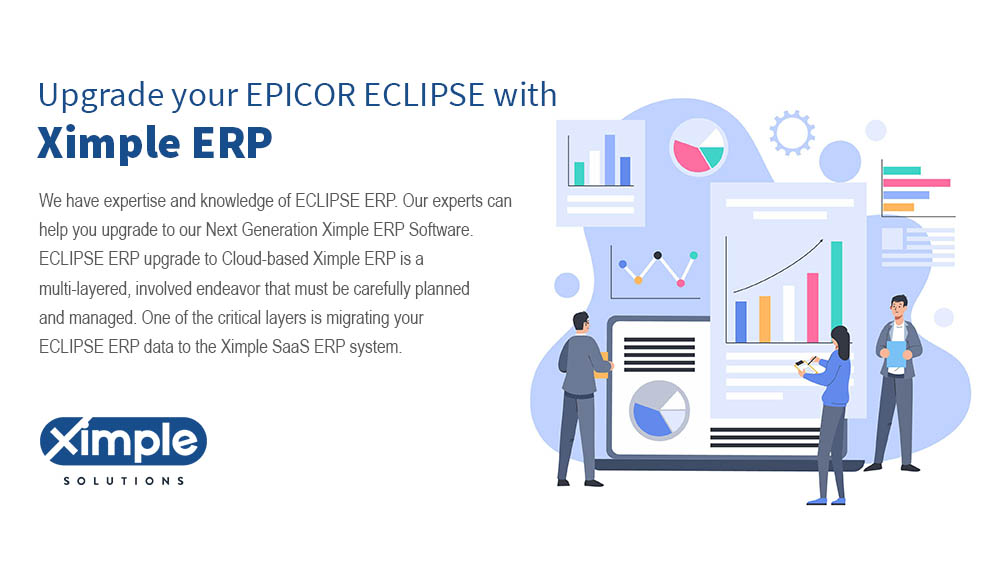

1. Analyze Epicor Eclipse & & Prophet 21 ERP Data Migration to Ximple ERP Project
- Analyzing your ECLIPSE ERP data way ahead of the actual migration is a crucial step. You know that your business deals with different kinds of data.
- Master data – the core data that is essential for the operation of your business processes. It is a consistent set of attributes and identifiers that describes your company’s different entities, e.g., customers, products, suppliers, chart of accounts, etc.
- Historical data – collected data that is over many years.
- Live/current data – all of your recent transactional data. So before you let our ERP consultant embark on data migration, you first need to make some decisions about these data types.
- This can be a tricky and complicated process. If your employees had been inputting data into your ECLIPSE ERP using standardized processes all along, then that’s excellent news. If, however, they had created their ways of data entry at some point or another, it may open the door to a whole new set of complications.
You have to define things like,
- What data has to be migrated first.
- When the data should be migrated, either close or after the Go-live date.
- Which historical data has to be migrated to the Ximple Wholesale Distribution ERP system.
- The levels of access to users of the data.
- Hence it is imperative to overlook the planning and strategizing portion of the data migration to avoid unpleasant and frustrating complications.
2. Review your Epicor Eclipse/Prophet 21 ERP Data and Processes
- You have to assess whether you need all the data in the Ximple Wholesale Distribution ERP or not. Before migrating your data from your ECLIPSE ERP to the Ximple ERP system. You have to do some spring cleaning.
- Review your data and decide on its quality. This is the perfect opportunity to rethink or reassess the ways to record data.
- You may also want to consider changing your processes and asking the Ximple ERP implementation partner for recommendations on the stored data structure.
- You have to assess whether you need all that data in the Ximple Wholesale Distribution ERP. This is the time to clean up irrelevant information, inaccurate data, and duplication.
- In the end, you should have organized, consistent data categories ready to be migrated to the Ximple Wholesale Distribution Cloud ERP.
3. Assign the Right People for Epicor Eclipse/Prophet 21 ERP Replacement Project
- Apart from ensuring that the Ximple ERP implementation partner is thoroughly briefed with ECLIPSE ERP data before they begin the migration process, an essential success factor for this project is assigning an in-house team or employee that will superhead the process.
- Ideally, these people should be long-term company employees who are well versed in the company background and its history with legacy systems.
- These employees can surf your company to extract and organize that data into structured charts.
- You, in turn, will rest assured that you have trusted people that will make sure to keep pushing the data migration forward until everything is successfully entered the Ximple Wholesale Distribution ERP.
4. Remember that time is of the Essence for your Epicor Eclipse/Prophet 21 ERP Upgrade to Ximple Cloud ERP
- The way you map out your data migration processes is crucial. It would help if you had a clearly defined timeline that reflects the types of data, the amount of data, the necessary changes to be made, etc.
- Do make sure to have contingency plans for delays – unforeseen issues are more likely to arise than not.


5. Test Ximple Cloud-ERP and Fix Issues if Needed
To make sure that everything goes correctly and according to plan, follow the following testing procedure :
- First, take a small amount of test data from your current ECLIPSE ERP.
- Make sure that it loads correctly to Ximple ERP.
- Check how the Ximple ERP is handling the data, take the feedback.
- Your key users should then take the Ximple Wholesale Distribution ERP for a test drive. Simulating their daily business processes and running rigorous tests on the system. This is the crucial step in catching problems and tracking them early.
Make Epicor Eclipse ERP/Prophet 21 Migration Success. Upgrade to Ximple Next Generation ERP for Wholesale Distribution with confidence :
Ximple Offers SaaS-based Cloud ERP software to Leading Wholesale Distributors. It severs ERP needs for Electrical Wholesale Distributors, Automotive Distributors, HVAC wholesalers, Plumbing distributors, Fasteners Distributors, Industrial Distributors, Hose and Fittings Distributors, Construction Distributors, Electronics Distributors, Pharmaceuticals Distributors, Chemical Distributors, Cosmetic Chemical Distributors, Power Transmissions & Bearing Distributors, Clothing Distributors & Convenience Store Distributors.
Final Words to Epicor’s Eclipse/Prophet 21 Erp Wholesale Distributors Software Users
“Switching from ECLIPSE ERP & Prophet 21 ERP system is never easy unless you have the right partner with experience in doing similar migration. ECLIPSE ERP data migration is one of the more complicated parts of the process. Planning and defining a strategy for this ERP upgrade process will save you a headache in the future. Moreover, picking the right Cloud-based ERP for wholesale distributors is essential to set you up for success.”
Get in touch with us to see how Ximple ERP consultants can help you upgrade your ECLIPSE ERP to Next Generation ERP to grow your wholesale distribution business.
Posted on
Replace your Array Legacy ERP Software to Ximple ERP for Distributors
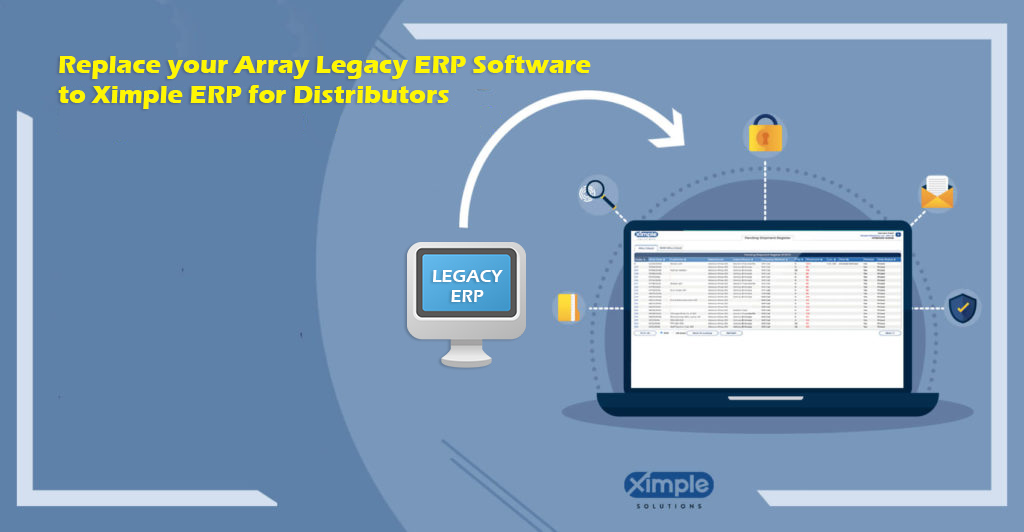

Here, we will show you data migration steps for replacing Array Legacy ERP Software with Next Generation Cloud-based Ximple ERP Software.
Table of Contents
-
How to upgrade Array Legacy ERP System with Modern Ximple ERP System?
- 1. Analyze Array Legacy ERP Data Migration to Ximple ERP Project
- 2. Review your Current Array Legacy ERP Data and Processes
- 3. Assign the Right People for Array Legacy ERP Replacement Project
- 4. Remember That Time Is of the Essence for Your Array Legacy ERP Replacement
- 5. Test Ximple Cloud-ERP and Fix Issues if Needed
- Final Words to Array Legacy Erp Wholesale Distributors Software Users
How to upgrade Array Legacy ERP System with Modern Ximple ERP System?
- How to upgrade Array Legacy ERP system? We have expertise and knowledge of Array Legacy ERP. Our experts can help you upgrade to our Next Generation Ximple ERP Software.
- Array LegacyERP upgrade to Cloud-based Ximple ERP is a multi-layered, involved endeavor that must be carefully planned and managed. One of the critical layers is migrating your Array ERP data to the Ximple SaaS ERP system.
- Many wholesale distributors make the mistake of assigning very little importance to this data migration essential task. As a result, they either end up scrambling at the last minute to resolve data display issues or end up with a frustrating implementation mess altogether.
- There are, however, steps you can take that will help you make sure the Array ERP data migration process proceeds without glitches and gets completed in as short a time frame as possible.
- Data migration is the process of organizing, restructuring, copying, and migrating data from your Array ERP systems to Ximple ERP Software
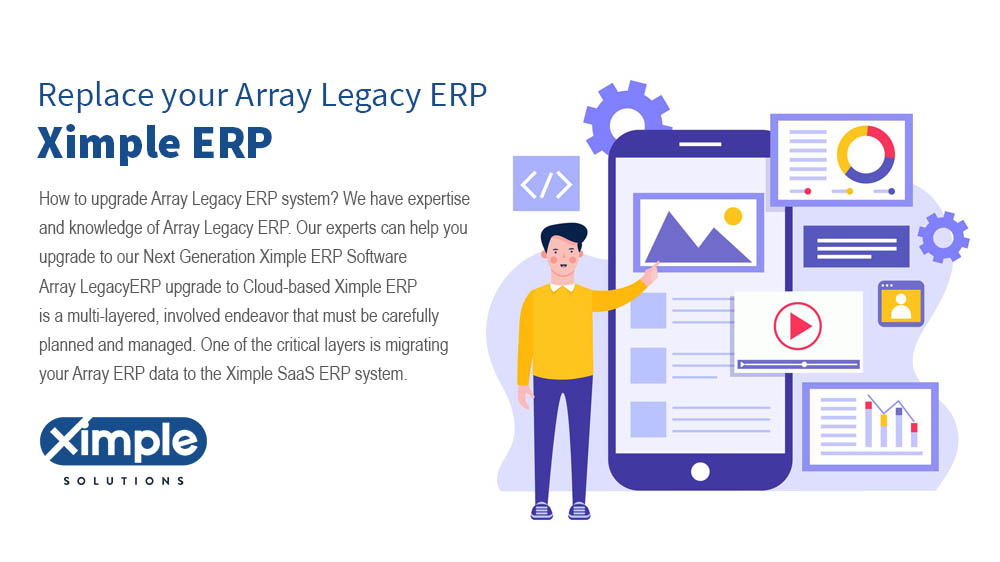

1. Analyze Array Legacy ERP Data Migration to Ximple ERP Project
- Analyzing your Array ERP data way ahead of the actual migration is a crucial step. You know that your business deals with different kinds of data.
- Master data – the core data that is essential for the operation of your business processes. It is a consistent set of attributes and identifiers that describes your company’s different entities, e.g., customers, products, suppliers, chart of accounts, etc.
- Historical data – collected data that is over many years.
- Live/current data – all of your recent transactional data. So before you let our ERP consultant embark on data migration, you first need to make some decisions about these data types.
- This can be a tricky and complicated process. If your employees had been inputting data into your Array ERP using standardized processes all along, then that’s excellent news. If, however, they had created their ways of data entry at some point or another, it may open the door to a whole new set of complications.
You have to define things like,
- What data has to be migrated first.
- When the data should be migrated, either close or after the Go-live date.
- Which historical data has to be migrated to the Ximple Wholesale Distribution ERP system.
- The levels of access to users of the data.
- Hence it is imperative to overlook the planning and strategizing portion of the data migration to avoid unpleasant and frustrating complications.
2. Review your Current Array Legacy ERP Data and Processes
- You have to assess whether you need all the data in the Ximple Wholesale Distribution ERP or not. Before migrating your data from your Array ERP to the Ximple ERP system. You have to do some spring cleaning.
- Review your data and decide on its quality. This is the perfect opportunity to rethink or reassess the ways to record data.
- You may also want to consider changing your processes and asking the Ximple ERP implementation partner for recommendations on the stored data structure.
- You have to assess whether you need all that data in the Ximple Wholesale Distribution ERP. This is the time to clean up irrelevant information, inaccurate data, and duplication.
- In the end, you should have organized, consistent data categories ready to be migrated to the Ximple Wholesale Distribution Cloud ERP.
3. Assign the Right People for Array Legacy ERP Replacement Project
- Apart from ensuring that the Ximple ERP implementation partner is thoroughly briefed with Array ERP data before they begin the migration process, an essential success factor for this project is assigning an in-house team or employee that will superhead the process.
- Ideally, these people should be long-term company employees who are well versed in the company background and its history with legacy systems.
- These employees can surf your company to extract and organize that data into structured charts.
- You, in turn, will rest assured that you have trusted people that will make sure to keep pushing the data migration forward until everything is successfully entered the Ximple Wholesale Distribution ERP.
4. Remember That Time Is of the Essence for Your Array Legacy ERP Replacement and Migration to Ximple Cloud ERP
- The way you map out your data migration processes is crucial. It would help if you had a clearly defined timeline that reflects the types of data, the amount of data, the necessary changes to be made, etc.
- Do make sure to have contingency plans for delays – unforeseen issues are more likely to arise than not.


5. Test Ximple Cloud-ERP and Fix Issues if Needed
To make sure that everything goes correctly and according to plan, follow the following testing procedure :
- First, take a small amount of test data from your current Array ERP.
- Make sure that it loads correctly to Ximple ERP.
- Check how the Ximple ERP is handling the data, take the feedback.
- Your key users should then take the Ximple Wholesale Distribution ERP for a test drive. Simulating their daily business processes and running rigorous tests on the system. This is the crucial step in catching problems and tracking them early.
Final Words to Array Legacy Erp Wholesale Distributors Software Users
“Switching from ARRAY ERP system is never easy unless you have the right partner with experience in doing similar migration. Array ERP data migration is one of the more complicated parts of the process. Planning and defining a strategy for this ERP upgrade process will save you a headache in the future. Moreover, picking the right Cloud-based ERP for wholesale distributors is essential to set you up for success.”
Get in touch with us to see how Ximple ERP consultants can help you upgrade your Array ERP to Next Generation ERP to grow your wholesale distribution business.